Civil Engineering Technology Report: Construction Safety and Methods
VerifiedAdded on 2020/03/02
|32
|12282
|457
Report
AI Summary
This report delves into various aspects of civil engineering technology, encompassing earthmoving equipment, safety protocols for deep excavations, and temporary works required for ground stability and groundwater control. It explores pile installation techniques, complex foundation construction methods, and underground construction approaches. The report also examines appropriate construction methods, the use of falsework and formwork in reinforced concrete structures, and potential construction hazards. It further addresses the legal framework of health, safety, and welfare, including the requirements of the Construction (Design and Management) (CDM) 2007 regulations and the role of the planning supervisor. Finally, it presents solutions to civil engineering problems, incorporating modern technology, green building concepts, quality control, safety measures, renewable energy, recycling, waste minimization, and alternative materials. The report also outlines safety plans for problems arising from civil engineering activities, including roles, responsibilities, and emergency procedures.
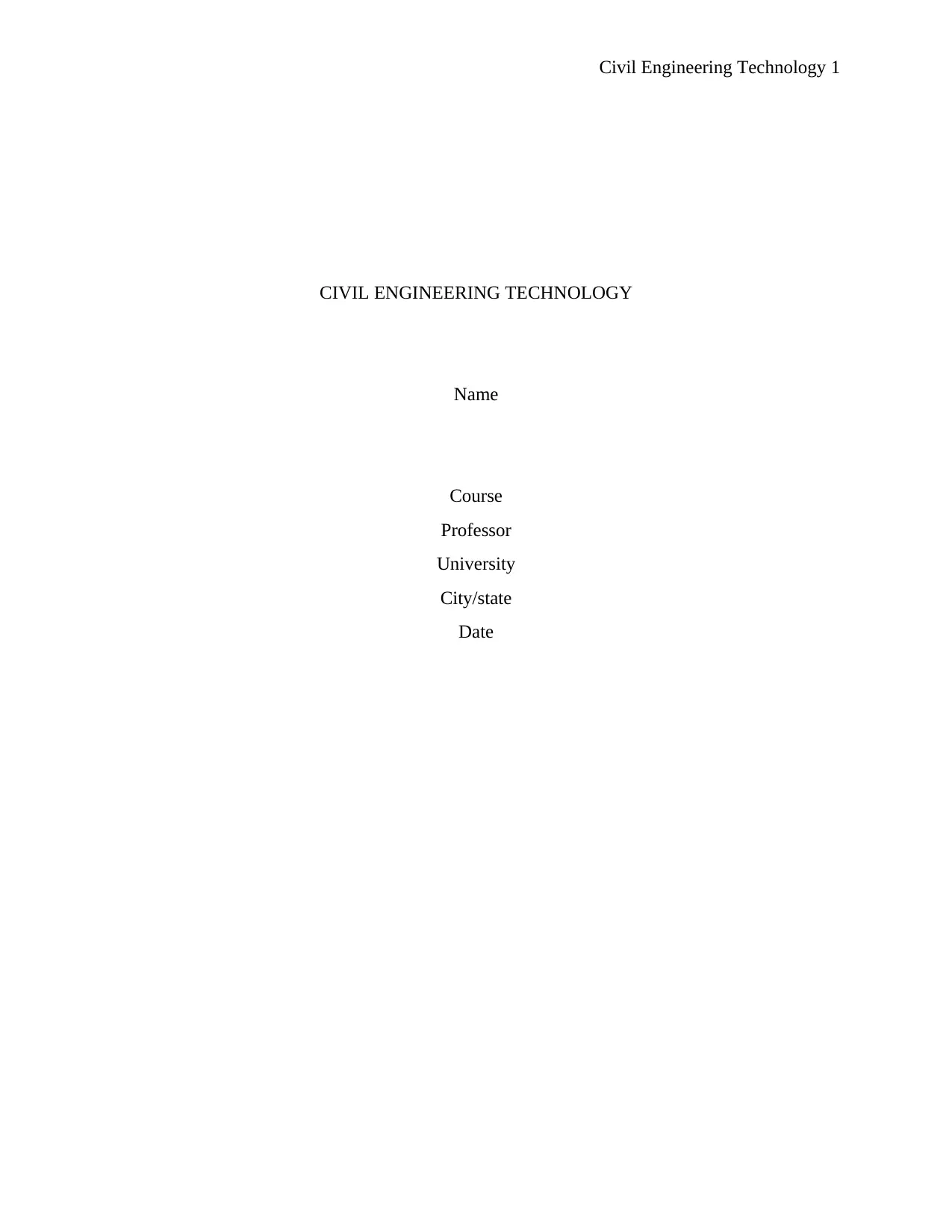
Civil Engineering Technology 1
CIVIL ENGINEERING TECHNOLOGY
Name
Course
Professor
University
City/state
Date
CIVIL ENGINEERING TECHNOLOGY
Name
Course
Professor
University
City/state
Date
Secure Best Marks with AI Grader
Need help grading? Try our AI Grader for instant feedback on your assignments.
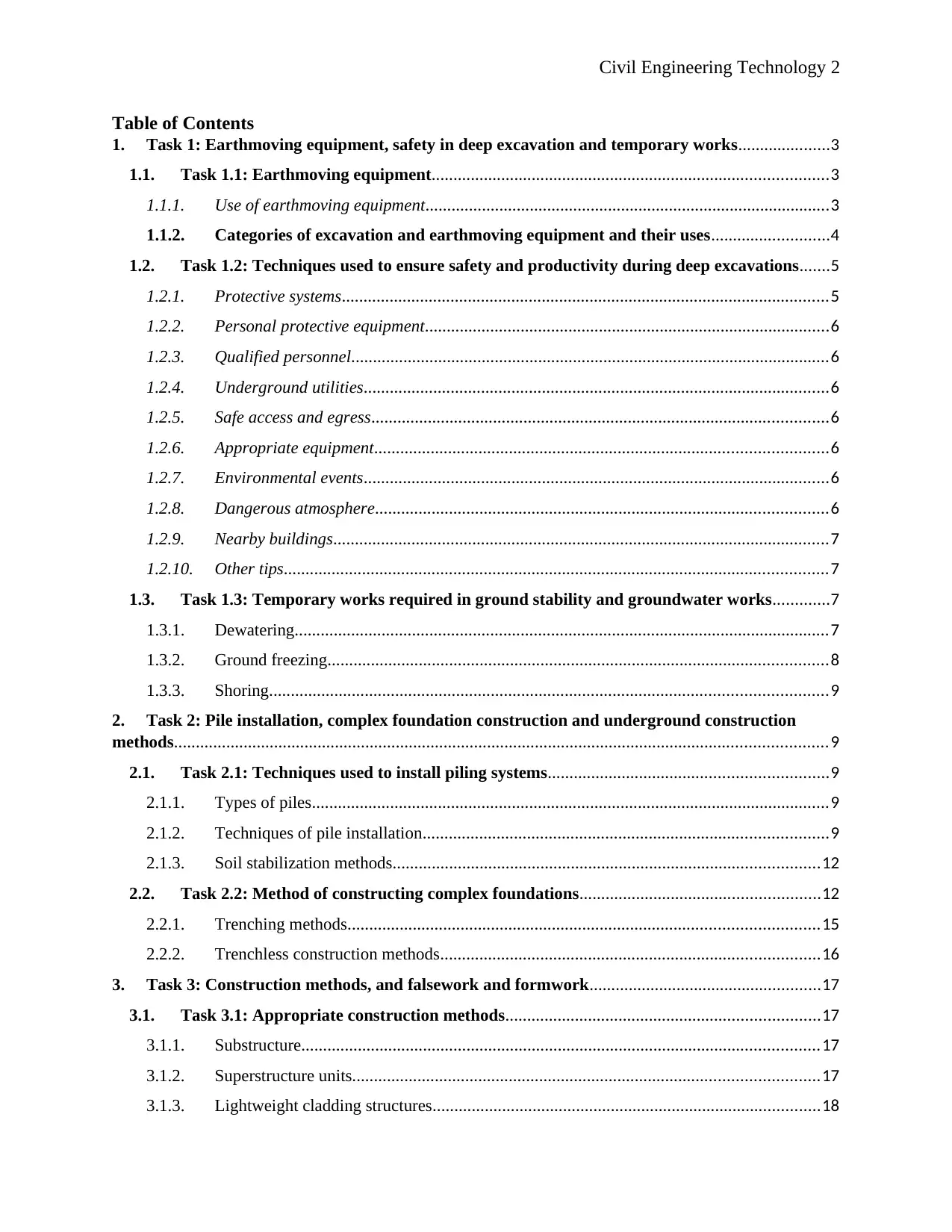
Civil Engineering Technology 2
Table of Contents
1. Task 1: Earthmoving equipment, safety in deep excavation and temporary works.....................3
1.1. Task 1.1: Earthmoving equipment...........................................................................................3
1.1.1. Use of earthmoving equipment.............................................................................................3
1.1.2. Categories of excavation and earthmoving equipment and their uses...........................4
1.2. Task 1.2: Techniques used to ensure safety and productivity during deep excavations.......5
1.2.1. Protective systems................................................................................................................5
1.2.2. Personal protective equipment.............................................................................................6
1.2.3. Qualified personnel..............................................................................................................6
1.2.4. Underground utilities...........................................................................................................6
1.2.5. Safe access and egress.........................................................................................................6
1.2.6. Appropriate equipment........................................................................................................6
1.2.7. Environmental events...........................................................................................................6
1.2.8. Dangerous atmosphere........................................................................................................6
1.2.9. Nearby buildings..................................................................................................................7
1.2.10. Other tips.............................................................................................................................7
1.3. Task 1.3: Temporary works required in ground stability and groundwater works.............7
1.3.1. Dewatering...........................................................................................................................7
1.3.2. Ground freezing...................................................................................................................8
1.3.3. Shoring................................................................................................................................9
2. Task 2: Pile installation, complex foundation construction and underground construction
methods......................................................................................................................................................9
2.1. Task 2.1: Techniques used to install piling systems................................................................9
2.1.1. Types of piles.......................................................................................................................9
2.1.2. Techniques of pile installation.............................................................................................9
2.1.3. Soil stabilization methods..................................................................................................12
2.2. Task 2.2: Method of constructing complex foundations.......................................................12
2.2.1. Trenching methods............................................................................................................15
2.2.2. Trenchless construction methods.......................................................................................16
3. Task 3: Construction methods, and falsework and formwork.....................................................17
3.1. Task 3.1: Appropriate construction methods........................................................................17
3.1.1. Substructure.......................................................................................................................17
3.1.2. Superstructure units...........................................................................................................17
3.1.3. Lightweight cladding structures.........................................................................................18
Table of Contents
1. Task 1: Earthmoving equipment, safety in deep excavation and temporary works.....................3
1.1. Task 1.1: Earthmoving equipment...........................................................................................3
1.1.1. Use of earthmoving equipment.............................................................................................3
1.1.2. Categories of excavation and earthmoving equipment and their uses...........................4
1.2. Task 1.2: Techniques used to ensure safety and productivity during deep excavations.......5
1.2.1. Protective systems................................................................................................................5
1.2.2. Personal protective equipment.............................................................................................6
1.2.3. Qualified personnel..............................................................................................................6
1.2.4. Underground utilities...........................................................................................................6
1.2.5. Safe access and egress.........................................................................................................6
1.2.6. Appropriate equipment........................................................................................................6
1.2.7. Environmental events...........................................................................................................6
1.2.8. Dangerous atmosphere........................................................................................................6
1.2.9. Nearby buildings..................................................................................................................7
1.2.10. Other tips.............................................................................................................................7
1.3. Task 1.3: Temporary works required in ground stability and groundwater works.............7
1.3.1. Dewatering...........................................................................................................................7
1.3.2. Ground freezing...................................................................................................................8
1.3.3. Shoring................................................................................................................................9
2. Task 2: Pile installation, complex foundation construction and underground construction
methods......................................................................................................................................................9
2.1. Task 2.1: Techniques used to install piling systems................................................................9
2.1.1. Types of piles.......................................................................................................................9
2.1.2. Techniques of pile installation.............................................................................................9
2.1.3. Soil stabilization methods..................................................................................................12
2.2. Task 2.2: Method of constructing complex foundations.......................................................12
2.2.1. Trenching methods............................................................................................................15
2.2.2. Trenchless construction methods.......................................................................................16
3. Task 3: Construction methods, and falsework and formwork.....................................................17
3.1. Task 3.1: Appropriate construction methods........................................................................17
3.1.1. Substructure.......................................................................................................................17
3.1.2. Superstructure units...........................................................................................................17
3.1.3. Lightweight cladding structures.........................................................................................18
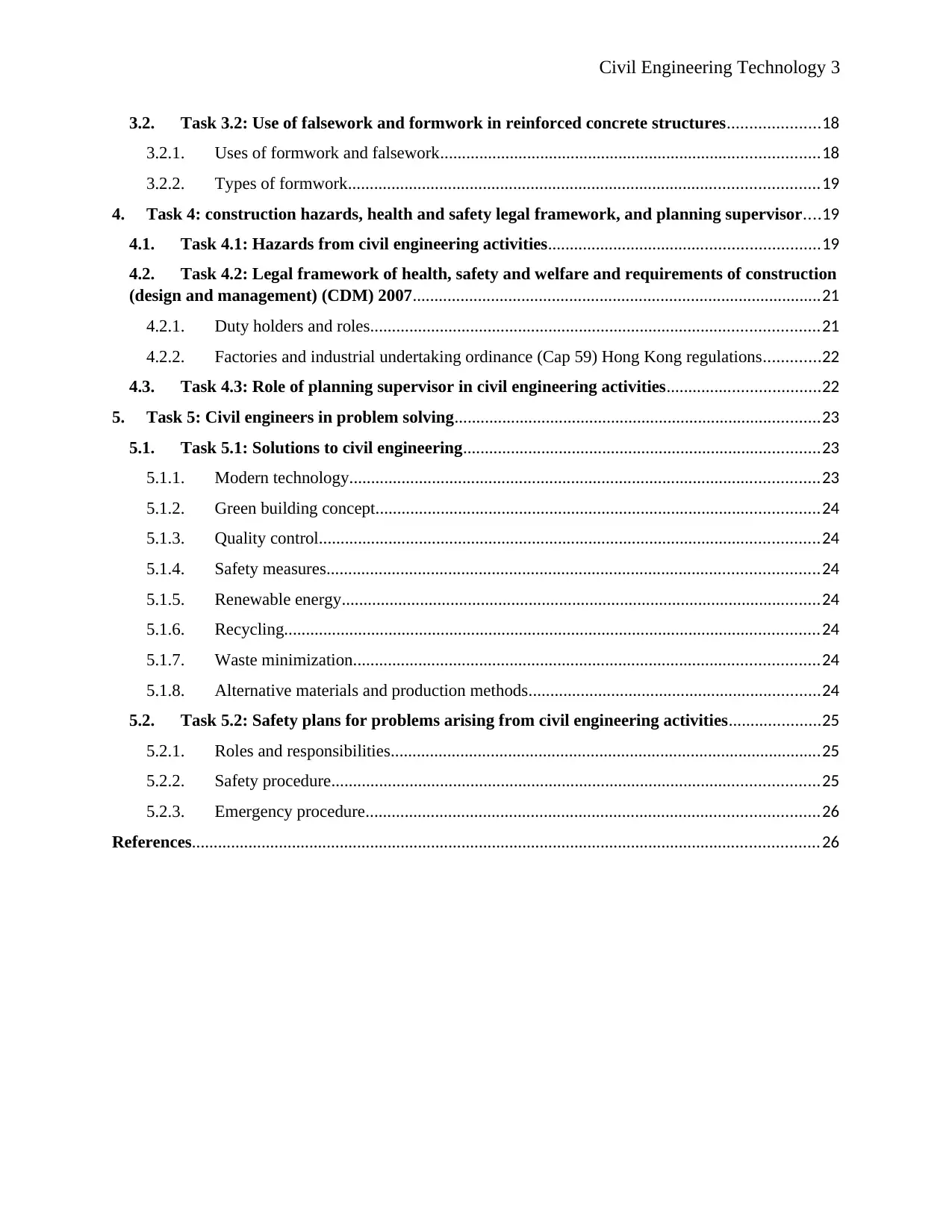
Civil Engineering Technology 3
3.2. Task 3.2: Use of falsework and formwork in reinforced concrete structures.....................18
3.2.1. Uses of formwork and falsework.......................................................................................18
3.2.2. Types of formwork............................................................................................................19
4. Task 4: construction hazards, health and safety legal framework, and planning supervisor....19
4.1. Task 4.1: Hazards from civil engineering activities..............................................................19
4.2. Task 4.2: Legal framework of health, safety and welfare and requirements of construction
(design and management) (CDM) 2007..............................................................................................21
4.2.1. Duty holders and roles.......................................................................................................21
4.2.2. Factories and industrial undertaking ordinance (Cap 59) Hong Kong regulations.............22
4.3. Task 4.3: Role of planning supervisor in civil engineering activities...................................22
5. Task 5: Civil engineers in problem solving....................................................................................23
5.1. Task 5.1: Solutions to civil engineering..................................................................................23
5.1.1. Modern technology............................................................................................................23
5.1.2. Green building concept......................................................................................................24
5.1.3. Quality control...................................................................................................................24
5.1.4. Safety measures.................................................................................................................24
5.1.5. Renewable energy..............................................................................................................24
5.1.6. Recycling...........................................................................................................................24
5.1.7. Waste minimization...........................................................................................................24
5.1.8. Alternative materials and production methods...................................................................24
5.2. Task 5.2: Safety plans for problems arising from civil engineering activities.....................25
5.2.1. Roles and responsibilities...................................................................................................25
5.2.2. Safety procedure................................................................................................................25
5.2.3. Emergency procedure........................................................................................................26
References................................................................................................................................................26
3.2. Task 3.2: Use of falsework and formwork in reinforced concrete structures.....................18
3.2.1. Uses of formwork and falsework.......................................................................................18
3.2.2. Types of formwork............................................................................................................19
4. Task 4: construction hazards, health and safety legal framework, and planning supervisor....19
4.1. Task 4.1: Hazards from civil engineering activities..............................................................19
4.2. Task 4.2: Legal framework of health, safety and welfare and requirements of construction
(design and management) (CDM) 2007..............................................................................................21
4.2.1. Duty holders and roles.......................................................................................................21
4.2.2. Factories and industrial undertaking ordinance (Cap 59) Hong Kong regulations.............22
4.3. Task 4.3: Role of planning supervisor in civil engineering activities...................................22
5. Task 5: Civil engineers in problem solving....................................................................................23
5.1. Task 5.1: Solutions to civil engineering..................................................................................23
5.1.1. Modern technology............................................................................................................23
5.1.2. Green building concept......................................................................................................24
5.1.3. Quality control...................................................................................................................24
5.1.4. Safety measures.................................................................................................................24
5.1.5. Renewable energy..............................................................................................................24
5.1.6. Recycling...........................................................................................................................24
5.1.7. Waste minimization...........................................................................................................24
5.1.8. Alternative materials and production methods...................................................................24
5.2. Task 5.2: Safety plans for problems arising from civil engineering activities.....................25
5.2.1. Roles and responsibilities...................................................................................................25
5.2.2. Safety procedure................................................................................................................25
5.2.3. Emergency procedure........................................................................................................26
References................................................................................................................................................26
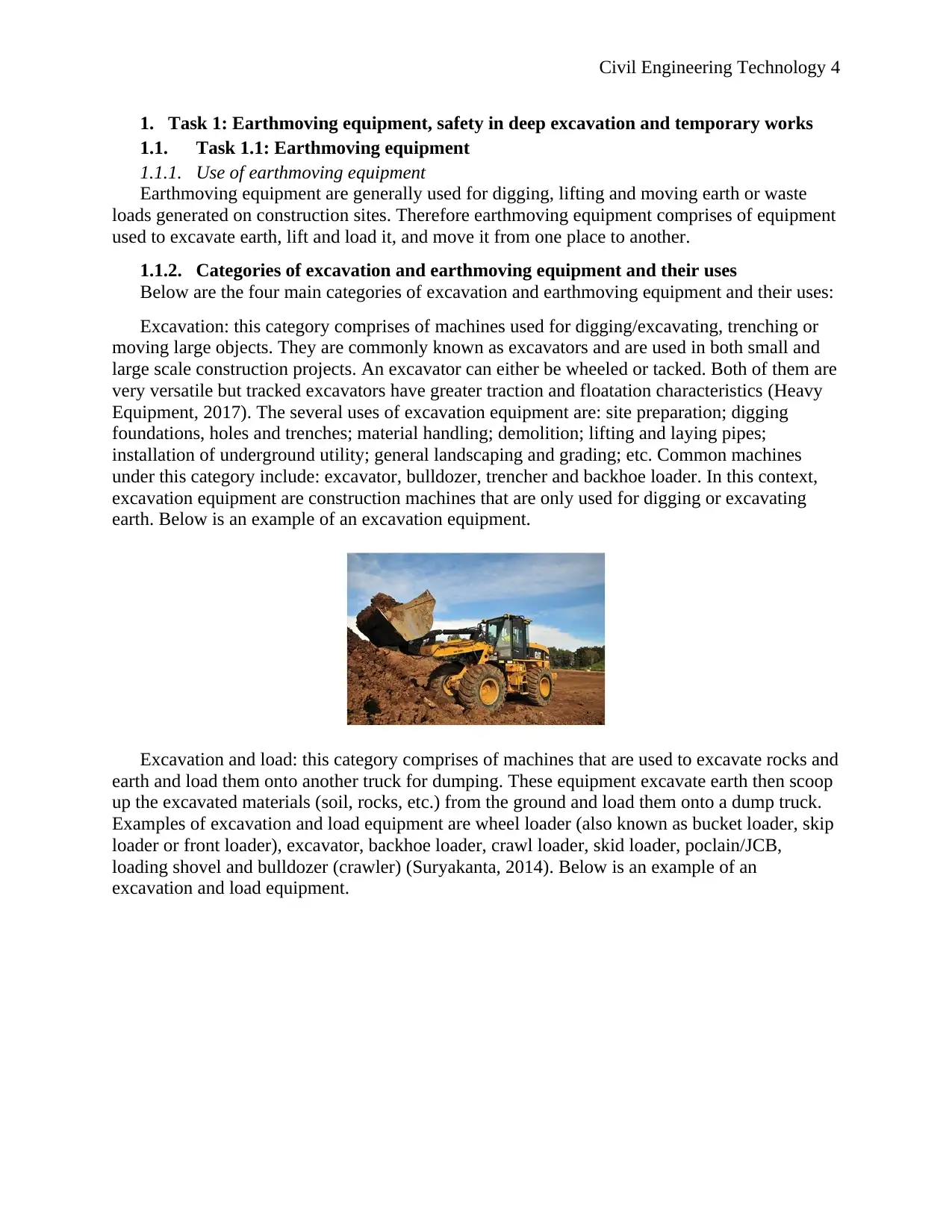
Civil Engineering Technology 4
1. Task 1: Earthmoving equipment, safety in deep excavation and temporary works
1.1. Task 1.1: Earthmoving equipment
1.1.1. Use of earthmoving equipment
Earthmoving equipment are generally used for digging, lifting and moving earth or waste
loads generated on construction sites. Therefore earthmoving equipment comprises of equipment
used to excavate earth, lift and load it, and move it from one place to another.
1.1.2. Categories of excavation and earthmoving equipment and their uses
Below are the four main categories of excavation and earthmoving equipment and their uses:
Excavation: this category comprises of machines used for digging/excavating, trenching or
moving large objects. They are commonly known as excavators and are used in both small and
large scale construction projects. An excavator can either be wheeled or tacked. Both of them are
very versatile but tracked excavators have greater traction and floatation characteristics (Heavy
Equipment, 2017). The several uses of excavation equipment are: site preparation; digging
foundations, holes and trenches; material handling; demolition; lifting and laying pipes;
installation of underground utility; general landscaping and grading; etc. Common machines
under this category include: excavator, bulldozer, trencher and backhoe loader. In this context,
excavation equipment are construction machines that are only used for digging or excavating
earth. Below is an example of an excavation equipment.
Excavation and load: this category comprises of machines that are used to excavate rocks and
earth and load them onto another truck for dumping. These equipment excavate earth then scoop
up the excavated materials (soil, rocks, etc.) from the ground and load them onto a dump truck.
Examples of excavation and load equipment are wheel loader (also known as bucket loader, skip
loader or front loader), excavator, backhoe loader, crawl loader, skid loader, poclain/JCB,
loading shovel and bulldozer (crawler) (Suryakanta, 2014). Below is an example of an
excavation and load equipment.
1. Task 1: Earthmoving equipment, safety in deep excavation and temporary works
1.1. Task 1.1: Earthmoving equipment
1.1.1. Use of earthmoving equipment
Earthmoving equipment are generally used for digging, lifting and moving earth or waste
loads generated on construction sites. Therefore earthmoving equipment comprises of equipment
used to excavate earth, lift and load it, and move it from one place to another.
1.1.2. Categories of excavation and earthmoving equipment and their uses
Below are the four main categories of excavation and earthmoving equipment and their uses:
Excavation: this category comprises of machines used for digging/excavating, trenching or
moving large objects. They are commonly known as excavators and are used in both small and
large scale construction projects. An excavator can either be wheeled or tacked. Both of them are
very versatile but tracked excavators have greater traction and floatation characteristics (Heavy
Equipment, 2017). The several uses of excavation equipment are: site preparation; digging
foundations, holes and trenches; material handling; demolition; lifting and laying pipes;
installation of underground utility; general landscaping and grading; etc. Common machines
under this category include: excavator, bulldozer, trencher and backhoe loader. In this context,
excavation equipment are construction machines that are only used for digging or excavating
earth. Below is an example of an excavation equipment.
Excavation and load: this category comprises of machines that are used to excavate rocks and
earth and load them onto another truck for dumping. These equipment excavate earth then scoop
up the excavated materials (soil, rocks, etc.) from the ground and load them onto a dump truck.
Examples of excavation and load equipment are wheel loader (also known as bucket loader, skip
loader or front loader), excavator, backhoe loader, crawl loader, skid loader, poclain/JCB,
loading shovel and bulldozer (crawler) (Suryakanta, 2014). Below is an example of an
excavation and load equipment.
Secure Best Marks with AI Grader
Need help grading? Try our AI Grader for instant feedback on your assignments.
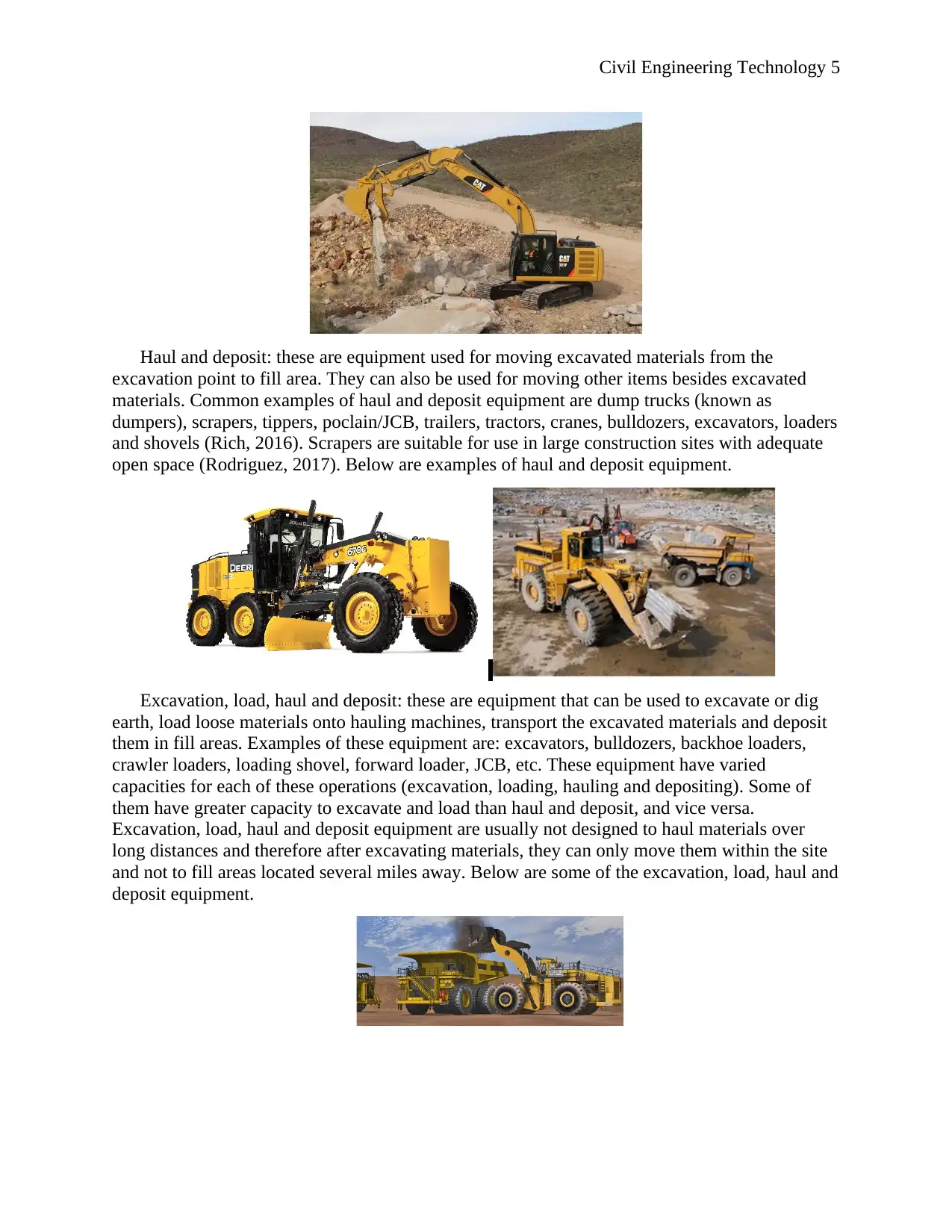
Civil Engineering Technology 5
Haul and deposit: these are equipment used for moving excavated materials from the
excavation point to fill area. They can also be used for moving other items besides excavated
materials. Common examples of haul and deposit equipment are dump trucks (known as
dumpers), scrapers, tippers, poclain/JCB, trailers, tractors, cranes, bulldozers, excavators, loaders
and shovels (Rich, 2016). Scrapers are suitable for use in large construction sites with adequate
open space (Rodriguez, 2017). Below are examples of haul and deposit equipment.
Excavation, load, haul and deposit: these are equipment that can be used to excavate or dig
earth, load loose materials onto hauling machines, transport the excavated materials and deposit
them in fill areas. Examples of these equipment are: excavators, bulldozers, backhoe loaders,
crawler loaders, loading shovel, forward loader, JCB, etc. These equipment have varied
capacities for each of these operations (excavation, loading, hauling and depositing). Some of
them have greater capacity to excavate and load than haul and deposit, and vice versa.
Excavation, load, haul and deposit equipment are usually not designed to haul materials over
long distances and therefore after excavating materials, they can only move them within the site
and not to fill areas located several miles away. Below are some of the excavation, load, haul and
deposit equipment.
Haul and deposit: these are equipment used for moving excavated materials from the
excavation point to fill area. They can also be used for moving other items besides excavated
materials. Common examples of haul and deposit equipment are dump trucks (known as
dumpers), scrapers, tippers, poclain/JCB, trailers, tractors, cranes, bulldozers, excavators, loaders
and shovels (Rich, 2016). Scrapers are suitable for use in large construction sites with adequate
open space (Rodriguez, 2017). Below are examples of haul and deposit equipment.
Excavation, load, haul and deposit: these are equipment that can be used to excavate or dig
earth, load loose materials onto hauling machines, transport the excavated materials and deposit
them in fill areas. Examples of these equipment are: excavators, bulldozers, backhoe loaders,
crawler loaders, loading shovel, forward loader, JCB, etc. These equipment have varied
capacities for each of these operations (excavation, loading, hauling and depositing). Some of
them have greater capacity to excavate and load than haul and deposit, and vice versa.
Excavation, load, haul and deposit equipment are usually not designed to haul materials over
long distances and therefore after excavating materials, they can only move them within the site
and not to fill areas located several miles away. Below are some of the excavation, load, haul and
deposit equipment.
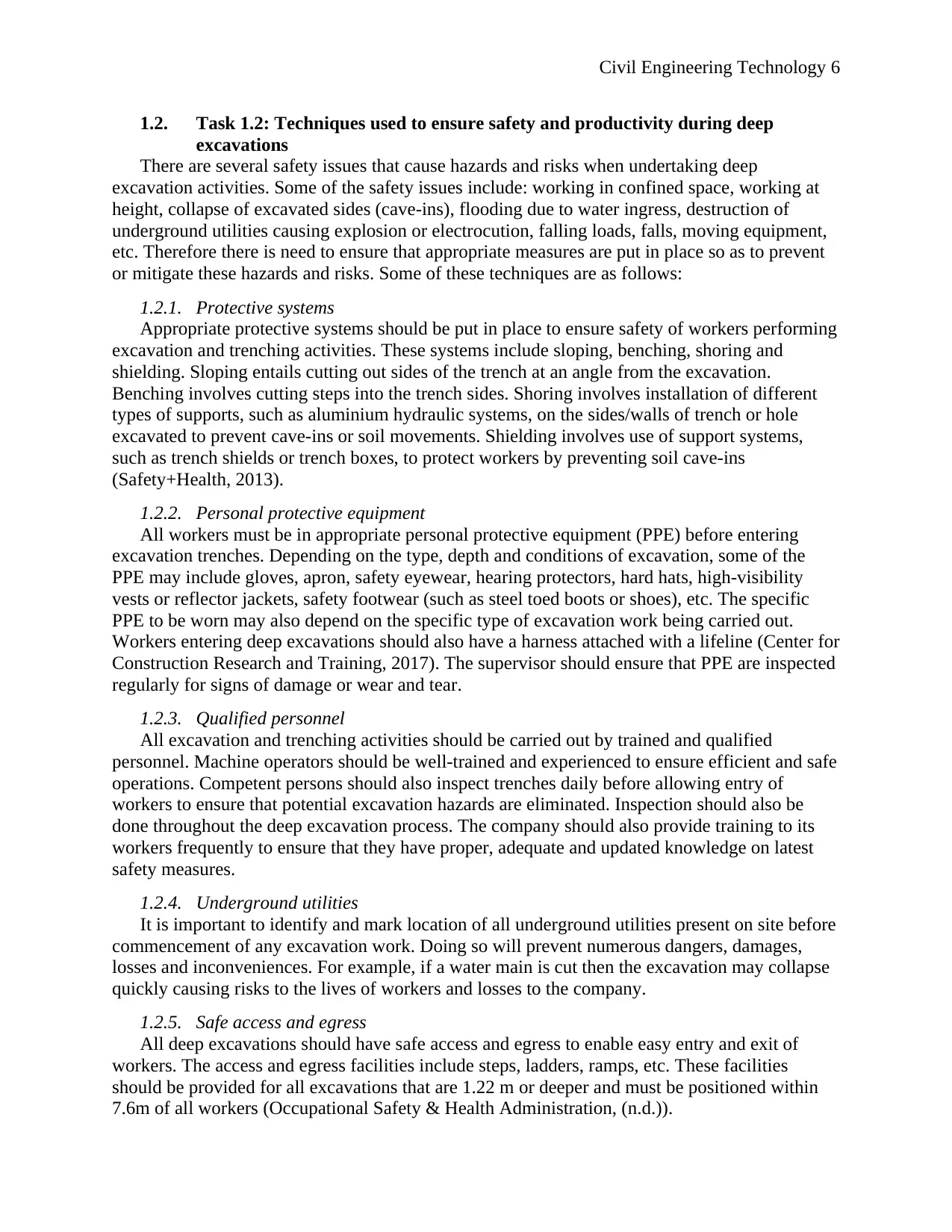
Civil Engineering Technology 6
1.2. Task 1.2: Techniques used to ensure safety and productivity during deep
excavations
There are several safety issues that cause hazards and risks when undertaking deep
excavation activities. Some of the safety issues include: working in confined space, working at
height, collapse of excavated sides (cave-ins), flooding due to water ingress, destruction of
underground utilities causing explosion or electrocution, falling loads, falls, moving equipment,
etc. Therefore there is need to ensure that appropriate measures are put in place so as to prevent
or mitigate these hazards and risks. Some of these techniques are as follows:
1.2.1. Protective systems
Appropriate protective systems should be put in place to ensure safety of workers performing
excavation and trenching activities. These systems include sloping, benching, shoring and
shielding. Sloping entails cutting out sides of the trench at an angle from the excavation.
Benching involves cutting steps into the trench sides. Shoring involves installation of different
types of supports, such as aluminium hydraulic systems, on the sides/walls of trench or hole
excavated to prevent cave-ins or soil movements. Shielding involves use of support systems,
such as trench shields or trench boxes, to protect workers by preventing soil cave-ins
(Safety+Health, 2013).
1.2.2. Personal protective equipment
All workers must be in appropriate personal protective equipment (PPE) before entering
excavation trenches. Depending on the type, depth and conditions of excavation, some of the
PPE may include gloves, apron, safety eyewear, hearing protectors, hard hats, high-visibility
vests or reflector jackets, safety footwear (such as steel toed boots or shoes), etc. The specific
PPE to be worn may also depend on the specific type of excavation work being carried out.
Workers entering deep excavations should also have a harness attached with a lifeline (Center for
Construction Research and Training, 2017). The supervisor should ensure that PPE are inspected
regularly for signs of damage or wear and tear.
1.2.3. Qualified personnel
All excavation and trenching activities should be carried out by trained and qualified
personnel. Machine operators should be well-trained and experienced to ensure efficient and safe
operations. Competent persons should also inspect trenches daily before allowing entry of
workers to ensure that potential excavation hazards are eliminated. Inspection should also be
done throughout the deep excavation process. The company should also provide training to its
workers frequently to ensure that they have proper, adequate and updated knowledge on latest
safety measures.
1.2.4. Underground utilities
It is important to identify and mark location of all underground utilities present on site before
commencement of any excavation work. Doing so will prevent numerous dangers, damages,
losses and inconveniences. For example, if a water main is cut then the excavation may collapse
quickly causing risks to the lives of workers and losses to the company.
1.2.5. Safe access and egress
All deep excavations should have safe access and egress to enable easy entry and exit of
workers. The access and egress facilities include steps, ladders, ramps, etc. These facilities
should be provided for all excavations that are 1.22 m or deeper and must be positioned within
7.6m of all workers (Occupational Safety & Health Administration, (n.d.)).
1.2. Task 1.2: Techniques used to ensure safety and productivity during deep
excavations
There are several safety issues that cause hazards and risks when undertaking deep
excavation activities. Some of the safety issues include: working in confined space, working at
height, collapse of excavated sides (cave-ins), flooding due to water ingress, destruction of
underground utilities causing explosion or electrocution, falling loads, falls, moving equipment,
etc. Therefore there is need to ensure that appropriate measures are put in place so as to prevent
or mitigate these hazards and risks. Some of these techniques are as follows:
1.2.1. Protective systems
Appropriate protective systems should be put in place to ensure safety of workers performing
excavation and trenching activities. These systems include sloping, benching, shoring and
shielding. Sloping entails cutting out sides of the trench at an angle from the excavation.
Benching involves cutting steps into the trench sides. Shoring involves installation of different
types of supports, such as aluminium hydraulic systems, on the sides/walls of trench or hole
excavated to prevent cave-ins or soil movements. Shielding involves use of support systems,
such as trench shields or trench boxes, to protect workers by preventing soil cave-ins
(Safety+Health, 2013).
1.2.2. Personal protective equipment
All workers must be in appropriate personal protective equipment (PPE) before entering
excavation trenches. Depending on the type, depth and conditions of excavation, some of the
PPE may include gloves, apron, safety eyewear, hearing protectors, hard hats, high-visibility
vests or reflector jackets, safety footwear (such as steel toed boots or shoes), etc. The specific
PPE to be worn may also depend on the specific type of excavation work being carried out.
Workers entering deep excavations should also have a harness attached with a lifeline (Center for
Construction Research and Training, 2017). The supervisor should ensure that PPE are inspected
regularly for signs of damage or wear and tear.
1.2.3. Qualified personnel
All excavation and trenching activities should be carried out by trained and qualified
personnel. Machine operators should be well-trained and experienced to ensure efficient and safe
operations. Competent persons should also inspect trenches daily before allowing entry of
workers to ensure that potential excavation hazards are eliminated. Inspection should also be
done throughout the deep excavation process. The company should also provide training to its
workers frequently to ensure that they have proper, adequate and updated knowledge on latest
safety measures.
1.2.4. Underground utilities
It is important to identify and mark location of all underground utilities present on site before
commencement of any excavation work. Doing so will prevent numerous dangers, damages,
losses and inconveniences. For example, if a water main is cut then the excavation may collapse
quickly causing risks to the lives of workers and losses to the company.
1.2.5. Safe access and egress
All deep excavations should have safe access and egress to enable easy entry and exit of
workers. The access and egress facilities include steps, ladders, ramps, etc. These facilities
should be provided for all excavations that are 1.22 m or deeper and must be positioned within
7.6m of all workers (Occupational Safety & Health Administration, (n.d.)).
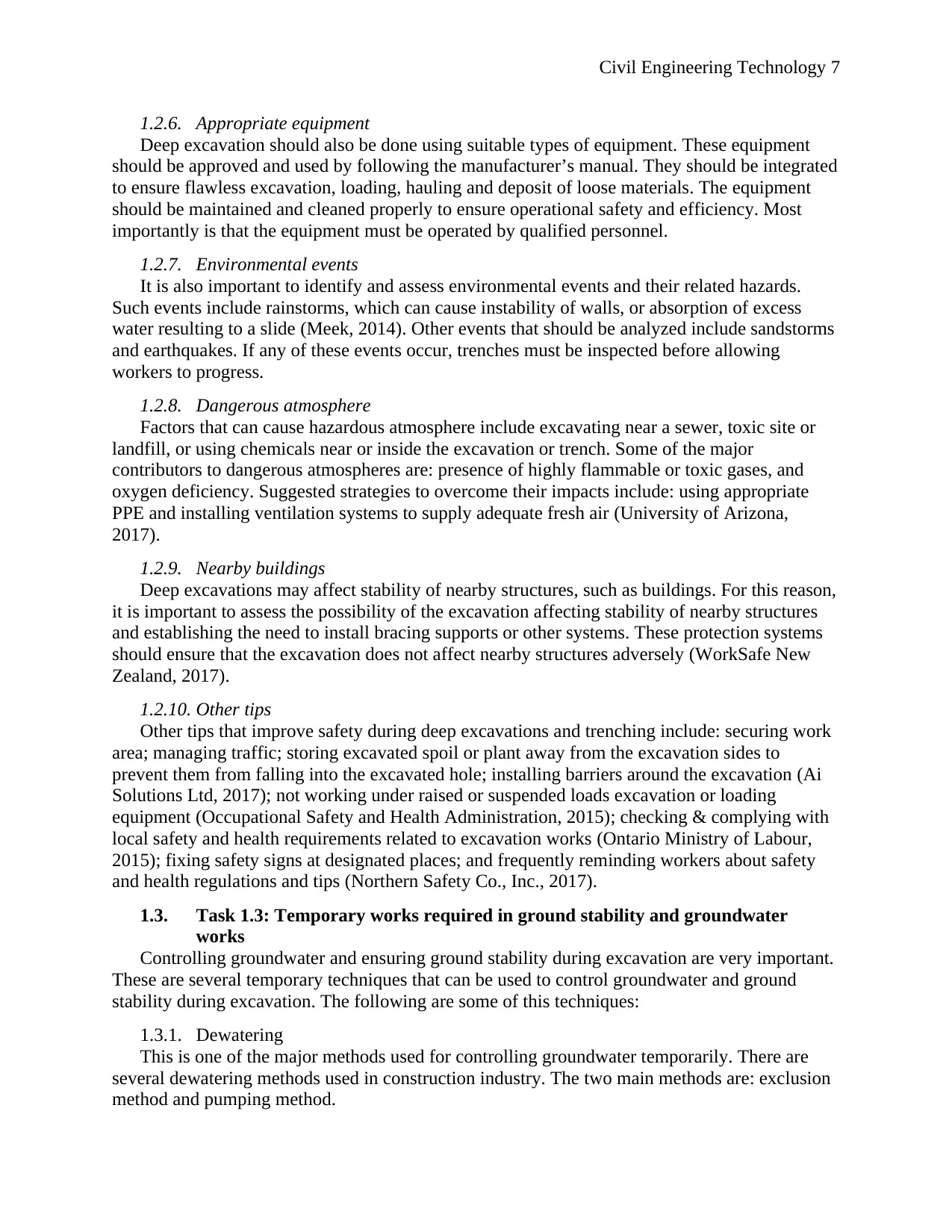
Civil Engineering Technology 7
1.2.6. Appropriate equipment
Deep excavation should also be done using suitable types of equipment. These equipment
should be approved and used by following the manufacturer’s manual. They should be integrated
to ensure flawless excavation, loading, hauling and deposit of loose materials. The equipment
should be maintained and cleaned properly to ensure operational safety and efficiency. Most
importantly is that the equipment must be operated by qualified personnel.
1.2.7. Environmental events
It is also important to identify and assess environmental events and their related hazards.
Such events include rainstorms, which can cause instability of walls, or absorption of excess
water resulting to a slide (Meek, 2014). Other events that should be analyzed include sandstorms
and earthquakes. If any of these events occur, trenches must be inspected before allowing
workers to progress.
1.2.8. Dangerous atmosphere
Factors that can cause hazardous atmosphere include excavating near a sewer, toxic site or
landfill, or using chemicals near or inside the excavation or trench. Some of the major
contributors to dangerous atmospheres are: presence of highly flammable or toxic gases, and
oxygen deficiency. Suggested strategies to overcome their impacts include: using appropriate
PPE and installing ventilation systems to supply adequate fresh air (University of Arizona,
2017).
1.2.9. Nearby buildings
Deep excavations may affect stability of nearby structures, such as buildings. For this reason,
it is important to assess the possibility of the excavation affecting stability of nearby structures
and establishing the need to install bracing supports or other systems. These protection systems
should ensure that the excavation does not affect nearby structures adversely (WorkSafe New
Zealand, 2017).
1.2.10. Other tips
Other tips that improve safety during deep excavations and trenching include: securing work
area; managing traffic; storing excavated spoil or plant away from the excavation sides to
prevent them from falling into the excavated hole; installing barriers around the excavation (Ai
Solutions Ltd, 2017); not working under raised or suspended loads excavation or loading
equipment (Occupational Safety and Health Administration, 2015); checking & complying with
local safety and health requirements related to excavation works (Ontario Ministry of Labour,
2015); fixing safety signs at designated places; and frequently reminding workers about safety
and health regulations and tips (Northern Safety Co., Inc., 2017).
1.3. Task 1.3: Temporary works required in ground stability and groundwater
works
Controlling groundwater and ensuring ground stability during excavation are very important.
These are several temporary techniques that can be used to control groundwater and ground
stability during excavation. The following are some of this techniques:
1.3.1. Dewatering
This is one of the major methods used for controlling groundwater temporarily. There are
several dewatering methods used in construction industry. The two main methods are: exclusion
method and pumping method.
1.2.6. Appropriate equipment
Deep excavation should also be done using suitable types of equipment. These equipment
should be approved and used by following the manufacturer’s manual. They should be integrated
to ensure flawless excavation, loading, hauling and deposit of loose materials. The equipment
should be maintained and cleaned properly to ensure operational safety and efficiency. Most
importantly is that the equipment must be operated by qualified personnel.
1.2.7. Environmental events
It is also important to identify and assess environmental events and their related hazards.
Such events include rainstorms, which can cause instability of walls, or absorption of excess
water resulting to a slide (Meek, 2014). Other events that should be analyzed include sandstorms
and earthquakes. If any of these events occur, trenches must be inspected before allowing
workers to progress.
1.2.8. Dangerous atmosphere
Factors that can cause hazardous atmosphere include excavating near a sewer, toxic site or
landfill, or using chemicals near or inside the excavation or trench. Some of the major
contributors to dangerous atmospheres are: presence of highly flammable or toxic gases, and
oxygen deficiency. Suggested strategies to overcome their impacts include: using appropriate
PPE and installing ventilation systems to supply adequate fresh air (University of Arizona,
2017).
1.2.9. Nearby buildings
Deep excavations may affect stability of nearby structures, such as buildings. For this reason,
it is important to assess the possibility of the excavation affecting stability of nearby structures
and establishing the need to install bracing supports or other systems. These protection systems
should ensure that the excavation does not affect nearby structures adversely (WorkSafe New
Zealand, 2017).
1.2.10. Other tips
Other tips that improve safety during deep excavations and trenching include: securing work
area; managing traffic; storing excavated spoil or plant away from the excavation sides to
prevent them from falling into the excavated hole; installing barriers around the excavation (Ai
Solutions Ltd, 2017); not working under raised or suspended loads excavation or loading
equipment (Occupational Safety and Health Administration, 2015); checking & complying with
local safety and health requirements related to excavation works (Ontario Ministry of Labour,
2015); fixing safety signs at designated places; and frequently reminding workers about safety
and health regulations and tips (Northern Safety Co., Inc., 2017).
1.3. Task 1.3: Temporary works required in ground stability and groundwater
works
Controlling groundwater and ensuring ground stability during excavation are very important.
These are several temporary techniques that can be used to control groundwater and ground
stability during excavation. The following are some of this techniques:
1.3.1. Dewatering
This is one of the major methods used for controlling groundwater temporarily. There are
several dewatering methods used in construction industry. The two main methods are: exclusion
method and pumping method.
Paraphrase This Document
Need a fresh take? Get an instant paraphrase of this document with our AI Paraphraser
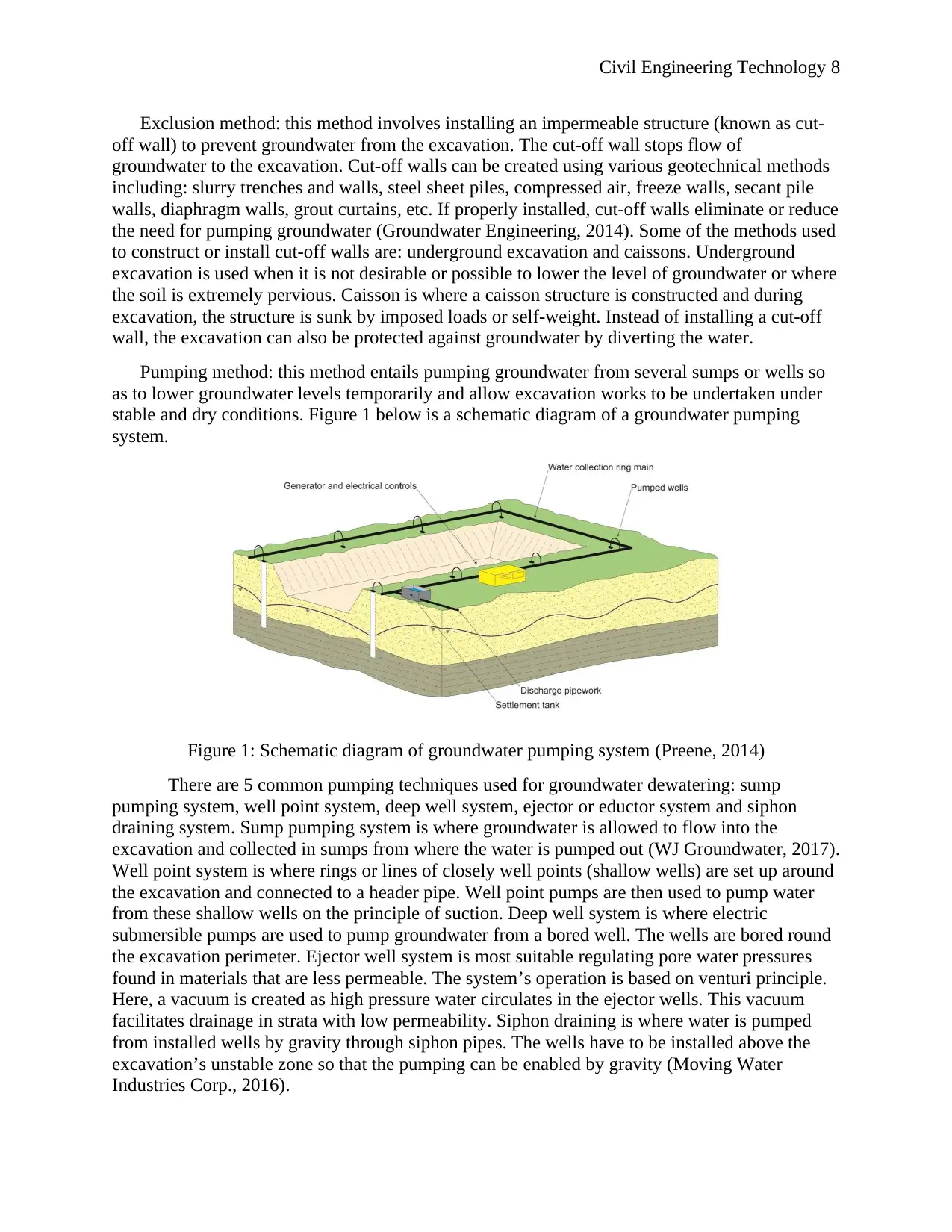
Civil Engineering Technology 8
Exclusion method: this method involves installing an impermeable structure (known as cut-
off wall) to prevent groundwater from the excavation. The cut-off wall stops flow of
groundwater to the excavation. Cut-off walls can be created using various geotechnical methods
including: slurry trenches and walls, steel sheet piles, compressed air, freeze walls, secant pile
walls, diaphragm walls, grout curtains, etc. If properly installed, cut-off walls eliminate or reduce
the need for pumping groundwater (Groundwater Engineering, 2014). Some of the methods used
to construct or install cut-off walls are: underground excavation and caissons. Underground
excavation is used when it is not desirable or possible to lower the level of groundwater or where
the soil is extremely pervious. Caisson is where a caisson structure is constructed and during
excavation, the structure is sunk by imposed loads or self-weight. Instead of installing a cut-off
wall, the excavation can also be protected against groundwater by diverting the water.
Pumping method: this method entails pumping groundwater from several sumps or wells so
as to lower groundwater levels temporarily and allow excavation works to be undertaken under
stable and dry conditions. Figure 1 below is a schematic diagram of a groundwater pumping
system.
Figure 1: Schematic diagram of groundwater pumping system (Preene, 2014)
There are 5 common pumping techniques used for groundwater dewatering: sump
pumping system, well point system, deep well system, ejector or eductor system and siphon
draining system. Sump pumping system is where groundwater is allowed to flow into the
excavation and collected in sumps from where the water is pumped out (WJ Groundwater, 2017).
Well point system is where rings or lines of closely well points (shallow wells) are set up around
the excavation and connected to a header pipe. Well point pumps are then used to pump water
from these shallow wells on the principle of suction. Deep well system is where electric
submersible pumps are used to pump groundwater from a bored well. The wells are bored round
the excavation perimeter. Ejector well system is most suitable regulating pore water pressures
found in materials that are less permeable. The system’s operation is based on venturi principle.
Here, a vacuum is created as high pressure water circulates in the ejector wells. This vacuum
facilitates drainage in strata with low permeability. Siphon draining is where water is pumped
from installed wells by gravity through siphon pipes. The wells have to be installed above the
excavation’s unstable zone so that the pumping can be enabled by gravity (Moving Water
Industries Corp., 2016).
Exclusion method: this method involves installing an impermeable structure (known as cut-
off wall) to prevent groundwater from the excavation. The cut-off wall stops flow of
groundwater to the excavation. Cut-off walls can be created using various geotechnical methods
including: slurry trenches and walls, steel sheet piles, compressed air, freeze walls, secant pile
walls, diaphragm walls, grout curtains, etc. If properly installed, cut-off walls eliminate or reduce
the need for pumping groundwater (Groundwater Engineering, 2014). Some of the methods used
to construct or install cut-off walls are: underground excavation and caissons. Underground
excavation is used when it is not desirable or possible to lower the level of groundwater or where
the soil is extremely pervious. Caisson is where a caisson structure is constructed and during
excavation, the structure is sunk by imposed loads or self-weight. Instead of installing a cut-off
wall, the excavation can also be protected against groundwater by diverting the water.
Pumping method: this method entails pumping groundwater from several sumps or wells so
as to lower groundwater levels temporarily and allow excavation works to be undertaken under
stable and dry conditions. Figure 1 below is a schematic diagram of a groundwater pumping
system.
Figure 1: Schematic diagram of groundwater pumping system (Preene, 2014)
There are 5 common pumping techniques used for groundwater dewatering: sump
pumping system, well point system, deep well system, ejector or eductor system and siphon
draining system. Sump pumping system is where groundwater is allowed to flow into the
excavation and collected in sumps from where the water is pumped out (WJ Groundwater, 2017).
Well point system is where rings or lines of closely well points (shallow wells) are set up around
the excavation and connected to a header pipe. Well point pumps are then used to pump water
from these shallow wells on the principle of suction. Deep well system is where electric
submersible pumps are used to pump groundwater from a bored well. The wells are bored round
the excavation perimeter. Ejector well system is most suitable regulating pore water pressures
found in materials that are less permeable. The system’s operation is based on venturi principle.
Here, a vacuum is created as high pressure water circulates in the ejector wells. This vacuum
facilitates drainage in strata with low permeability. Siphon draining is where water is pumped
from installed wells by gravity through siphon pipes. The wells have to be installed above the
excavation’s unstable zone so that the pumping can be enabled by gravity (Moving Water
Industries Corp., 2016).
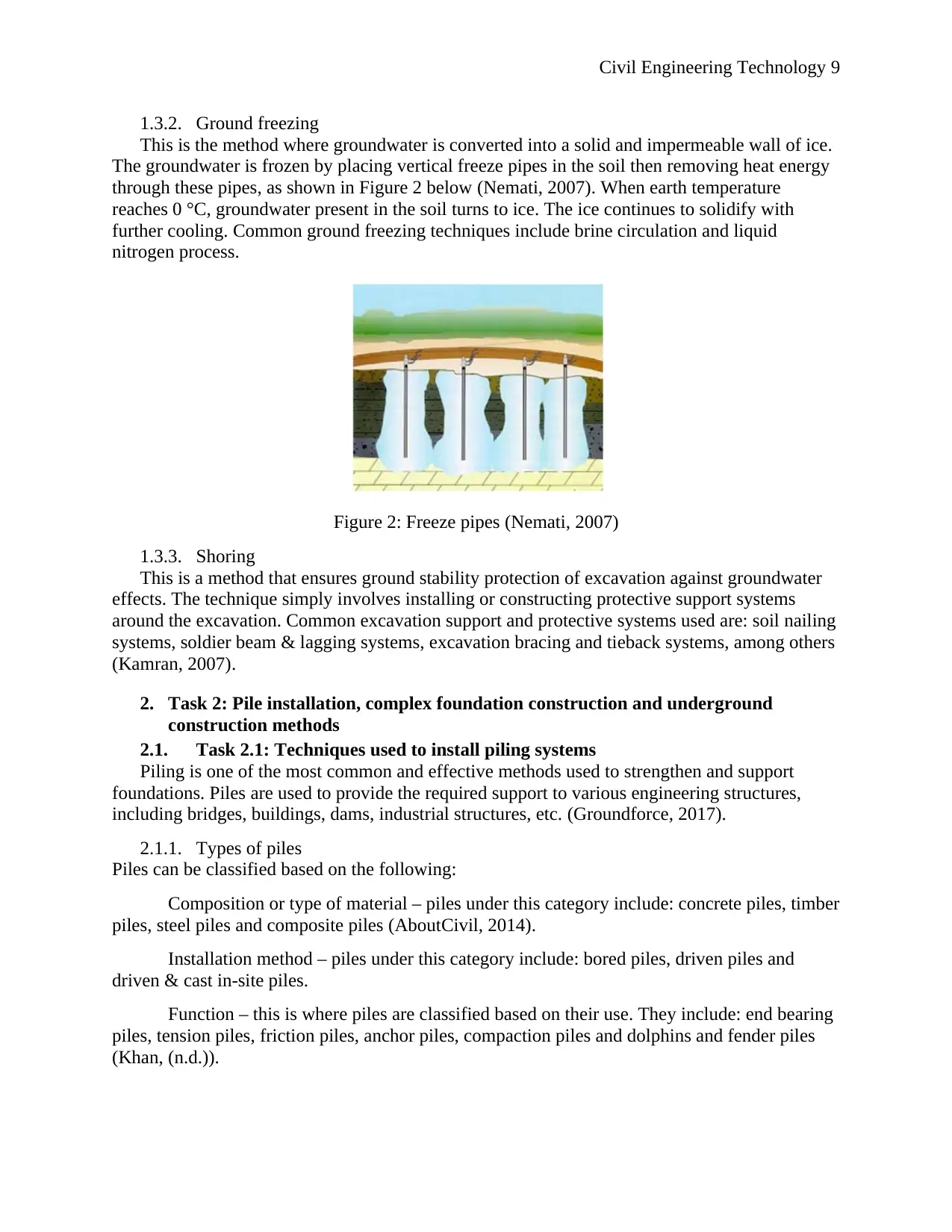
Civil Engineering Technology 9
1.3.2. Ground freezing
This is the method where groundwater is converted into a solid and impermeable wall of ice.
The groundwater is frozen by placing vertical freeze pipes in the soil then removing heat energy
through these pipes, as shown in Figure 2 below (Nemati, 2007). When earth temperature
reaches 0 °C, groundwater present in the soil turns to ice. The ice continues to solidify with
further cooling. Common ground freezing techniques include brine circulation and liquid
nitrogen process.
Figure 2: Freeze pipes (Nemati, 2007)
1.3.3. Shoring
This is a method that ensures ground stability protection of excavation against groundwater
effects. The technique simply involves installing or constructing protective support systems
around the excavation. Common excavation support and protective systems used are: soil nailing
systems, soldier beam & lagging systems, excavation bracing and tieback systems, among others
(Kamran, 2007).
2. Task 2: Pile installation, complex foundation construction and underground
construction methods
2.1. Task 2.1: Techniques used to install piling systems
Piling is one of the most common and effective methods used to strengthen and support
foundations. Piles are used to provide the required support to various engineering structures,
including bridges, buildings, dams, industrial structures, etc. (Groundforce, 2017).
2.1.1. Types of piles
Piles can be classified based on the following:
Composition or type of material – piles under this category include: concrete piles, timber
piles, steel piles and composite piles (AboutCivil, 2014).
Installation method – piles under this category include: bored piles, driven piles and
driven & cast in-site piles.
Function – this is where piles are classified based on their use. They include: end bearing
piles, tension piles, friction piles, anchor piles, compaction piles and dolphins and fender piles
(Khan, (n.d.)).
1.3.2. Ground freezing
This is the method where groundwater is converted into a solid and impermeable wall of ice.
The groundwater is frozen by placing vertical freeze pipes in the soil then removing heat energy
through these pipes, as shown in Figure 2 below (Nemati, 2007). When earth temperature
reaches 0 °C, groundwater present in the soil turns to ice. The ice continues to solidify with
further cooling. Common ground freezing techniques include brine circulation and liquid
nitrogen process.
Figure 2: Freeze pipes (Nemati, 2007)
1.3.3. Shoring
This is a method that ensures ground stability protection of excavation against groundwater
effects. The technique simply involves installing or constructing protective support systems
around the excavation. Common excavation support and protective systems used are: soil nailing
systems, soldier beam & lagging systems, excavation bracing and tieback systems, among others
(Kamran, 2007).
2. Task 2: Pile installation, complex foundation construction and underground
construction methods
2.1. Task 2.1: Techniques used to install piling systems
Piling is one of the most common and effective methods used to strengthen and support
foundations. Piles are used to provide the required support to various engineering structures,
including bridges, buildings, dams, industrial structures, etc. (Groundforce, 2017).
2.1.1. Types of piles
Piles can be classified based on the following:
Composition or type of material – piles under this category include: concrete piles, timber
piles, steel piles and composite piles (AboutCivil, 2014).
Installation method – piles under this category include: bored piles, driven piles and
driven & cast in-site piles.
Function – this is where piles are classified based on their use. They include: end bearing
piles, tension piles, friction piles, anchor piles, compaction piles and dolphins and fender piles
(Khan, (n.d.)).
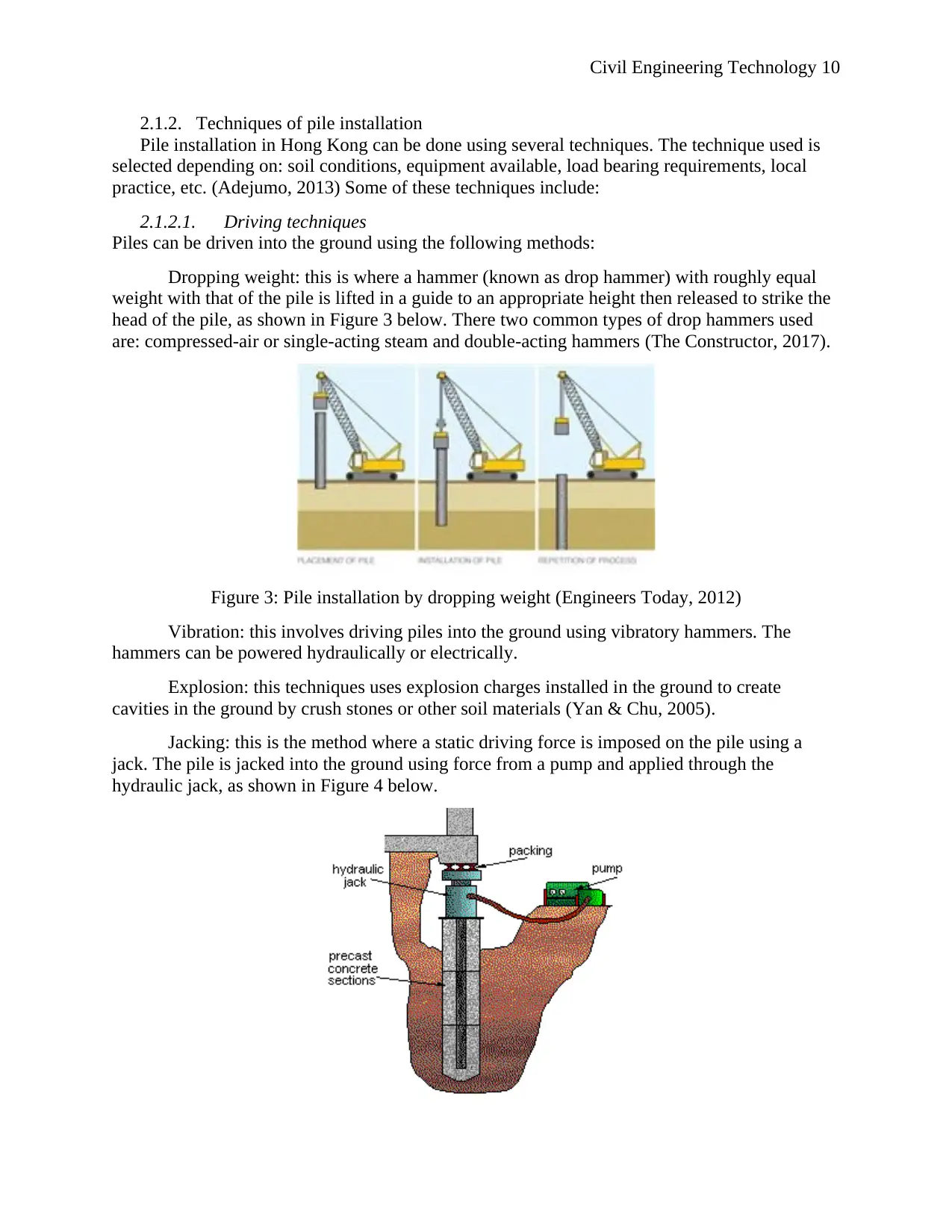
Civil Engineering Technology 10
2.1.2. Techniques of pile installation
Pile installation in Hong Kong can be done using several techniques. The technique used is
selected depending on: soil conditions, equipment available, load bearing requirements, local
practice, etc. (Adejumo, 2013) Some of these techniques include:
2.1.2.1. Driving techniques
Piles can be driven into the ground using the following methods:
Dropping weight: this is where a hammer (known as drop hammer) with roughly equal
weight with that of the pile is lifted in a guide to an appropriate height then released to strike the
head of the pile, as shown in Figure 3 below. There two common types of drop hammers used
are: compressed-air or single-acting steam and double-acting hammers (The Constructor, 2017).
Figure 3: Pile installation by dropping weight (Engineers Today, 2012)
Vibration: this involves driving piles into the ground using vibratory hammers. The
hammers can be powered hydraulically or electrically.
Explosion: this techniques uses explosion charges installed in the ground to create
cavities in the ground by crush stones or other soil materials (Yan & Chu, 2005).
Jacking: this is the method where a static driving force is imposed on the pile using a
jack. The pile is jacked into the ground using force from a pump and applied through the
hydraulic jack, as shown in Figure 4 below.
2.1.2. Techniques of pile installation
Pile installation in Hong Kong can be done using several techniques. The technique used is
selected depending on: soil conditions, equipment available, load bearing requirements, local
practice, etc. (Adejumo, 2013) Some of these techniques include:
2.1.2.1. Driving techniques
Piles can be driven into the ground using the following methods:
Dropping weight: this is where a hammer (known as drop hammer) with roughly equal
weight with that of the pile is lifted in a guide to an appropriate height then released to strike the
head of the pile, as shown in Figure 3 below. There two common types of drop hammers used
are: compressed-air or single-acting steam and double-acting hammers (The Constructor, 2017).
Figure 3: Pile installation by dropping weight (Engineers Today, 2012)
Vibration: this involves driving piles into the ground using vibratory hammers. The
hammers can be powered hydraulically or electrically.
Explosion: this techniques uses explosion charges installed in the ground to create
cavities in the ground by crush stones or other soil materials (Yan & Chu, 2005).
Jacking: this is the method where a static driving force is imposed on the pile using a
jack. The pile is jacked into the ground using force from a pump and applied through the
hydraulic jack, as shown in Figure 4 below.
Secure Best Marks with AI Grader
Need help grading? Try our AI Grader for instant feedback on your assignments.
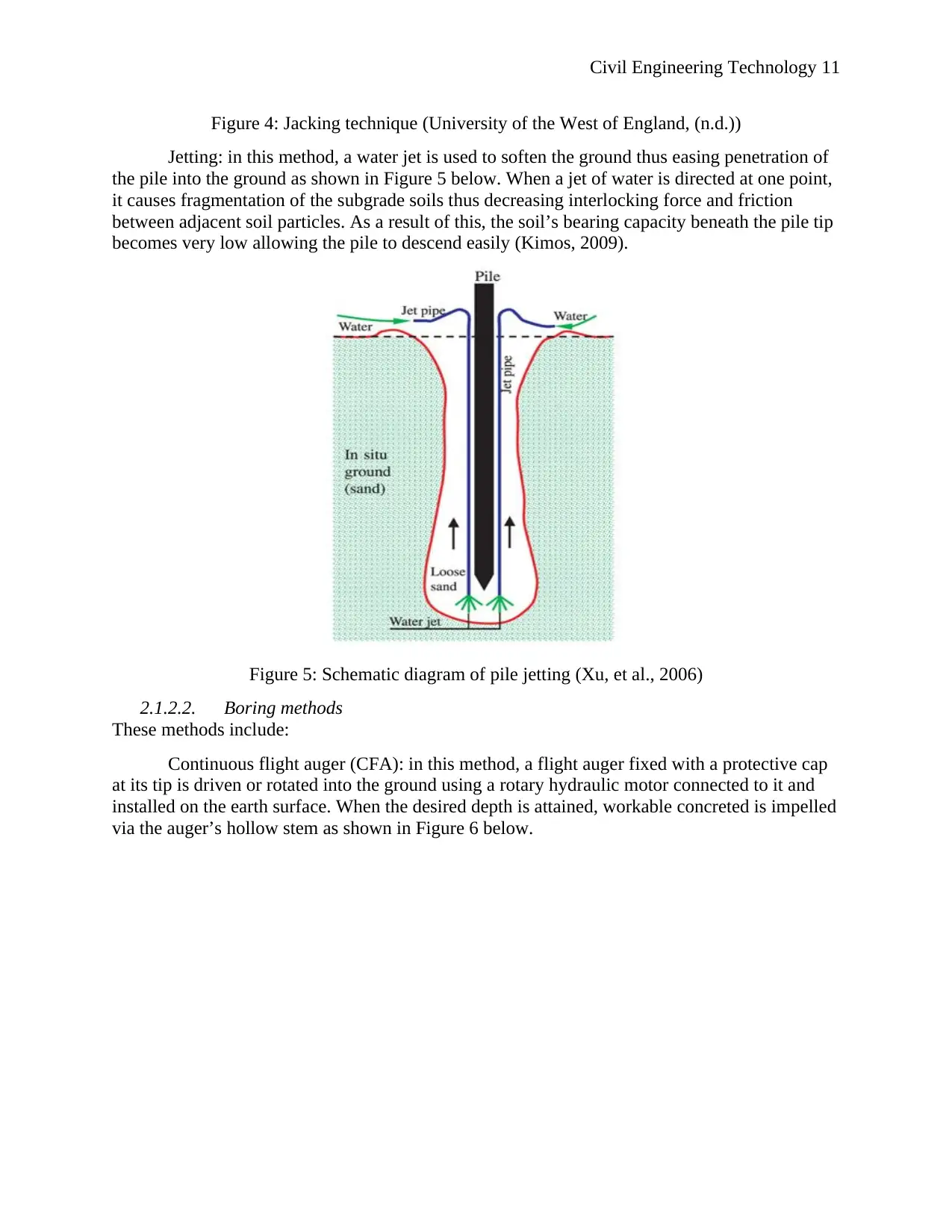
Civil Engineering Technology 11
Figure 4: Jacking technique (University of the West of England, (n.d.))
Jetting: in this method, a water jet is used to soften the ground thus easing penetration of
the pile into the ground as shown in Figure 5 below. When a jet of water is directed at one point,
it causes fragmentation of the subgrade soils thus decreasing interlocking force and friction
between adjacent soil particles. As a result of this, the soil’s bearing capacity beneath the pile tip
becomes very low allowing the pile to descend easily (Kimos, 2009).
Figure 5: Schematic diagram of pile jetting (Xu, et al., 2006)
2.1.2.2. Boring methods
These methods include:
Continuous flight auger (CFA): in this method, a flight auger fixed with a protective cap
at its tip is driven or rotated into the ground using a rotary hydraulic motor connected to it and
installed on the earth surface. When the desired depth is attained, workable concreted is impelled
via the auger’s hollow stem as shown in Figure 6 below.
Figure 4: Jacking technique (University of the West of England, (n.d.))
Jetting: in this method, a water jet is used to soften the ground thus easing penetration of
the pile into the ground as shown in Figure 5 below. When a jet of water is directed at one point,
it causes fragmentation of the subgrade soils thus decreasing interlocking force and friction
between adjacent soil particles. As a result of this, the soil’s bearing capacity beneath the pile tip
becomes very low allowing the pile to descend easily (Kimos, 2009).
Figure 5: Schematic diagram of pile jetting (Xu, et al., 2006)
2.1.2.2. Boring methods
These methods include:
Continuous flight auger (CFA): in this method, a flight auger fixed with a protective cap
at its tip is driven or rotated into the ground using a rotary hydraulic motor connected to it and
installed on the earth surface. When the desired depth is attained, workable concreted is impelled
via the auger’s hollow stem as shown in Figure 6 below.
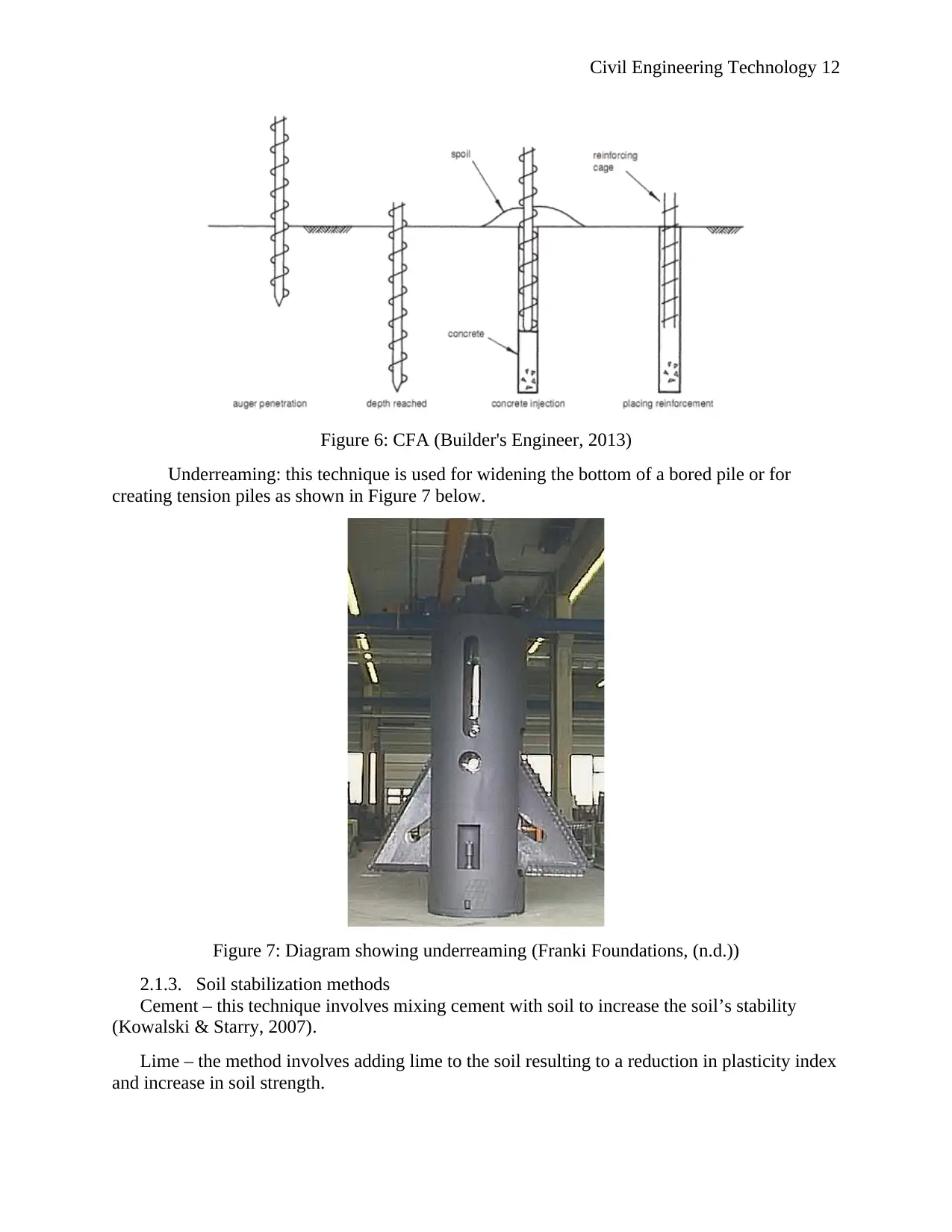
Civil Engineering Technology 12
Figure 6: CFA (Builder's Engineer, 2013)
Underreaming: this technique is used for widening the bottom of a bored pile or for
creating tension piles as shown in Figure 7 below.
Figure 7: Diagram showing underreaming (Franki Foundations, (n.d.))
2.1.3. Soil stabilization methods
Cement – this technique involves mixing cement with soil to increase the soil’s stability
(Kowalski & Starry, 2007).
Lime – the method involves adding lime to the soil resulting to a reduction in plasticity index
and increase in soil strength.
Figure 6: CFA (Builder's Engineer, 2013)
Underreaming: this technique is used for widening the bottom of a bored pile or for
creating tension piles as shown in Figure 7 below.
Figure 7: Diagram showing underreaming (Franki Foundations, (n.d.))
2.1.3. Soil stabilization methods
Cement – this technique involves mixing cement with soil to increase the soil’s stability
(Kowalski & Starry, 2007).
Lime – the method involves adding lime to the soil resulting to a reduction in plasticity index
and increase in soil strength.
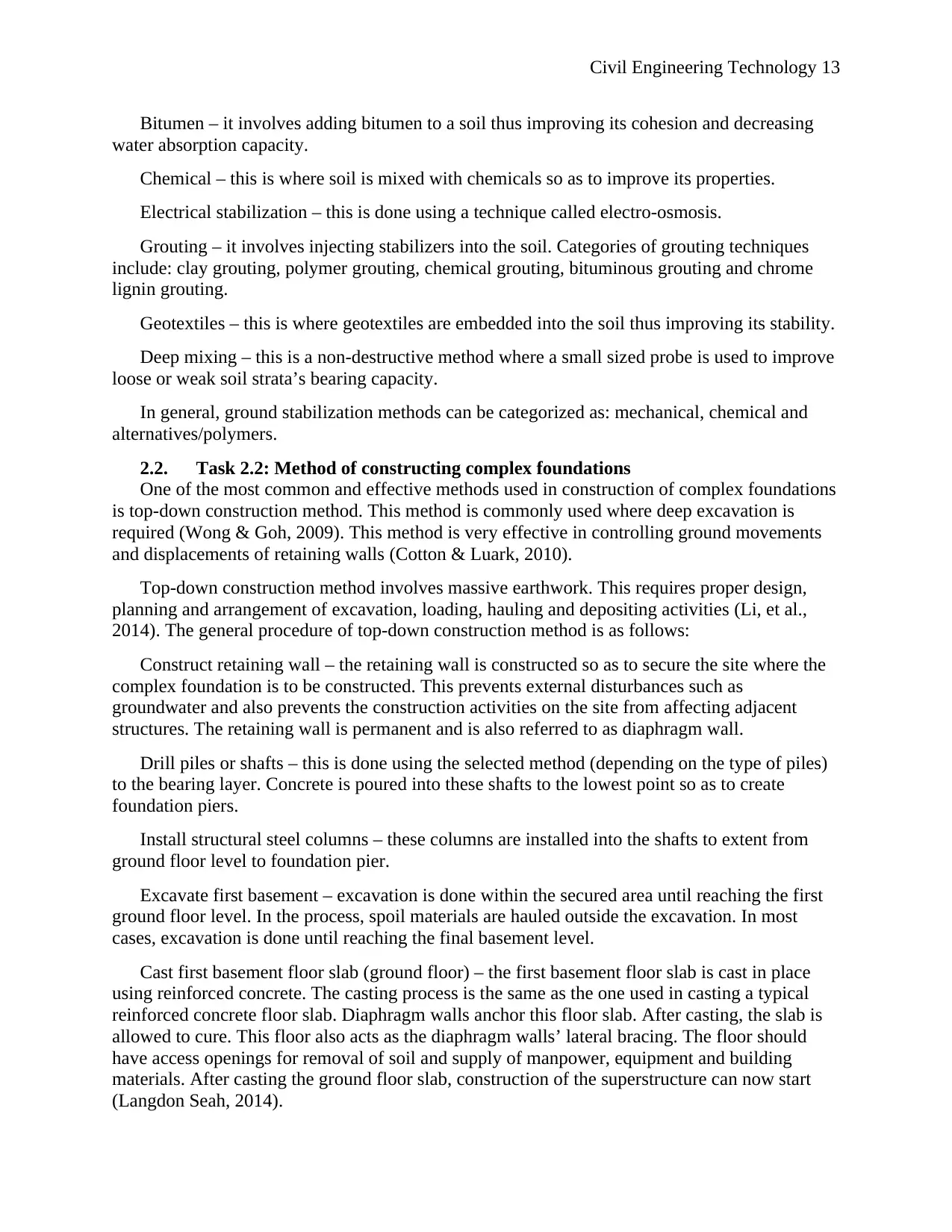
Civil Engineering Technology 13
Bitumen – it involves adding bitumen to a soil thus improving its cohesion and decreasing
water absorption capacity.
Chemical – this is where soil is mixed with chemicals so as to improve its properties.
Electrical stabilization – this is done using a technique called electro-osmosis.
Grouting – it involves injecting stabilizers into the soil. Categories of grouting techniques
include: clay grouting, polymer grouting, chemical grouting, bituminous grouting and chrome
lignin grouting.
Geotextiles – this is where geotextiles are embedded into the soil thus improving its stability.
Deep mixing – this is a non-destructive method where a small sized probe is used to improve
loose or weak soil strata’s bearing capacity.
In general, ground stabilization methods can be categorized as: mechanical, chemical and
alternatives/polymers.
2.2. Task 2.2: Method of constructing complex foundations
One of the most common and effective methods used in construction of complex foundations
is top-down construction method. This method is commonly used where deep excavation is
required (Wong & Goh, 2009). This method is very effective in controlling ground movements
and displacements of retaining walls (Cotton & Luark, 2010).
Top-down construction method involves massive earthwork. This requires proper design,
planning and arrangement of excavation, loading, hauling and depositing activities (Li, et al.,
2014). The general procedure of top-down construction method is as follows:
Construct retaining wall – the retaining wall is constructed so as to secure the site where the
complex foundation is to be constructed. This prevents external disturbances such as
groundwater and also prevents the construction activities on the site from affecting adjacent
structures. The retaining wall is permanent and is also referred to as diaphragm wall.
Drill piles or shafts – this is done using the selected method (depending on the type of piles)
to the bearing layer. Concrete is poured into these shafts to the lowest point so as to create
foundation piers.
Install structural steel columns – these columns are installed into the shafts to extent from
ground floor level to foundation pier.
Excavate first basement – excavation is done within the secured area until reaching the first
ground floor level. In the process, spoil materials are hauled outside the excavation. In most
cases, excavation is done until reaching the final basement level.
Cast first basement floor slab (ground floor) – the first basement floor slab is cast in place
using reinforced concrete. The casting process is the same as the one used in casting a typical
reinforced concrete floor slab. Diaphragm walls anchor this floor slab. After casting, the slab is
allowed to cure. This floor also acts as the diaphragm walls’ lateral bracing. The floor should
have access openings for removal of soil and supply of manpower, equipment and building
materials. After casting the ground floor slab, construction of the superstructure can now start
(Langdon Seah, 2014).
Bitumen – it involves adding bitumen to a soil thus improving its cohesion and decreasing
water absorption capacity.
Chemical – this is where soil is mixed with chemicals so as to improve its properties.
Electrical stabilization – this is done using a technique called electro-osmosis.
Grouting – it involves injecting stabilizers into the soil. Categories of grouting techniques
include: clay grouting, polymer grouting, chemical grouting, bituminous grouting and chrome
lignin grouting.
Geotextiles – this is where geotextiles are embedded into the soil thus improving its stability.
Deep mixing – this is a non-destructive method where a small sized probe is used to improve
loose or weak soil strata’s bearing capacity.
In general, ground stabilization methods can be categorized as: mechanical, chemical and
alternatives/polymers.
2.2. Task 2.2: Method of constructing complex foundations
One of the most common and effective methods used in construction of complex foundations
is top-down construction method. This method is commonly used where deep excavation is
required (Wong & Goh, 2009). This method is very effective in controlling ground movements
and displacements of retaining walls (Cotton & Luark, 2010).
Top-down construction method involves massive earthwork. This requires proper design,
planning and arrangement of excavation, loading, hauling and depositing activities (Li, et al.,
2014). The general procedure of top-down construction method is as follows:
Construct retaining wall – the retaining wall is constructed so as to secure the site where the
complex foundation is to be constructed. This prevents external disturbances such as
groundwater and also prevents the construction activities on the site from affecting adjacent
structures. The retaining wall is permanent and is also referred to as diaphragm wall.
Drill piles or shafts – this is done using the selected method (depending on the type of piles)
to the bearing layer. Concrete is poured into these shafts to the lowest point so as to create
foundation piers.
Install structural steel columns – these columns are installed into the shafts to extent from
ground floor level to foundation pier.
Excavate first basement – excavation is done within the secured area until reaching the first
ground floor level. In the process, spoil materials are hauled outside the excavation. In most
cases, excavation is done until reaching the final basement level.
Cast first basement floor slab (ground floor) – the first basement floor slab is cast in place
using reinforced concrete. The casting process is the same as the one used in casting a typical
reinforced concrete floor slab. Diaphragm walls anchor this floor slab. After casting, the slab is
allowed to cure. This floor also acts as the diaphragm walls’ lateral bracing. The floor should
have access openings for removal of soil and supply of manpower, equipment and building
materials. After casting the ground floor slab, construction of the superstructure can now start
(Langdon Seah, 2014).
Paraphrase This Document
Need a fresh take? Get an instant paraphrase of this document with our AI Paraphraser
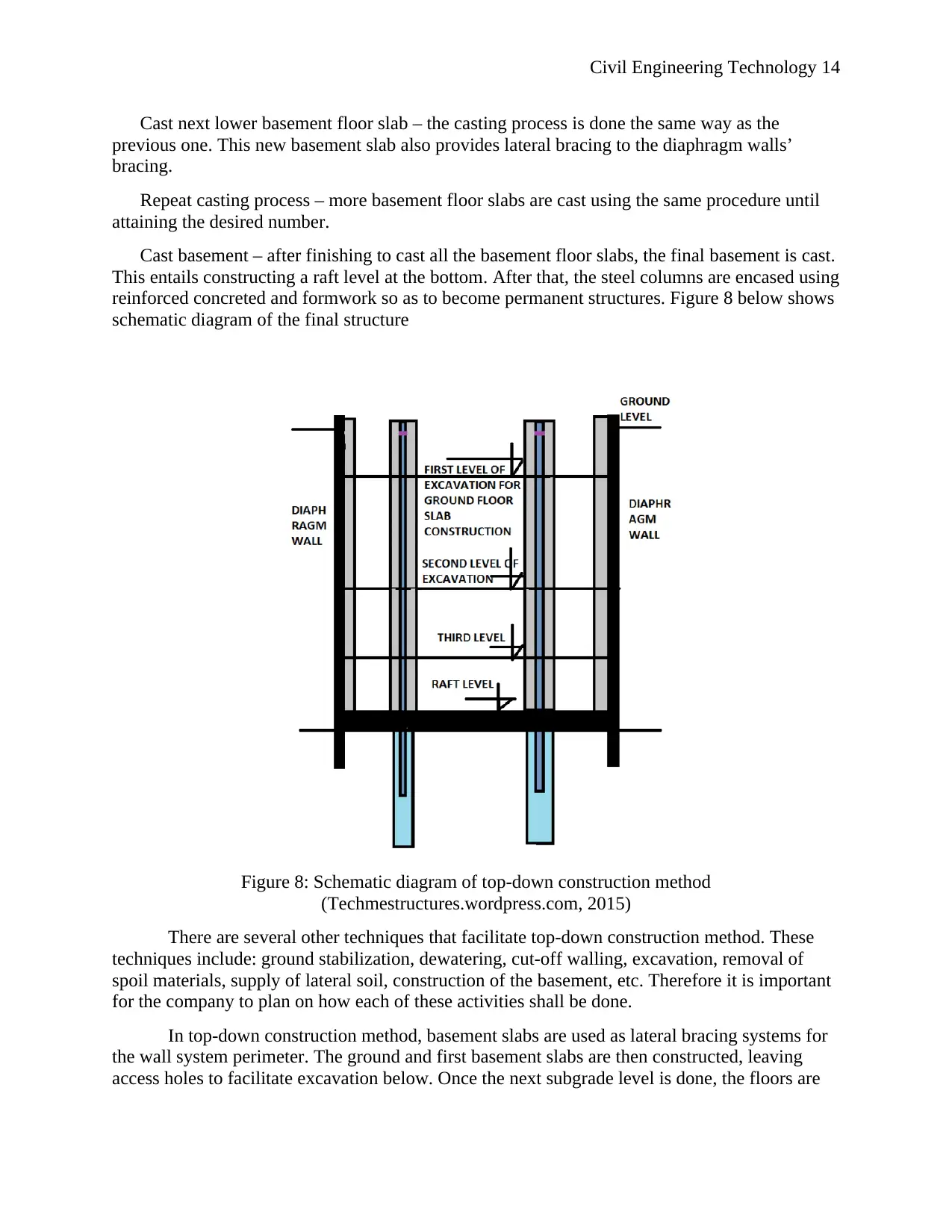
Civil Engineering Technology 14
Cast next lower basement floor slab – the casting process is done the same way as the
previous one. This new basement slab also provides lateral bracing to the diaphragm walls’
bracing.
Repeat casting process – more basement floor slabs are cast using the same procedure until
attaining the desired number.
Cast basement – after finishing to cast all the basement floor slabs, the final basement is cast.
This entails constructing a raft level at the bottom. After that, the steel columns are encased using
reinforced concreted and formwork so as to become permanent structures. Figure 8 below shows
schematic diagram of the final structure
Figure 8: Schematic diagram of top-down construction method
(Techmestructures.wordpress.com, 2015)
There are several other techniques that facilitate top-down construction method. These
techniques include: ground stabilization, dewatering, cut-off walling, excavation, removal of
spoil materials, supply of lateral soil, construction of the basement, etc. Therefore it is important
for the company to plan on how each of these activities shall be done.
In top-down construction method, basement slabs are used as lateral bracing systems for
the wall system perimeter. The ground and first basement slabs are then constructed, leaving
access holes to facilitate excavation below. Once the next subgrade level is done, the floors are
Cast next lower basement floor slab – the casting process is done the same way as the
previous one. This new basement slab also provides lateral bracing to the diaphragm walls’
bracing.
Repeat casting process – more basement floor slabs are cast using the same procedure until
attaining the desired number.
Cast basement – after finishing to cast all the basement floor slabs, the final basement is cast.
This entails constructing a raft level at the bottom. After that, the steel columns are encased using
reinforced concreted and formwork so as to become permanent structures. Figure 8 below shows
schematic diagram of the final structure
Figure 8: Schematic diagram of top-down construction method
(Techmestructures.wordpress.com, 2015)
There are several other techniques that facilitate top-down construction method. These
techniques include: ground stabilization, dewatering, cut-off walling, excavation, removal of
spoil materials, supply of lateral soil, construction of the basement, etc. Therefore it is important
for the company to plan on how each of these activities shall be done.
In top-down construction method, basement slabs are used as lateral bracing systems for
the wall system perimeter. The ground and first basement slabs are then constructed, leaving
access holes to facilitate excavation below. Once the next subgrade level is done, the floors are
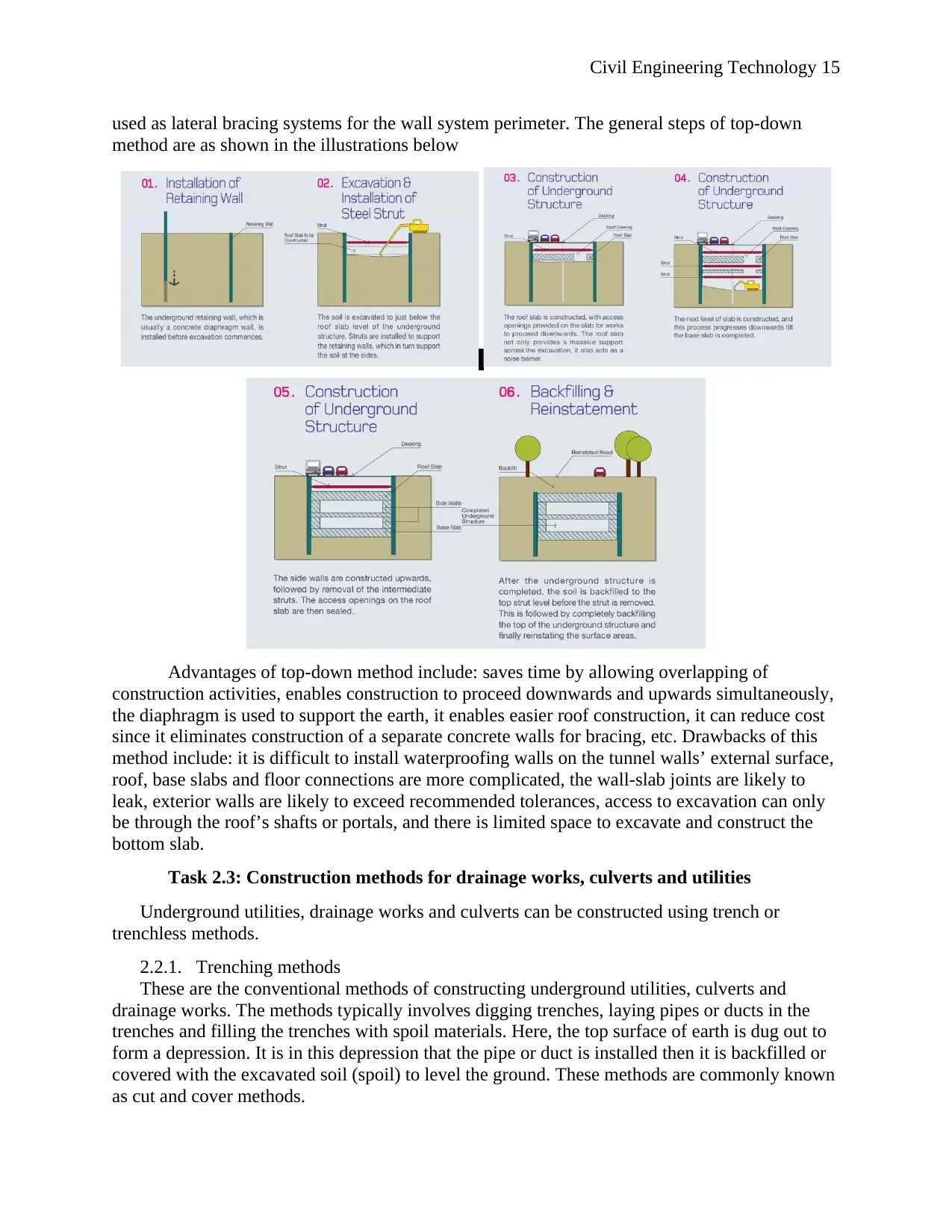
Civil Engineering Technology 15
used as lateral bracing systems for the wall system perimeter. The general steps of top-down
method are as shown in the illustrations below
Advantages of top-down method include: saves time by allowing overlapping of
construction activities, enables construction to proceed downwards and upwards simultaneously,
the diaphragm is used to support the earth, it enables easier roof construction, it can reduce cost
since it eliminates construction of a separate concrete walls for bracing, etc. Drawbacks of this
method include: it is difficult to install waterproofing walls on the tunnel walls’ external surface,
roof, base slabs and floor connections are more complicated, the wall-slab joints are likely to
leak, exterior walls are likely to exceed recommended tolerances, access to excavation can only
be through the roof’s shafts or portals, and there is limited space to excavate and construct the
bottom slab.
Task 2.3: Construction methods for drainage works, culverts and utilities
Underground utilities, drainage works and culverts can be constructed using trench or
trenchless methods.
2.2.1. Trenching methods
These are the conventional methods of constructing underground utilities, culverts and
drainage works. The methods typically involves digging trenches, laying pipes or ducts in the
trenches and filling the trenches with spoil materials. Here, the top surface of earth is dug out to
form a depression. It is in this depression that the pipe or duct is installed then it is backfilled or
covered with the excavated soil (spoil) to level the ground. These methods are commonly known
as cut and cover methods.
used as lateral bracing systems for the wall system perimeter. The general steps of top-down
method are as shown in the illustrations below
Advantages of top-down method include: saves time by allowing overlapping of
construction activities, enables construction to proceed downwards and upwards simultaneously,
the diaphragm is used to support the earth, it enables easier roof construction, it can reduce cost
since it eliminates construction of a separate concrete walls for bracing, etc. Drawbacks of this
method include: it is difficult to install waterproofing walls on the tunnel walls’ external surface,
roof, base slabs and floor connections are more complicated, the wall-slab joints are likely to
leak, exterior walls are likely to exceed recommended tolerances, access to excavation can only
be through the roof’s shafts or portals, and there is limited space to excavate and construct the
bottom slab.
Task 2.3: Construction methods for drainage works, culverts and utilities
Underground utilities, drainage works and culverts can be constructed using trench or
trenchless methods.
2.2.1. Trenching methods
These are the conventional methods of constructing underground utilities, culverts and
drainage works. The methods typically involves digging trenches, laying pipes or ducts in the
trenches and filling the trenches with spoil materials. Here, the top surface of earth is dug out to
form a depression. It is in this depression that the pipe or duct is installed then it is backfilled or
covered with the excavated soil (spoil) to level the ground. These methods are commonly known
as cut and cover methods.
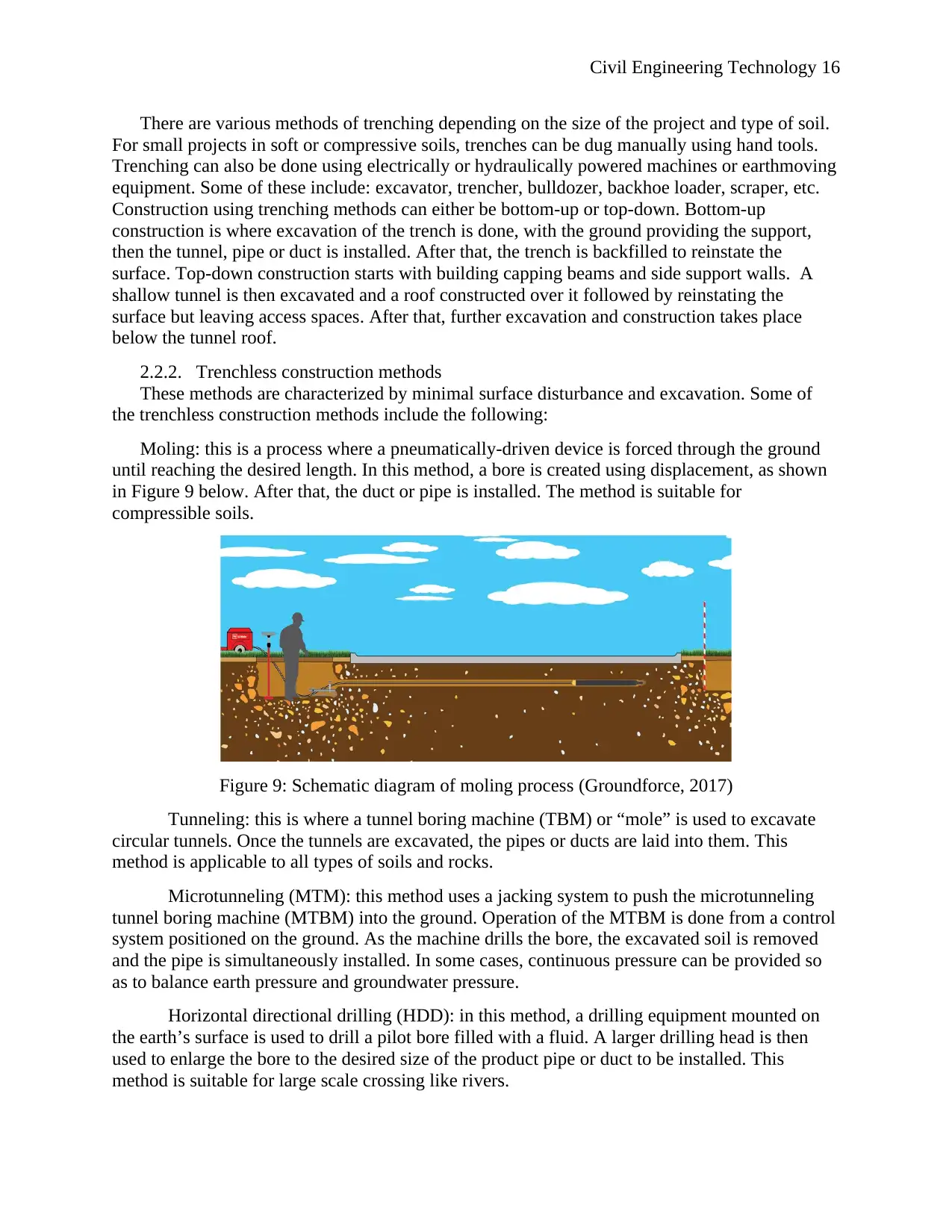
Civil Engineering Technology 16
There are various methods of trenching depending on the size of the project and type of soil.
For small projects in soft or compressive soils, trenches can be dug manually using hand tools.
Trenching can also be done using electrically or hydraulically powered machines or earthmoving
equipment. Some of these include: excavator, trencher, bulldozer, backhoe loader, scraper, etc.
Construction using trenching methods can either be bottom-up or top-down. Bottom-up
construction is where excavation of the trench is done, with the ground providing the support,
then the tunnel, pipe or duct is installed. After that, the trench is backfilled to reinstate the
surface. Top-down construction starts with building capping beams and side support walls. A
shallow tunnel is then excavated and a roof constructed over it followed by reinstating the
surface but leaving access spaces. After that, further excavation and construction takes place
below the tunnel roof.
2.2.2. Trenchless construction methods
These methods are characterized by minimal surface disturbance and excavation. Some of
the trenchless construction methods include the following:
Moling: this is a process where a pneumatically-driven device is forced through the ground
until reaching the desired length. In this method, a bore is created using displacement, as shown
in Figure 9 below. After that, the duct or pipe is installed. The method is suitable for
compressible soils.
Figure 9: Schematic diagram of moling process (Groundforce, 2017)
Tunneling: this is where a tunnel boring machine (TBM) or “mole” is used to excavate
circular tunnels. Once the tunnels are excavated, the pipes or ducts are laid into them. This
method is applicable to all types of soils and rocks.
Microtunneling (MTM): this method uses a jacking system to push the microtunneling
tunnel boring machine (MTBM) into the ground. Operation of the MTBM is done from a control
system positioned on the ground. As the machine drills the bore, the excavated soil is removed
and the pipe is simultaneously installed. In some cases, continuous pressure can be provided so
as to balance earth pressure and groundwater pressure.
Horizontal directional drilling (HDD): in this method, a drilling equipment mounted on
the earth’s surface is used to drill a pilot bore filled with a fluid. A larger drilling head is then
used to enlarge the bore to the desired size of the product pipe or duct to be installed. This
method is suitable for large scale crossing like rivers.
There are various methods of trenching depending on the size of the project and type of soil.
For small projects in soft or compressive soils, trenches can be dug manually using hand tools.
Trenching can also be done using electrically or hydraulically powered machines or earthmoving
equipment. Some of these include: excavator, trencher, bulldozer, backhoe loader, scraper, etc.
Construction using trenching methods can either be bottom-up or top-down. Bottom-up
construction is where excavation of the trench is done, with the ground providing the support,
then the tunnel, pipe or duct is installed. After that, the trench is backfilled to reinstate the
surface. Top-down construction starts with building capping beams and side support walls. A
shallow tunnel is then excavated and a roof constructed over it followed by reinstating the
surface but leaving access spaces. After that, further excavation and construction takes place
below the tunnel roof.
2.2.2. Trenchless construction methods
These methods are characterized by minimal surface disturbance and excavation. Some of
the trenchless construction methods include the following:
Moling: this is a process where a pneumatically-driven device is forced through the ground
until reaching the desired length. In this method, a bore is created using displacement, as shown
in Figure 9 below. After that, the duct or pipe is installed. The method is suitable for
compressible soils.
Figure 9: Schematic diagram of moling process (Groundforce, 2017)
Tunneling: this is where a tunnel boring machine (TBM) or “mole” is used to excavate
circular tunnels. Once the tunnels are excavated, the pipes or ducts are laid into them. This
method is applicable to all types of soils and rocks.
Microtunneling (MTM): this method uses a jacking system to push the microtunneling
tunnel boring machine (MTBM) into the ground. Operation of the MTBM is done from a control
system positioned on the ground. As the machine drills the bore, the excavated soil is removed
and the pipe is simultaneously installed. In some cases, continuous pressure can be provided so
as to balance earth pressure and groundwater pressure.
Horizontal directional drilling (HDD): in this method, a drilling equipment mounted on
the earth’s surface is used to drill a pilot bore filled with a fluid. A larger drilling head is then
used to enlarge the bore to the desired size of the product pipe or duct to be installed. This
method is suitable for large scale crossing like rivers.
Secure Best Marks with AI Grader
Need help grading? Try our AI Grader for instant feedback on your assignments.
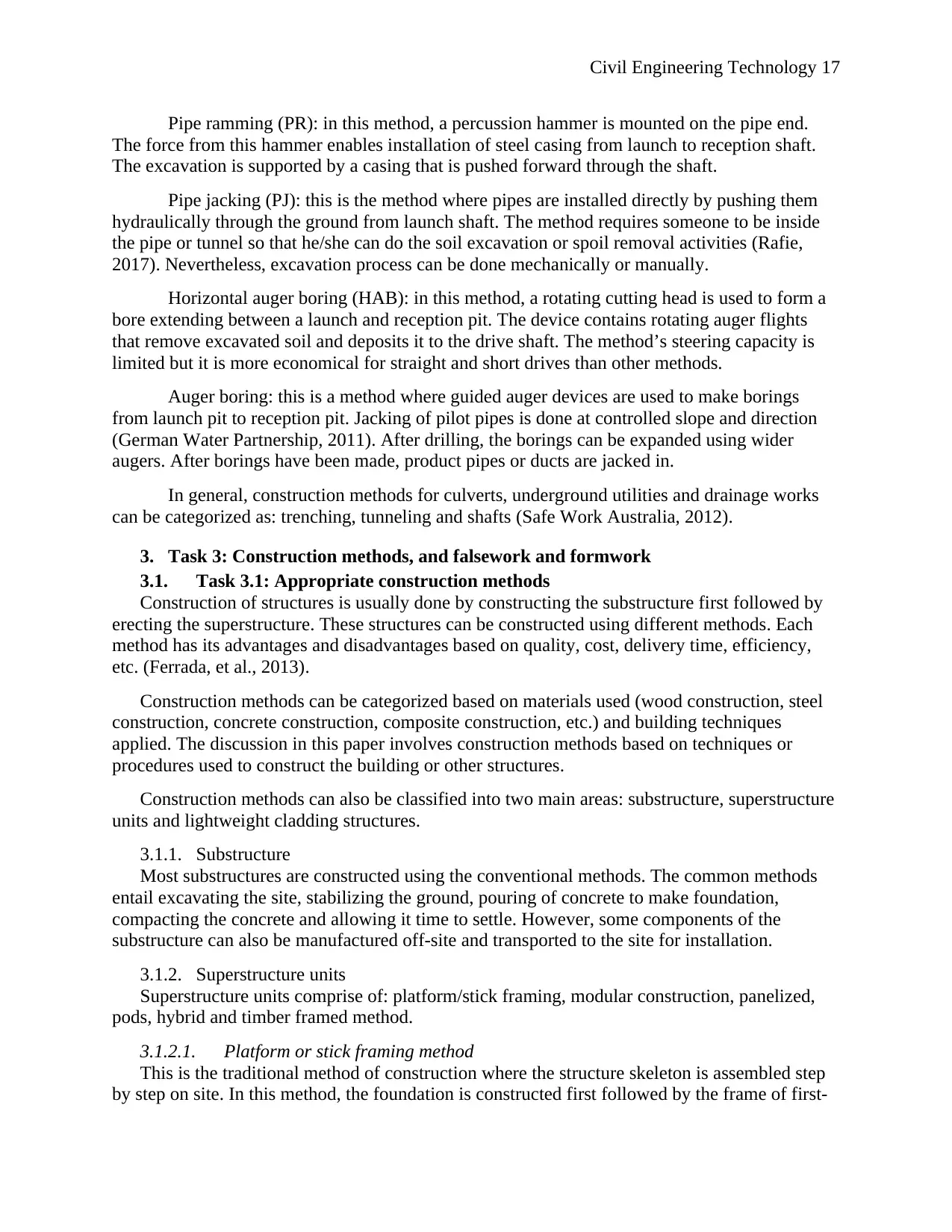
Civil Engineering Technology 17
Pipe ramming (PR): in this method, a percussion hammer is mounted on the pipe end.
The force from this hammer enables installation of steel casing from launch to reception shaft.
The excavation is supported by a casing that is pushed forward through the shaft.
Pipe jacking (PJ): this is the method where pipes are installed directly by pushing them
hydraulically through the ground from launch shaft. The method requires someone to be inside
the pipe or tunnel so that he/she can do the soil excavation or spoil removal activities (Rafie,
2017). Nevertheless, excavation process can be done mechanically or manually.
Horizontal auger boring (HAB): in this method, a rotating cutting head is used to form a
bore extending between a launch and reception pit. The device contains rotating auger flights
that remove excavated soil and deposits it to the drive shaft. The method’s steering capacity is
limited but it is more economical for straight and short drives than other methods.
Auger boring: this is a method where guided auger devices are used to make borings
from launch pit to reception pit. Jacking of pilot pipes is done at controlled slope and direction
(German Water Partnership, 2011). After drilling, the borings can be expanded using wider
augers. After borings have been made, product pipes or ducts are jacked in.
In general, construction methods for culverts, underground utilities and drainage works
can be categorized as: trenching, tunneling and shafts (Safe Work Australia, 2012).
3. Task 3: Construction methods, and falsework and formwork
3.1. Task 3.1: Appropriate construction methods
Construction of structures is usually done by constructing the substructure first followed by
erecting the superstructure. These structures can be constructed using different methods. Each
method has its advantages and disadvantages based on quality, cost, delivery time, efficiency,
etc. (Ferrada, et al., 2013).
Construction methods can be categorized based on materials used (wood construction, steel
construction, concrete construction, composite construction, etc.) and building techniques
applied. The discussion in this paper involves construction methods based on techniques or
procedures used to construct the building or other structures.
Construction methods can also be classified into two main areas: substructure, superstructure
units and lightweight cladding structures.
3.1.1. Substructure
Most substructures are constructed using the conventional methods. The common methods
entail excavating the site, stabilizing the ground, pouring of concrete to make foundation,
compacting the concrete and allowing it time to settle. However, some components of the
substructure can also be manufactured off-site and transported to the site for installation.
3.1.2. Superstructure units
Superstructure units comprise of: platform/stick framing, modular construction, panelized,
pods, hybrid and timber framed method.
3.1.2.1. Platform or stick framing method
This is the traditional method of construction where the structure skeleton is assembled step
by step on site. In this method, the foundation is constructed first followed by the frame of first-
Pipe ramming (PR): in this method, a percussion hammer is mounted on the pipe end.
The force from this hammer enables installation of steel casing from launch to reception shaft.
The excavation is supported by a casing that is pushed forward through the shaft.
Pipe jacking (PJ): this is the method where pipes are installed directly by pushing them
hydraulically through the ground from launch shaft. The method requires someone to be inside
the pipe or tunnel so that he/she can do the soil excavation or spoil removal activities (Rafie,
2017). Nevertheless, excavation process can be done mechanically or manually.
Horizontal auger boring (HAB): in this method, a rotating cutting head is used to form a
bore extending between a launch and reception pit. The device contains rotating auger flights
that remove excavated soil and deposits it to the drive shaft. The method’s steering capacity is
limited but it is more economical for straight and short drives than other methods.
Auger boring: this is a method where guided auger devices are used to make borings
from launch pit to reception pit. Jacking of pilot pipes is done at controlled slope and direction
(German Water Partnership, 2011). After drilling, the borings can be expanded using wider
augers. After borings have been made, product pipes or ducts are jacked in.
In general, construction methods for culverts, underground utilities and drainage works
can be categorized as: trenching, tunneling and shafts (Safe Work Australia, 2012).
3. Task 3: Construction methods, and falsework and formwork
3.1. Task 3.1: Appropriate construction methods
Construction of structures is usually done by constructing the substructure first followed by
erecting the superstructure. These structures can be constructed using different methods. Each
method has its advantages and disadvantages based on quality, cost, delivery time, efficiency,
etc. (Ferrada, et al., 2013).
Construction methods can be categorized based on materials used (wood construction, steel
construction, concrete construction, composite construction, etc.) and building techniques
applied. The discussion in this paper involves construction methods based on techniques or
procedures used to construct the building or other structures.
Construction methods can also be classified into two main areas: substructure, superstructure
units and lightweight cladding structures.
3.1.1. Substructure
Most substructures are constructed using the conventional methods. The common methods
entail excavating the site, stabilizing the ground, pouring of concrete to make foundation,
compacting the concrete and allowing it time to settle. However, some components of the
substructure can also be manufactured off-site and transported to the site for installation.
3.1.2. Superstructure units
Superstructure units comprise of: platform/stick framing, modular construction, panelized,
pods, hybrid and timber framed method.
3.1.2.1. Platform or stick framing method
This is the traditional method of construction where the structure skeleton is assembled step
by step on site. In this method, the foundation is constructed first followed by the frame of first-
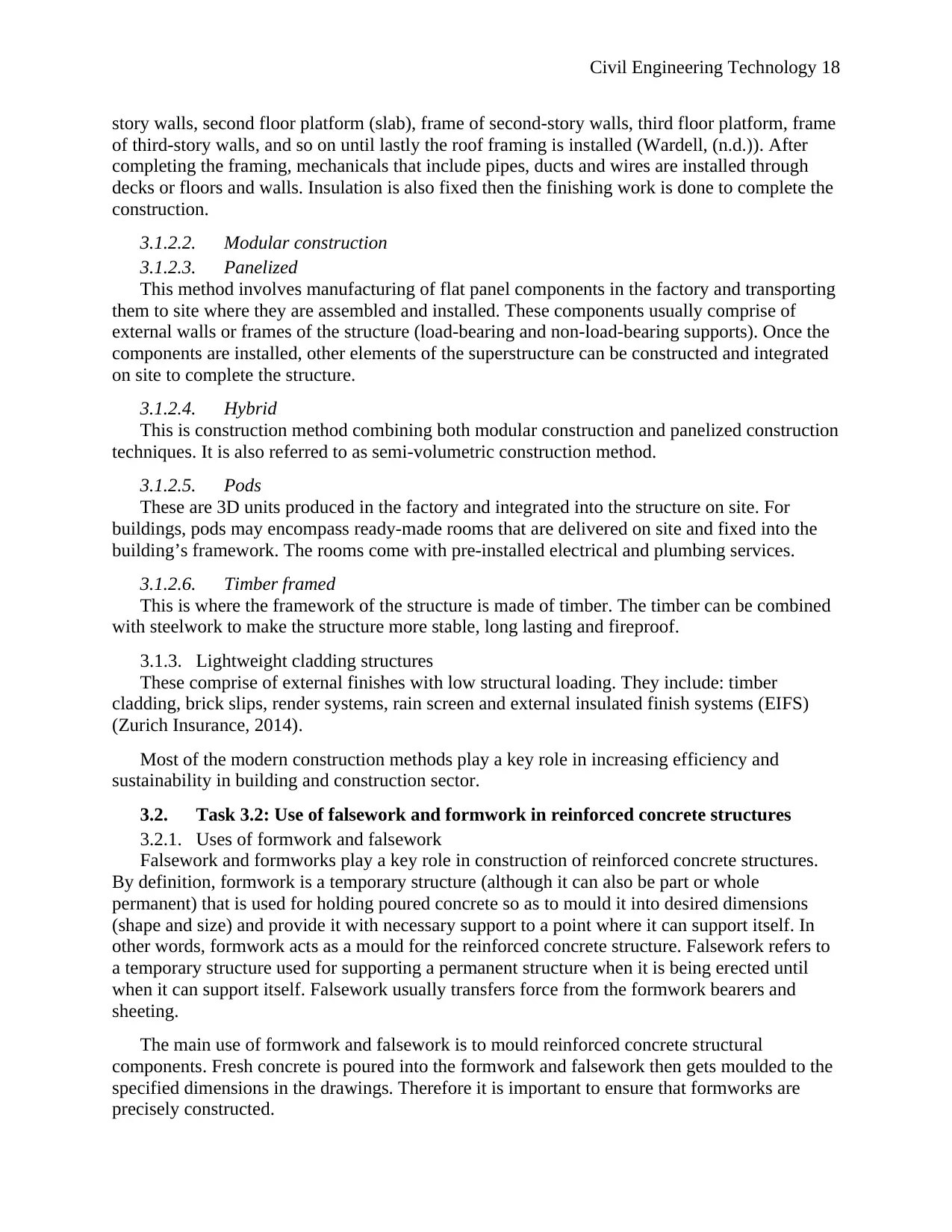
Civil Engineering Technology 18
story walls, second floor platform (slab), frame of second-story walls, third floor platform, frame
of third-story walls, and so on until lastly the roof framing is installed (Wardell, (n.d.)). After
completing the framing, mechanicals that include pipes, ducts and wires are installed through
decks or floors and walls. Insulation is also fixed then the finishing work is done to complete the
construction.
3.1.2.2. Modular construction
3.1.2.3. Panelized
This method involves manufacturing of flat panel components in the factory and transporting
them to site where they are assembled and installed. These components usually comprise of
external walls or frames of the structure (load-bearing and non-load-bearing supports). Once the
components are installed, other elements of the superstructure can be constructed and integrated
on site to complete the structure.
3.1.2.4. Hybrid
This is construction method combining both modular construction and panelized construction
techniques. It is also referred to as semi-volumetric construction method.
3.1.2.5. Pods
These are 3D units produced in the factory and integrated into the structure on site. For
buildings, pods may encompass ready-made rooms that are delivered on site and fixed into the
building’s framework. The rooms come with pre-installed electrical and plumbing services.
3.1.2.6. Timber framed
This is where the framework of the structure is made of timber. The timber can be combined
with steelwork to make the structure more stable, long lasting and fireproof.
3.1.3. Lightweight cladding structures
These comprise of external finishes with low structural loading. They include: timber
cladding, brick slips, render systems, rain screen and external insulated finish systems (EIFS)
(Zurich Insurance, 2014).
Most of the modern construction methods play a key role in increasing efficiency and
sustainability in building and construction sector.
3.2. Task 3.2: Use of falsework and formwork in reinforced concrete structures
3.2.1. Uses of formwork and falsework
Falsework and formworks play a key role in construction of reinforced concrete structures.
By definition, formwork is a temporary structure (although it can also be part or whole
permanent) that is used for holding poured concrete so as to mould it into desired dimensions
(shape and size) and provide it with necessary support to a point where it can support itself. In
other words, formwork acts as a mould for the reinforced concrete structure. Falsework refers to
a temporary structure used for supporting a permanent structure when it is being erected until
when it can support itself. Falsework usually transfers force from the formwork bearers and
sheeting.
The main use of formwork and falsework is to mould reinforced concrete structural
components. Fresh concrete is poured into the formwork and falsework then gets moulded to the
specified dimensions in the drawings. Therefore it is important to ensure that formworks are
precisely constructed.
story walls, second floor platform (slab), frame of second-story walls, third floor platform, frame
of third-story walls, and so on until lastly the roof framing is installed (Wardell, (n.d.)). After
completing the framing, mechanicals that include pipes, ducts and wires are installed through
decks or floors and walls. Insulation is also fixed then the finishing work is done to complete the
construction.
3.1.2.2. Modular construction
3.1.2.3. Panelized
This method involves manufacturing of flat panel components in the factory and transporting
them to site where they are assembled and installed. These components usually comprise of
external walls or frames of the structure (load-bearing and non-load-bearing supports). Once the
components are installed, other elements of the superstructure can be constructed and integrated
on site to complete the structure.
3.1.2.4. Hybrid
This is construction method combining both modular construction and panelized construction
techniques. It is also referred to as semi-volumetric construction method.
3.1.2.5. Pods
These are 3D units produced in the factory and integrated into the structure on site. For
buildings, pods may encompass ready-made rooms that are delivered on site and fixed into the
building’s framework. The rooms come with pre-installed electrical and plumbing services.
3.1.2.6. Timber framed
This is where the framework of the structure is made of timber. The timber can be combined
with steelwork to make the structure more stable, long lasting and fireproof.
3.1.3. Lightweight cladding structures
These comprise of external finishes with low structural loading. They include: timber
cladding, brick slips, render systems, rain screen and external insulated finish systems (EIFS)
(Zurich Insurance, 2014).
Most of the modern construction methods play a key role in increasing efficiency and
sustainability in building and construction sector.
3.2. Task 3.2: Use of falsework and formwork in reinforced concrete structures
3.2.1. Uses of formwork and falsework
Falsework and formworks play a key role in construction of reinforced concrete structures.
By definition, formwork is a temporary structure (although it can also be part or whole
permanent) that is used for holding poured concrete so as to mould it into desired dimensions
(shape and size) and provide it with necessary support to a point where it can support itself. In
other words, formwork acts as a mould for the reinforced concrete structure. Falsework refers to
a temporary structure used for supporting a permanent structure when it is being erected until
when it can support itself. Falsework usually transfers force from the formwork bearers and
sheeting.
The main use of formwork and falsework is to mould reinforced concrete structural
components. Fresh concrete is poured into the formwork and falsework then gets moulded to the
specified dimensions in the drawings. Therefore it is important to ensure that formworks are
precisely constructed.
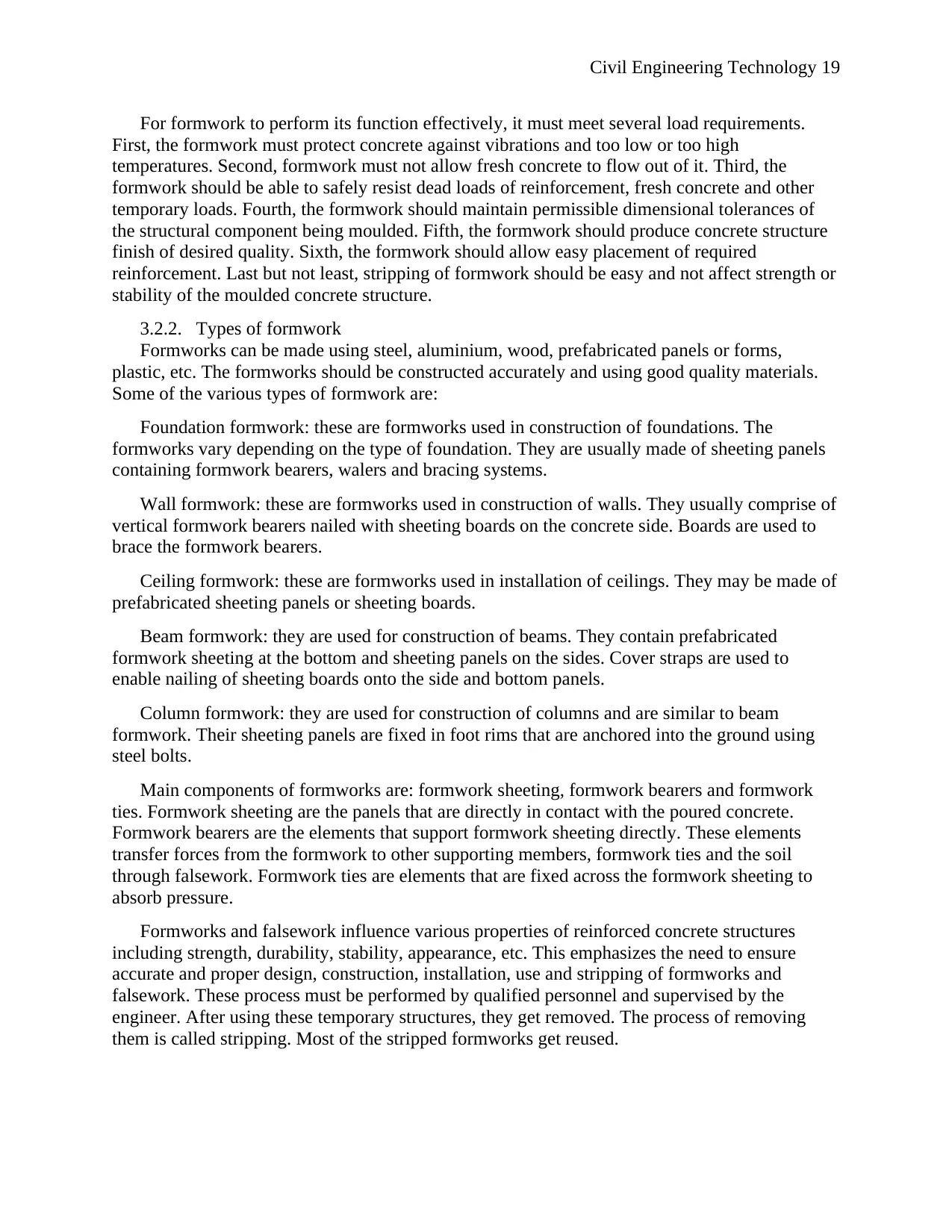
Civil Engineering Technology 19
For formwork to perform its function effectively, it must meet several load requirements.
First, the formwork must protect concrete against vibrations and too low or too high
temperatures. Second, formwork must not allow fresh concrete to flow out of it. Third, the
formwork should be able to safely resist dead loads of reinforcement, fresh concrete and other
temporary loads. Fourth, the formwork should maintain permissible dimensional tolerances of
the structural component being moulded. Fifth, the formwork should produce concrete structure
finish of desired quality. Sixth, the formwork should allow easy placement of required
reinforcement. Last but not least, stripping of formwork should be easy and not affect strength or
stability of the moulded concrete structure.
3.2.2. Types of formwork
Formworks can be made using steel, aluminium, wood, prefabricated panels or forms,
plastic, etc. The formworks should be constructed accurately and using good quality materials.
Some of the various types of formwork are:
Foundation formwork: these are formworks used in construction of foundations. The
formworks vary depending on the type of foundation. They are usually made of sheeting panels
containing formwork bearers, walers and bracing systems.
Wall formwork: these are formworks used in construction of walls. They usually comprise of
vertical formwork bearers nailed with sheeting boards on the concrete side. Boards are used to
brace the formwork bearers.
Ceiling formwork: these are formworks used in installation of ceilings. They may be made of
prefabricated sheeting panels or sheeting boards.
Beam formwork: they are used for construction of beams. They contain prefabricated
formwork sheeting at the bottom and sheeting panels on the sides. Cover straps are used to
enable nailing of sheeting boards onto the side and bottom panels.
Column formwork: they are used for construction of columns and are similar to beam
formwork. Their sheeting panels are fixed in foot rims that are anchored into the ground using
steel bolts.
Main components of formworks are: formwork sheeting, formwork bearers and formwork
ties. Formwork sheeting are the panels that are directly in contact with the poured concrete.
Formwork bearers are the elements that support formwork sheeting directly. These elements
transfer forces from the formwork to other supporting members, formwork ties and the soil
through falsework. Formwork ties are elements that are fixed across the formwork sheeting to
absorb pressure.
Formworks and falsework influence various properties of reinforced concrete structures
including strength, durability, stability, appearance, etc. This emphasizes the need to ensure
accurate and proper design, construction, installation, use and stripping of formworks and
falsework. These process must be performed by qualified personnel and supervised by the
engineer. After using these temporary structures, they get removed. The process of removing
them is called stripping. Most of the stripped formworks get reused.
For formwork to perform its function effectively, it must meet several load requirements.
First, the formwork must protect concrete against vibrations and too low or too high
temperatures. Second, formwork must not allow fresh concrete to flow out of it. Third, the
formwork should be able to safely resist dead loads of reinforcement, fresh concrete and other
temporary loads. Fourth, the formwork should maintain permissible dimensional tolerances of
the structural component being moulded. Fifth, the formwork should produce concrete structure
finish of desired quality. Sixth, the formwork should allow easy placement of required
reinforcement. Last but not least, stripping of formwork should be easy and not affect strength or
stability of the moulded concrete structure.
3.2.2. Types of formwork
Formworks can be made using steel, aluminium, wood, prefabricated panels or forms,
plastic, etc. The formworks should be constructed accurately and using good quality materials.
Some of the various types of formwork are:
Foundation formwork: these are formworks used in construction of foundations. The
formworks vary depending on the type of foundation. They are usually made of sheeting panels
containing formwork bearers, walers and bracing systems.
Wall formwork: these are formworks used in construction of walls. They usually comprise of
vertical formwork bearers nailed with sheeting boards on the concrete side. Boards are used to
brace the formwork bearers.
Ceiling formwork: these are formworks used in installation of ceilings. They may be made of
prefabricated sheeting panels or sheeting boards.
Beam formwork: they are used for construction of beams. They contain prefabricated
formwork sheeting at the bottom and sheeting panels on the sides. Cover straps are used to
enable nailing of sheeting boards onto the side and bottom panels.
Column formwork: they are used for construction of columns and are similar to beam
formwork. Their sheeting panels are fixed in foot rims that are anchored into the ground using
steel bolts.
Main components of formworks are: formwork sheeting, formwork bearers and formwork
ties. Formwork sheeting are the panels that are directly in contact with the poured concrete.
Formwork bearers are the elements that support formwork sheeting directly. These elements
transfer forces from the formwork to other supporting members, formwork ties and the soil
through falsework. Formwork ties are elements that are fixed across the formwork sheeting to
absorb pressure.
Formworks and falsework influence various properties of reinforced concrete structures
including strength, durability, stability, appearance, etc. This emphasizes the need to ensure
accurate and proper design, construction, installation, use and stripping of formworks and
falsework. These process must be performed by qualified personnel and supervised by the
engineer. After using these temporary structures, they get removed. The process of removing
them is called stripping. Most of the stripped formworks get reused.
Paraphrase This Document
Need a fresh take? Get an instant paraphrase of this document with our AI Paraphraser
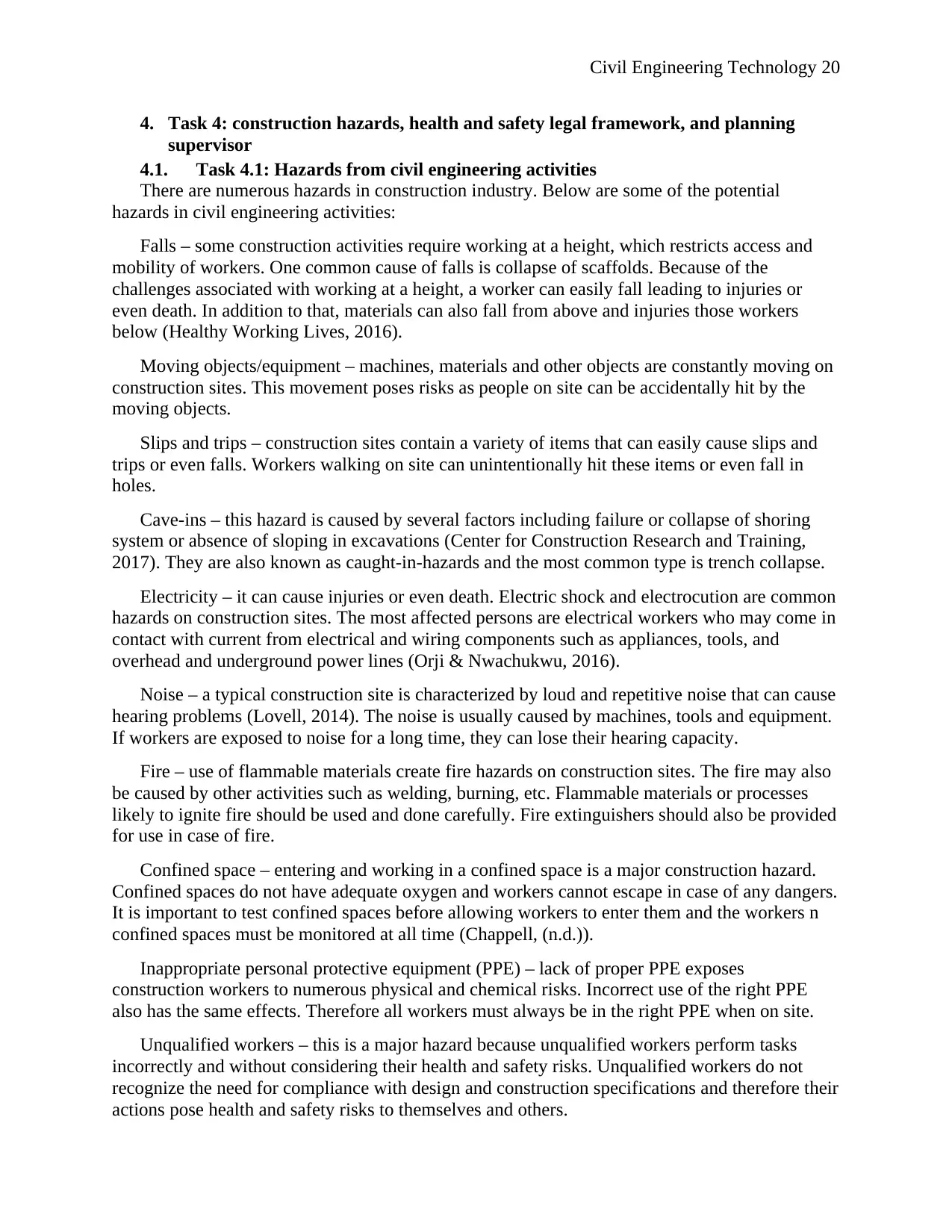
Civil Engineering Technology 20
4. Task 4: construction hazards, health and safety legal framework, and planning
supervisor
4.1. Task 4.1: Hazards from civil engineering activities
There are numerous hazards in construction industry. Below are some of the potential
hazards in civil engineering activities:
Falls – some construction activities require working at a height, which restricts access and
mobility of workers. One common cause of falls is collapse of scaffolds. Because of the
challenges associated with working at a height, a worker can easily fall leading to injuries or
even death. In addition to that, materials can also fall from above and injuries those workers
below (Healthy Working Lives, 2016).
Moving objects/equipment – machines, materials and other objects are constantly moving on
construction sites. This movement poses risks as people on site can be accidentally hit by the
moving objects.
Slips and trips – construction sites contain a variety of items that can easily cause slips and
trips or even falls. Workers walking on site can unintentionally hit these items or even fall in
holes.
Cave-ins – this hazard is caused by several factors including failure or collapse of shoring
system or absence of sloping in excavations (Center for Construction Research and Training,
2017). They are also known as caught-in-hazards and the most common type is trench collapse.
Electricity – it can cause injuries or even death. Electric shock and electrocution are common
hazards on construction sites. The most affected persons are electrical workers who may come in
contact with current from electrical and wiring components such as appliances, tools, and
overhead and underground power lines (Orji & Nwachukwu, 2016).
Noise – a typical construction site is characterized by loud and repetitive noise that can cause
hearing problems (Lovell, 2014). The noise is usually caused by machines, tools and equipment.
If workers are exposed to noise for a long time, they can lose their hearing capacity.
Fire – use of flammable materials create fire hazards on construction sites. The fire may also
be caused by other activities such as welding, burning, etc. Flammable materials or processes
likely to ignite fire should be used and done carefully. Fire extinguishers should also be provided
for use in case of fire.
Confined space – entering and working in a confined space is a major construction hazard.
Confined spaces do not have adequate oxygen and workers cannot escape in case of any dangers.
It is important to test confined spaces before allowing workers to enter them and the workers n
confined spaces must be monitored at all time (Chappell, (n.d.)).
Inappropriate personal protective equipment (PPE) – lack of proper PPE exposes
construction workers to numerous physical and chemical risks. Incorrect use of the right PPE
also has the same effects. Therefore all workers must always be in the right PPE when on site.
Unqualified workers – this is a major hazard because unqualified workers perform tasks
incorrectly and without considering their health and safety risks. Unqualified workers do not
recognize the need for compliance with design and construction specifications and therefore their
actions pose health and safety risks to themselves and others.
4. Task 4: construction hazards, health and safety legal framework, and planning
supervisor
4.1. Task 4.1: Hazards from civil engineering activities
There are numerous hazards in construction industry. Below are some of the potential
hazards in civil engineering activities:
Falls – some construction activities require working at a height, which restricts access and
mobility of workers. One common cause of falls is collapse of scaffolds. Because of the
challenges associated with working at a height, a worker can easily fall leading to injuries or
even death. In addition to that, materials can also fall from above and injuries those workers
below (Healthy Working Lives, 2016).
Moving objects/equipment – machines, materials and other objects are constantly moving on
construction sites. This movement poses risks as people on site can be accidentally hit by the
moving objects.
Slips and trips – construction sites contain a variety of items that can easily cause slips and
trips or even falls. Workers walking on site can unintentionally hit these items or even fall in
holes.
Cave-ins – this hazard is caused by several factors including failure or collapse of shoring
system or absence of sloping in excavations (Center for Construction Research and Training,
2017). They are also known as caught-in-hazards and the most common type is trench collapse.
Electricity – it can cause injuries or even death. Electric shock and electrocution are common
hazards on construction sites. The most affected persons are electrical workers who may come in
contact with current from electrical and wiring components such as appliances, tools, and
overhead and underground power lines (Orji & Nwachukwu, 2016).
Noise – a typical construction site is characterized by loud and repetitive noise that can cause
hearing problems (Lovell, 2014). The noise is usually caused by machines, tools and equipment.
If workers are exposed to noise for a long time, they can lose their hearing capacity.
Fire – use of flammable materials create fire hazards on construction sites. The fire may also
be caused by other activities such as welding, burning, etc. Flammable materials or processes
likely to ignite fire should be used and done carefully. Fire extinguishers should also be provided
for use in case of fire.
Confined space – entering and working in a confined space is a major construction hazard.
Confined spaces do not have adequate oxygen and workers cannot escape in case of any dangers.
It is important to test confined spaces before allowing workers to enter them and the workers n
confined spaces must be monitored at all time (Chappell, (n.d.)).
Inappropriate personal protective equipment (PPE) – lack of proper PPE exposes
construction workers to numerous physical and chemical risks. Incorrect use of the right PPE
also has the same effects. Therefore all workers must always be in the right PPE when on site.
Unqualified workers – this is a major hazard because unqualified workers perform tasks
incorrectly and without considering their health and safety risks. Unqualified workers do not
recognize the need for compliance with design and construction specifications and therefore their
actions pose health and safety risks to themselves and others.
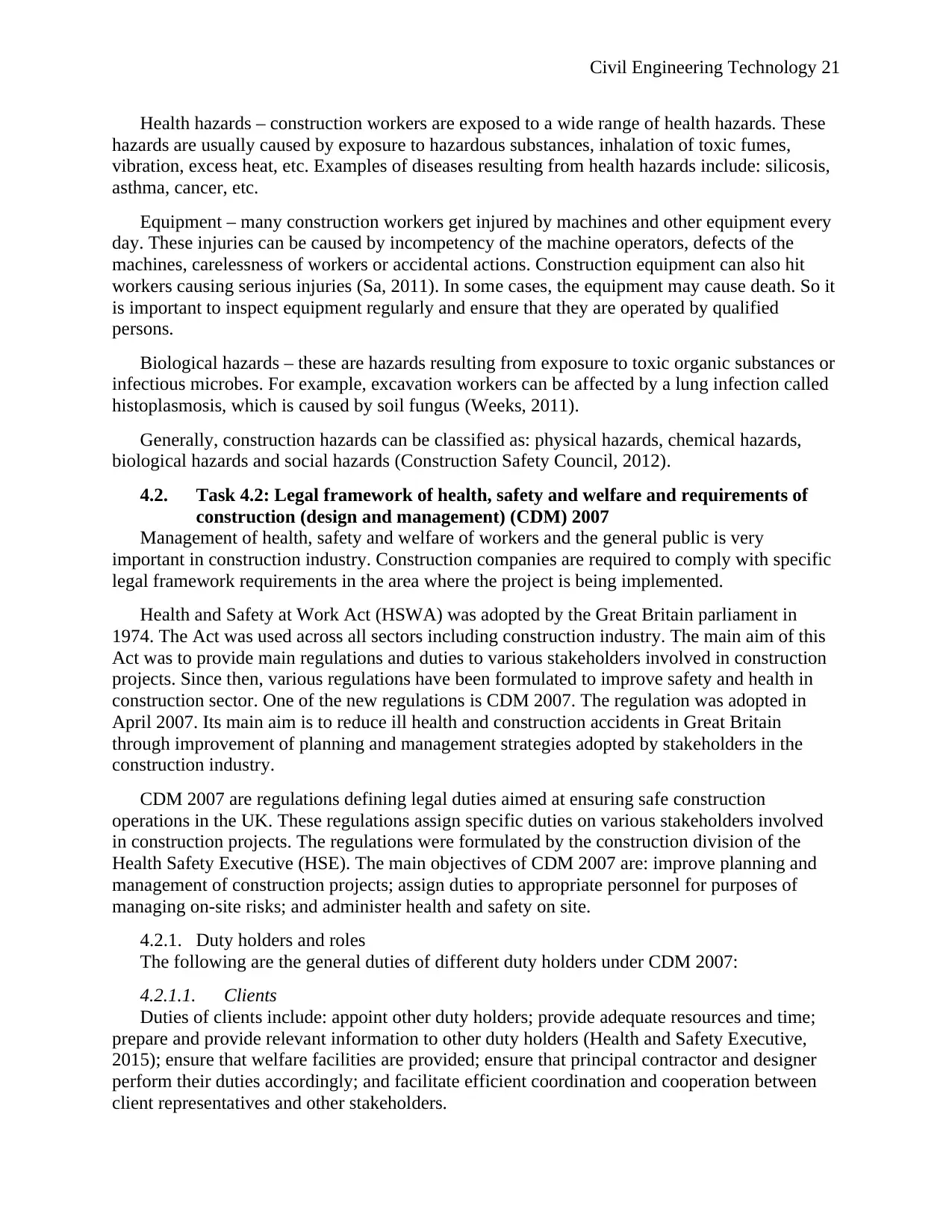
Civil Engineering Technology 21
Health hazards – construction workers are exposed to a wide range of health hazards. These
hazards are usually caused by exposure to hazardous substances, inhalation of toxic fumes,
vibration, excess heat, etc. Examples of diseases resulting from health hazards include: silicosis,
asthma, cancer, etc.
Equipment – many construction workers get injured by machines and other equipment every
day. These injuries can be caused by incompetency of the machine operators, defects of the
machines, carelessness of workers or accidental actions. Construction equipment can also hit
workers causing serious injuries (Sa, 2011). In some cases, the equipment may cause death. So it
is important to inspect equipment regularly and ensure that they are operated by qualified
persons.
Biological hazards – these are hazards resulting from exposure to toxic organic substances or
infectious microbes. For example, excavation workers can be affected by a lung infection called
histoplasmosis, which is caused by soil fungus (Weeks, 2011).
Generally, construction hazards can be classified as: physical hazards, chemical hazards,
biological hazards and social hazards (Construction Safety Council, 2012).
4.2. Task 4.2: Legal framework of health, safety and welfare and requirements of
construction (design and management) (CDM) 2007
Management of health, safety and welfare of workers and the general public is very
important in construction industry. Construction companies are required to comply with specific
legal framework requirements in the area where the project is being implemented.
Health and Safety at Work Act (HSWA) was adopted by the Great Britain parliament in
1974. The Act was used across all sectors including construction industry. The main aim of this
Act was to provide main regulations and duties to various stakeholders involved in construction
projects. Since then, various regulations have been formulated to improve safety and health in
construction sector. One of the new regulations is CDM 2007. The regulation was adopted in
April 2007. Its main aim is to reduce ill health and construction accidents in Great Britain
through improvement of planning and management strategies adopted by stakeholders in the
construction industry.
CDM 2007 are regulations defining legal duties aimed at ensuring safe construction
operations in the UK. These regulations assign specific duties on various stakeholders involved
in construction projects. The regulations were formulated by the construction division of the
Health Safety Executive (HSE). The main objectives of CDM 2007 are: improve planning and
management of construction projects; assign duties to appropriate personnel for purposes of
managing on-site risks; and administer health and safety on site.
4.2.1. Duty holders and roles
The following are the general duties of different duty holders under CDM 2007:
4.2.1.1. Clients
Duties of clients include: appoint other duty holders; provide adequate resources and time;
prepare and provide relevant information to other duty holders (Health and Safety Executive,
2015); ensure that welfare facilities are provided; ensure that principal contractor and designer
perform their duties accordingly; and facilitate efficient coordination and cooperation between
client representatives and other stakeholders.
Health hazards – construction workers are exposed to a wide range of health hazards. These
hazards are usually caused by exposure to hazardous substances, inhalation of toxic fumes,
vibration, excess heat, etc. Examples of diseases resulting from health hazards include: silicosis,
asthma, cancer, etc.
Equipment – many construction workers get injured by machines and other equipment every
day. These injuries can be caused by incompetency of the machine operators, defects of the
machines, carelessness of workers or accidental actions. Construction equipment can also hit
workers causing serious injuries (Sa, 2011). In some cases, the equipment may cause death. So it
is important to inspect equipment regularly and ensure that they are operated by qualified
persons.
Biological hazards – these are hazards resulting from exposure to toxic organic substances or
infectious microbes. For example, excavation workers can be affected by a lung infection called
histoplasmosis, which is caused by soil fungus (Weeks, 2011).
Generally, construction hazards can be classified as: physical hazards, chemical hazards,
biological hazards and social hazards (Construction Safety Council, 2012).
4.2. Task 4.2: Legal framework of health, safety and welfare and requirements of
construction (design and management) (CDM) 2007
Management of health, safety and welfare of workers and the general public is very
important in construction industry. Construction companies are required to comply with specific
legal framework requirements in the area where the project is being implemented.
Health and Safety at Work Act (HSWA) was adopted by the Great Britain parliament in
1974. The Act was used across all sectors including construction industry. The main aim of this
Act was to provide main regulations and duties to various stakeholders involved in construction
projects. Since then, various regulations have been formulated to improve safety and health in
construction sector. One of the new regulations is CDM 2007. The regulation was adopted in
April 2007. Its main aim is to reduce ill health and construction accidents in Great Britain
through improvement of planning and management strategies adopted by stakeholders in the
construction industry.
CDM 2007 are regulations defining legal duties aimed at ensuring safe construction
operations in the UK. These regulations assign specific duties on various stakeholders involved
in construction projects. The regulations were formulated by the construction division of the
Health Safety Executive (HSE). The main objectives of CDM 2007 are: improve planning and
management of construction projects; assign duties to appropriate personnel for purposes of
managing on-site risks; and administer health and safety on site.
4.2.1. Duty holders and roles
The following are the general duties of different duty holders under CDM 2007:
4.2.1.1. Clients
Duties of clients include: appoint other duty holders; provide adequate resources and time;
prepare and provide relevant information to other duty holders (Health and Safety Executive,
2015); ensure that welfare facilities are provided; ensure that principal contractor and designer
perform their duties accordingly; and facilitate efficient coordination and cooperation between
client representatives and other stakeholders.
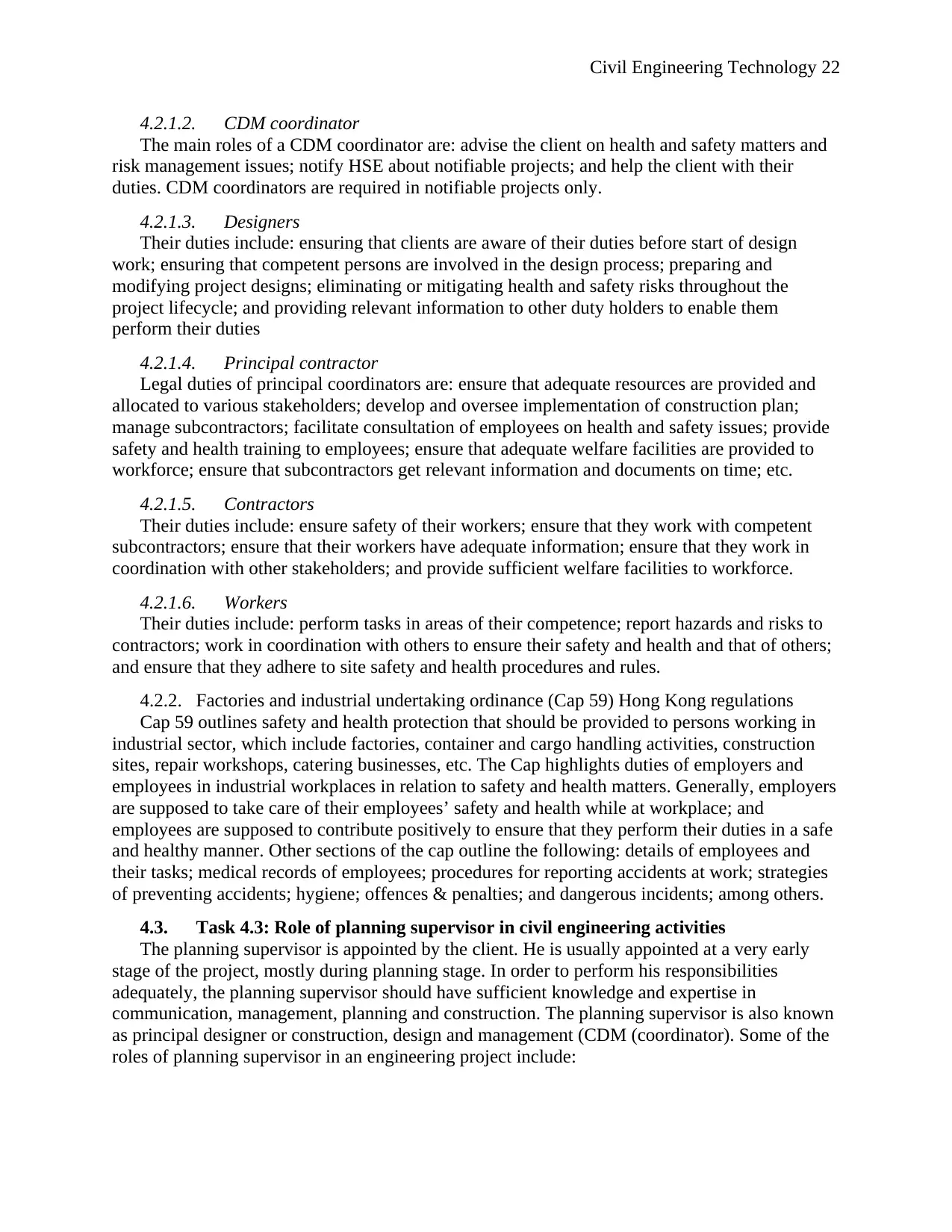
Civil Engineering Technology 22
4.2.1.2. CDM coordinator
The main roles of a CDM coordinator are: advise the client on health and safety matters and
risk management issues; notify HSE about notifiable projects; and help the client with their
duties. CDM coordinators are required in notifiable projects only.
4.2.1.3. Designers
Their duties include: ensuring that clients are aware of their duties before start of design
work; ensuring that competent persons are involved in the design process; preparing and
modifying project designs; eliminating or mitigating health and safety risks throughout the
project lifecycle; and providing relevant information to other duty holders to enable them
perform their duties
4.2.1.4. Principal contractor
Legal duties of principal coordinators are: ensure that adequate resources are provided and
allocated to various stakeholders; develop and oversee implementation of construction plan;
manage subcontractors; facilitate consultation of employees on health and safety issues; provide
safety and health training to employees; ensure that adequate welfare facilities are provided to
workforce; ensure that subcontractors get relevant information and documents on time; etc.
4.2.1.5. Contractors
Their duties include: ensure safety of their workers; ensure that they work with competent
subcontractors; ensure that their workers have adequate information; ensure that they work in
coordination with other stakeholders; and provide sufficient welfare facilities to workforce.
4.2.1.6. Workers
Their duties include: perform tasks in areas of their competence; report hazards and risks to
contractors; work in coordination with others to ensure their safety and health and that of others;
and ensure that they adhere to site safety and health procedures and rules.
4.2.2. Factories and industrial undertaking ordinance (Cap 59) Hong Kong regulations
Cap 59 outlines safety and health protection that should be provided to persons working in
industrial sector, which include factories, container and cargo handling activities, construction
sites, repair workshops, catering businesses, etc. The Cap highlights duties of employers and
employees in industrial workplaces in relation to safety and health matters. Generally, employers
are supposed to take care of their employees’ safety and health while at workplace; and
employees are supposed to contribute positively to ensure that they perform their duties in a safe
and healthy manner. Other sections of the cap outline the following: details of employees and
their tasks; medical records of employees; procedures for reporting accidents at work; strategies
of preventing accidents; hygiene; offences & penalties; and dangerous incidents; among others.
4.3. Task 4.3: Role of planning supervisor in civil engineering activities
The planning supervisor is appointed by the client. He is usually appointed at a very early
stage of the project, mostly during planning stage. In order to perform his responsibilities
adequately, the planning supervisor should have sufficient knowledge and expertise in
communication, management, planning and construction. The planning supervisor is also known
as principal designer or construction, design and management (CDM (coordinator). Some of the
roles of planning supervisor in an engineering project include:
4.2.1.2. CDM coordinator
The main roles of a CDM coordinator are: advise the client on health and safety matters and
risk management issues; notify HSE about notifiable projects; and help the client with their
duties. CDM coordinators are required in notifiable projects only.
4.2.1.3. Designers
Their duties include: ensuring that clients are aware of their duties before start of design
work; ensuring that competent persons are involved in the design process; preparing and
modifying project designs; eliminating or mitigating health and safety risks throughout the
project lifecycle; and providing relevant information to other duty holders to enable them
perform their duties
4.2.1.4. Principal contractor
Legal duties of principal coordinators are: ensure that adequate resources are provided and
allocated to various stakeholders; develop and oversee implementation of construction plan;
manage subcontractors; facilitate consultation of employees on health and safety issues; provide
safety and health training to employees; ensure that adequate welfare facilities are provided to
workforce; ensure that subcontractors get relevant information and documents on time; etc.
4.2.1.5. Contractors
Their duties include: ensure safety of their workers; ensure that they work with competent
subcontractors; ensure that their workers have adequate information; ensure that they work in
coordination with other stakeholders; and provide sufficient welfare facilities to workforce.
4.2.1.6. Workers
Their duties include: perform tasks in areas of their competence; report hazards and risks to
contractors; work in coordination with others to ensure their safety and health and that of others;
and ensure that they adhere to site safety and health procedures and rules.
4.2.2. Factories and industrial undertaking ordinance (Cap 59) Hong Kong regulations
Cap 59 outlines safety and health protection that should be provided to persons working in
industrial sector, which include factories, container and cargo handling activities, construction
sites, repair workshops, catering businesses, etc. The Cap highlights duties of employers and
employees in industrial workplaces in relation to safety and health matters. Generally, employers
are supposed to take care of their employees’ safety and health while at workplace; and
employees are supposed to contribute positively to ensure that they perform their duties in a safe
and healthy manner. Other sections of the cap outline the following: details of employees and
their tasks; medical records of employees; procedures for reporting accidents at work; strategies
of preventing accidents; hygiene; offences & penalties; and dangerous incidents; among others.
4.3. Task 4.3: Role of planning supervisor in civil engineering activities
The planning supervisor is appointed by the client. He is usually appointed at a very early
stage of the project, mostly during planning stage. In order to perform his responsibilities
adequately, the planning supervisor should have sufficient knowledge and expertise in
communication, management, planning and construction. The planning supervisor is also known
as principal designer or construction, design and management (CDM (coordinator). Some of the
roles of planning supervisor in an engineering project include:
Secure Best Marks with AI Grader
Need help grading? Try our AI Grader for instant feedback on your assignments.
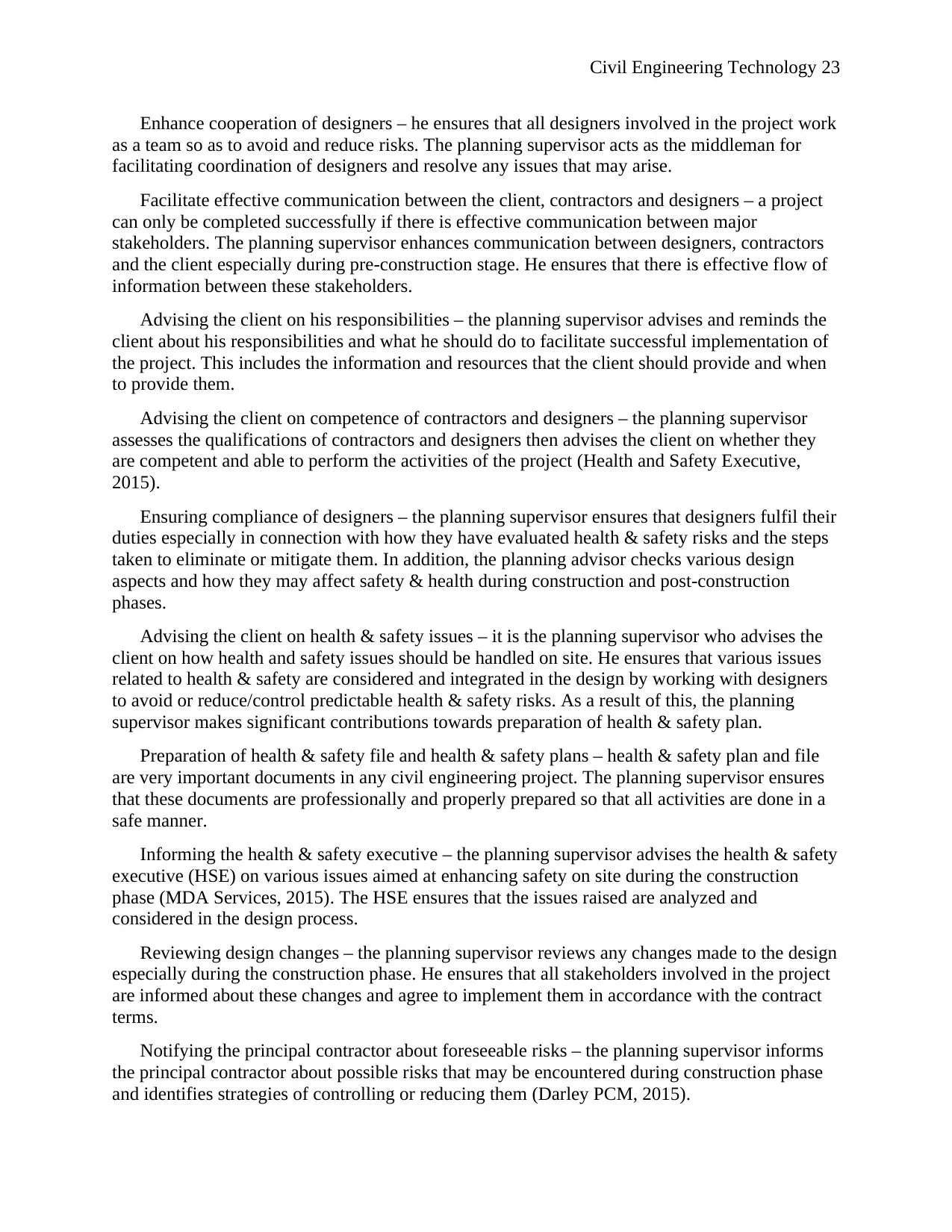
Civil Engineering Technology 23
Enhance cooperation of designers – he ensures that all designers involved in the project work
as a team so as to avoid and reduce risks. The planning supervisor acts as the middleman for
facilitating coordination of designers and resolve any issues that may arise.
Facilitate effective communication between the client, contractors and designers – a project
can only be completed successfully if there is effective communication between major
stakeholders. The planning supervisor enhances communication between designers, contractors
and the client especially during pre-construction stage. He ensures that there is effective flow of
information between these stakeholders.
Advising the client on his responsibilities – the planning supervisor advises and reminds the
client about his responsibilities and what he should do to facilitate successful implementation of
the project. This includes the information and resources that the client should provide and when
to provide them.
Advising the client on competence of contractors and designers – the planning supervisor
assesses the qualifications of contractors and designers then advises the client on whether they
are competent and able to perform the activities of the project (Health and Safety Executive,
2015).
Ensuring compliance of designers – the planning supervisor ensures that designers fulfil their
duties especially in connection with how they have evaluated health & safety risks and the steps
taken to eliminate or mitigate them. In addition, the planning advisor checks various design
aspects and how they may affect safety & health during construction and post-construction
phases.
Advising the client on health & safety issues – it is the planning supervisor who advises the
client on how health and safety issues should be handled on site. He ensures that various issues
related to health & safety are considered and integrated in the design by working with designers
to avoid or reduce/control predictable health & safety risks. As a result of this, the planning
supervisor makes significant contributions towards preparation of health & safety plan.
Preparation of health & safety file and health & safety plans – health & safety plan and file
are very important documents in any civil engineering project. The planning supervisor ensures
that these documents are professionally and properly prepared so that all activities are done in a
safe manner.
Informing the health & safety executive – the planning supervisor advises the health & safety
executive (HSE) on various issues aimed at enhancing safety on site during the construction
phase (MDA Services, 2015). The HSE ensures that the issues raised are analyzed and
considered in the design process.
Reviewing design changes – the planning supervisor reviews any changes made to the design
especially during the construction phase. He ensures that all stakeholders involved in the project
are informed about these changes and agree to implement them in accordance with the contract
terms.
Notifying the principal contractor about foreseeable risks – the planning supervisor informs
the principal contractor about possible risks that may be encountered during construction phase
and identifies strategies of controlling or reducing them (Darley PCM, 2015).
Enhance cooperation of designers – he ensures that all designers involved in the project work
as a team so as to avoid and reduce risks. The planning supervisor acts as the middleman for
facilitating coordination of designers and resolve any issues that may arise.
Facilitate effective communication between the client, contractors and designers – a project
can only be completed successfully if there is effective communication between major
stakeholders. The planning supervisor enhances communication between designers, contractors
and the client especially during pre-construction stage. He ensures that there is effective flow of
information between these stakeholders.
Advising the client on his responsibilities – the planning supervisor advises and reminds the
client about his responsibilities and what he should do to facilitate successful implementation of
the project. This includes the information and resources that the client should provide and when
to provide them.
Advising the client on competence of contractors and designers – the planning supervisor
assesses the qualifications of contractors and designers then advises the client on whether they
are competent and able to perform the activities of the project (Health and Safety Executive,
2015).
Ensuring compliance of designers – the planning supervisor ensures that designers fulfil their
duties especially in connection with how they have evaluated health & safety risks and the steps
taken to eliminate or mitigate them. In addition, the planning advisor checks various design
aspects and how they may affect safety & health during construction and post-construction
phases.
Advising the client on health & safety issues – it is the planning supervisor who advises the
client on how health and safety issues should be handled on site. He ensures that various issues
related to health & safety are considered and integrated in the design by working with designers
to avoid or reduce/control predictable health & safety risks. As a result of this, the planning
supervisor makes significant contributions towards preparation of health & safety plan.
Preparation of health & safety file and health & safety plans – health & safety plan and file
are very important documents in any civil engineering project. The planning supervisor ensures
that these documents are professionally and properly prepared so that all activities are done in a
safe manner.
Informing the health & safety executive – the planning supervisor advises the health & safety
executive (HSE) on various issues aimed at enhancing safety on site during the construction
phase (MDA Services, 2015). The HSE ensures that the issues raised are analyzed and
considered in the design process.
Reviewing design changes – the planning supervisor reviews any changes made to the design
especially during the construction phase. He ensures that all stakeholders involved in the project
are informed about these changes and agree to implement them in accordance with the contract
terms.
Notifying the principal contractor about foreseeable risks – the planning supervisor informs
the principal contractor about possible risks that may be encountered during construction phase
and identifies strategies of controlling or reducing them (Darley PCM, 2015).
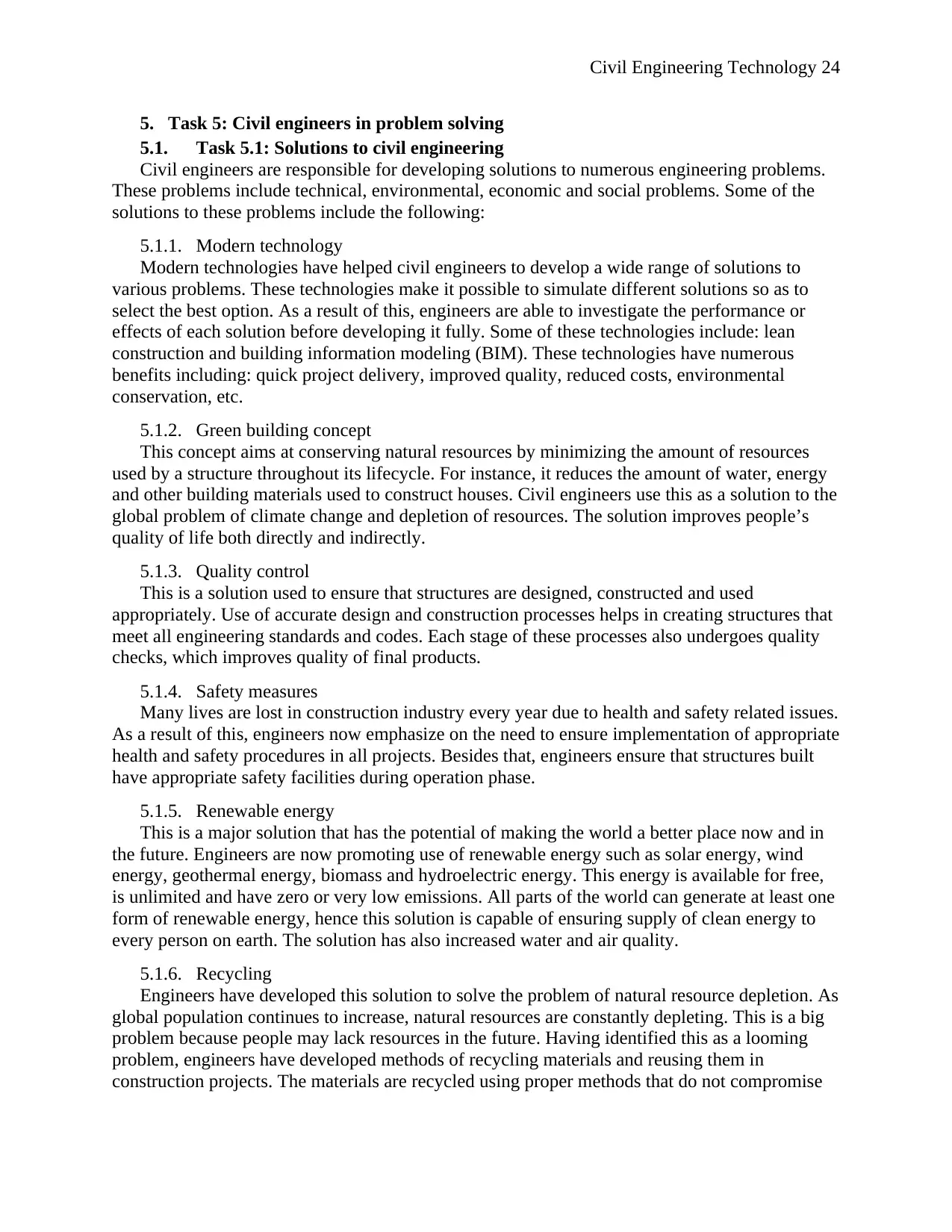
Civil Engineering Technology 24
5. Task 5: Civil engineers in problem solving
5.1. Task 5.1: Solutions to civil engineering
Civil engineers are responsible for developing solutions to numerous engineering problems.
These problems include technical, environmental, economic and social problems. Some of the
solutions to these problems include the following:
5.1.1. Modern technology
Modern technologies have helped civil engineers to develop a wide range of solutions to
various problems. These technologies make it possible to simulate different solutions so as to
select the best option. As a result of this, engineers are able to investigate the performance or
effects of each solution before developing it fully. Some of these technologies include: lean
construction and building information modeling (BIM). These technologies have numerous
benefits including: quick project delivery, improved quality, reduced costs, environmental
conservation, etc.
5.1.2. Green building concept
This concept aims at conserving natural resources by minimizing the amount of resources
used by a structure throughout its lifecycle. For instance, it reduces the amount of water, energy
and other building materials used to construct houses. Civil engineers use this as a solution to the
global problem of climate change and depletion of resources. The solution improves people’s
quality of life both directly and indirectly.
5.1.3. Quality control
This is a solution used to ensure that structures are designed, constructed and used
appropriately. Use of accurate design and construction processes helps in creating structures that
meet all engineering standards and codes. Each stage of these processes also undergoes quality
checks, which improves quality of final products.
5.1.4. Safety measures
Many lives are lost in construction industry every year due to health and safety related issues.
As a result of this, engineers now emphasize on the need to ensure implementation of appropriate
health and safety procedures in all projects. Besides that, engineers ensure that structures built
have appropriate safety facilities during operation phase.
5.1.5. Renewable energy
This is a major solution that has the potential of making the world a better place now and in
the future. Engineers are now promoting use of renewable energy such as solar energy, wind
energy, geothermal energy, biomass and hydroelectric energy. This energy is available for free,
is unlimited and have zero or very low emissions. All parts of the world can generate at least one
form of renewable energy, hence this solution is capable of ensuring supply of clean energy to
every person on earth. The solution has also increased water and air quality.
5.1.6. Recycling
Engineers have developed this solution to solve the problem of natural resource depletion. As
global population continues to increase, natural resources are constantly depleting. This is a big
problem because people may lack resources in the future. Having identified this as a looming
problem, engineers have developed methods of recycling materials and reusing them in
construction projects. The materials are recycled using proper methods that do not compromise
5. Task 5: Civil engineers in problem solving
5.1. Task 5.1: Solutions to civil engineering
Civil engineers are responsible for developing solutions to numerous engineering problems.
These problems include technical, environmental, economic and social problems. Some of the
solutions to these problems include the following:
5.1.1. Modern technology
Modern technologies have helped civil engineers to develop a wide range of solutions to
various problems. These technologies make it possible to simulate different solutions so as to
select the best option. As a result of this, engineers are able to investigate the performance or
effects of each solution before developing it fully. Some of these technologies include: lean
construction and building information modeling (BIM). These technologies have numerous
benefits including: quick project delivery, improved quality, reduced costs, environmental
conservation, etc.
5.1.2. Green building concept
This concept aims at conserving natural resources by minimizing the amount of resources
used by a structure throughout its lifecycle. For instance, it reduces the amount of water, energy
and other building materials used to construct houses. Civil engineers use this as a solution to the
global problem of climate change and depletion of resources. The solution improves people’s
quality of life both directly and indirectly.
5.1.3. Quality control
This is a solution used to ensure that structures are designed, constructed and used
appropriately. Use of accurate design and construction processes helps in creating structures that
meet all engineering standards and codes. Each stage of these processes also undergoes quality
checks, which improves quality of final products.
5.1.4. Safety measures
Many lives are lost in construction industry every year due to health and safety related issues.
As a result of this, engineers now emphasize on the need to ensure implementation of appropriate
health and safety procedures in all projects. Besides that, engineers ensure that structures built
have appropriate safety facilities during operation phase.
5.1.5. Renewable energy
This is a major solution that has the potential of making the world a better place now and in
the future. Engineers are now promoting use of renewable energy such as solar energy, wind
energy, geothermal energy, biomass and hydroelectric energy. This energy is available for free,
is unlimited and have zero or very low emissions. All parts of the world can generate at least one
form of renewable energy, hence this solution is capable of ensuring supply of clean energy to
every person on earth. The solution has also increased water and air quality.
5.1.6. Recycling
Engineers have developed this solution to solve the problem of natural resource depletion. As
global population continues to increase, natural resources are constantly depleting. This is a big
problem because people may lack resources in the future. Having identified this as a looming
problem, engineers have developed methods of recycling materials and reusing them in
construction projects. The materials are recycled using proper methods that do not compromise
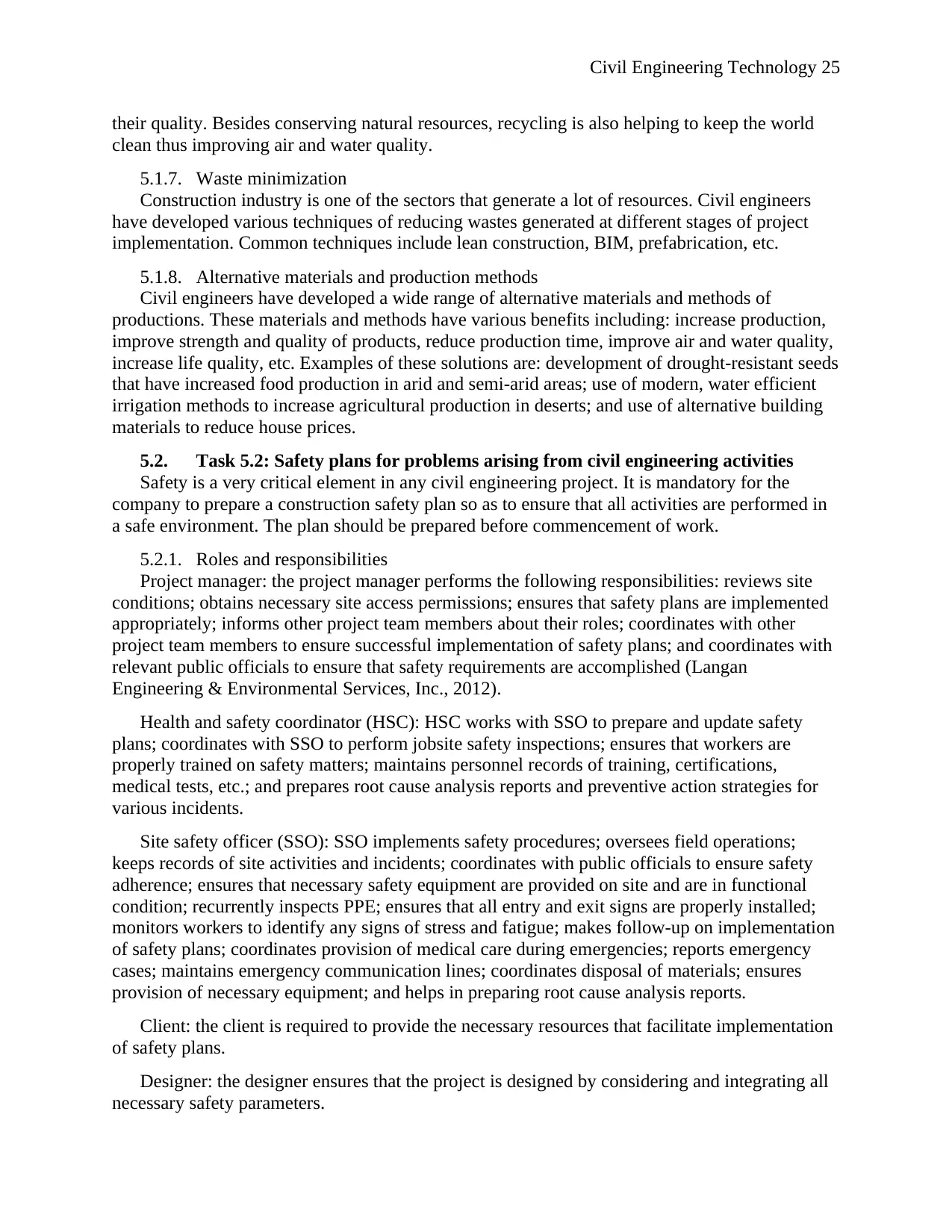
Civil Engineering Technology 25
their quality. Besides conserving natural resources, recycling is also helping to keep the world
clean thus improving air and water quality.
5.1.7. Waste minimization
Construction industry is one of the sectors that generate a lot of resources. Civil engineers
have developed various techniques of reducing wastes generated at different stages of project
implementation. Common techniques include lean construction, BIM, prefabrication, etc.
5.1.8. Alternative materials and production methods
Civil engineers have developed a wide range of alternative materials and methods of
productions. These materials and methods have various benefits including: increase production,
improve strength and quality of products, reduce production time, improve air and water quality,
increase life quality, etc. Examples of these solutions are: development of drought-resistant seeds
that have increased food production in arid and semi-arid areas; use of modern, water efficient
irrigation methods to increase agricultural production in deserts; and use of alternative building
materials to reduce house prices.
5.2. Task 5.2: Safety plans for problems arising from civil engineering activities
Safety is a very critical element in any civil engineering project. It is mandatory for the
company to prepare a construction safety plan so as to ensure that all activities are performed in
a safe environment. The plan should be prepared before commencement of work.
5.2.1. Roles and responsibilities
Project manager: the project manager performs the following responsibilities: reviews site
conditions; obtains necessary site access permissions; ensures that safety plans are implemented
appropriately; informs other project team members about their roles; coordinates with other
project team members to ensure successful implementation of safety plans; and coordinates with
relevant public officials to ensure that safety requirements are accomplished (Langan
Engineering & Environmental Services, Inc., 2012).
Health and safety coordinator (HSC): HSC works with SSO to prepare and update safety
plans; coordinates with SSO to perform jobsite safety inspections; ensures that workers are
properly trained on safety matters; maintains personnel records of training, certifications,
medical tests, etc.; and prepares root cause analysis reports and preventive action strategies for
various incidents.
Site safety officer (SSO): SSO implements safety procedures; oversees field operations;
keeps records of site activities and incidents; coordinates with public officials to ensure safety
adherence; ensures that necessary safety equipment are provided on site and are in functional
condition; recurrently inspects PPE; ensures that all entry and exit signs are properly installed;
monitors workers to identify any signs of stress and fatigue; makes follow-up on implementation
of safety plans; coordinates provision of medical care during emergencies; reports emergency
cases; maintains emergency communication lines; coordinates disposal of materials; ensures
provision of necessary equipment; and helps in preparing root cause analysis reports.
Client: the client is required to provide the necessary resources that facilitate implementation
of safety plans.
Designer: the designer ensures that the project is designed by considering and integrating all
necessary safety parameters.
their quality. Besides conserving natural resources, recycling is also helping to keep the world
clean thus improving air and water quality.
5.1.7. Waste minimization
Construction industry is one of the sectors that generate a lot of resources. Civil engineers
have developed various techniques of reducing wastes generated at different stages of project
implementation. Common techniques include lean construction, BIM, prefabrication, etc.
5.1.8. Alternative materials and production methods
Civil engineers have developed a wide range of alternative materials and methods of
productions. These materials and methods have various benefits including: increase production,
improve strength and quality of products, reduce production time, improve air and water quality,
increase life quality, etc. Examples of these solutions are: development of drought-resistant seeds
that have increased food production in arid and semi-arid areas; use of modern, water efficient
irrigation methods to increase agricultural production in deserts; and use of alternative building
materials to reduce house prices.
5.2. Task 5.2: Safety plans for problems arising from civil engineering activities
Safety is a very critical element in any civil engineering project. It is mandatory for the
company to prepare a construction safety plan so as to ensure that all activities are performed in
a safe environment. The plan should be prepared before commencement of work.
5.2.1. Roles and responsibilities
Project manager: the project manager performs the following responsibilities: reviews site
conditions; obtains necessary site access permissions; ensures that safety plans are implemented
appropriately; informs other project team members about their roles; coordinates with other
project team members to ensure successful implementation of safety plans; and coordinates with
relevant public officials to ensure that safety requirements are accomplished (Langan
Engineering & Environmental Services, Inc., 2012).
Health and safety coordinator (HSC): HSC works with SSO to prepare and update safety
plans; coordinates with SSO to perform jobsite safety inspections; ensures that workers are
properly trained on safety matters; maintains personnel records of training, certifications,
medical tests, etc.; and prepares root cause analysis reports and preventive action strategies for
various incidents.
Site safety officer (SSO): SSO implements safety procedures; oversees field operations;
keeps records of site activities and incidents; coordinates with public officials to ensure safety
adherence; ensures that necessary safety equipment are provided on site and are in functional
condition; recurrently inspects PPE; ensures that all entry and exit signs are properly installed;
monitors workers to identify any signs of stress and fatigue; makes follow-up on implementation
of safety plans; coordinates provision of medical care during emergencies; reports emergency
cases; maintains emergency communication lines; coordinates disposal of materials; ensures
provision of necessary equipment; and helps in preparing root cause analysis reports.
Client: the client is required to provide the necessary resources that facilitate implementation
of safety plans.
Designer: the designer ensures that the project is designed by considering and integrating all
necessary safety parameters.
Paraphrase This Document
Need a fresh take? Get an instant paraphrase of this document with our AI Paraphraser
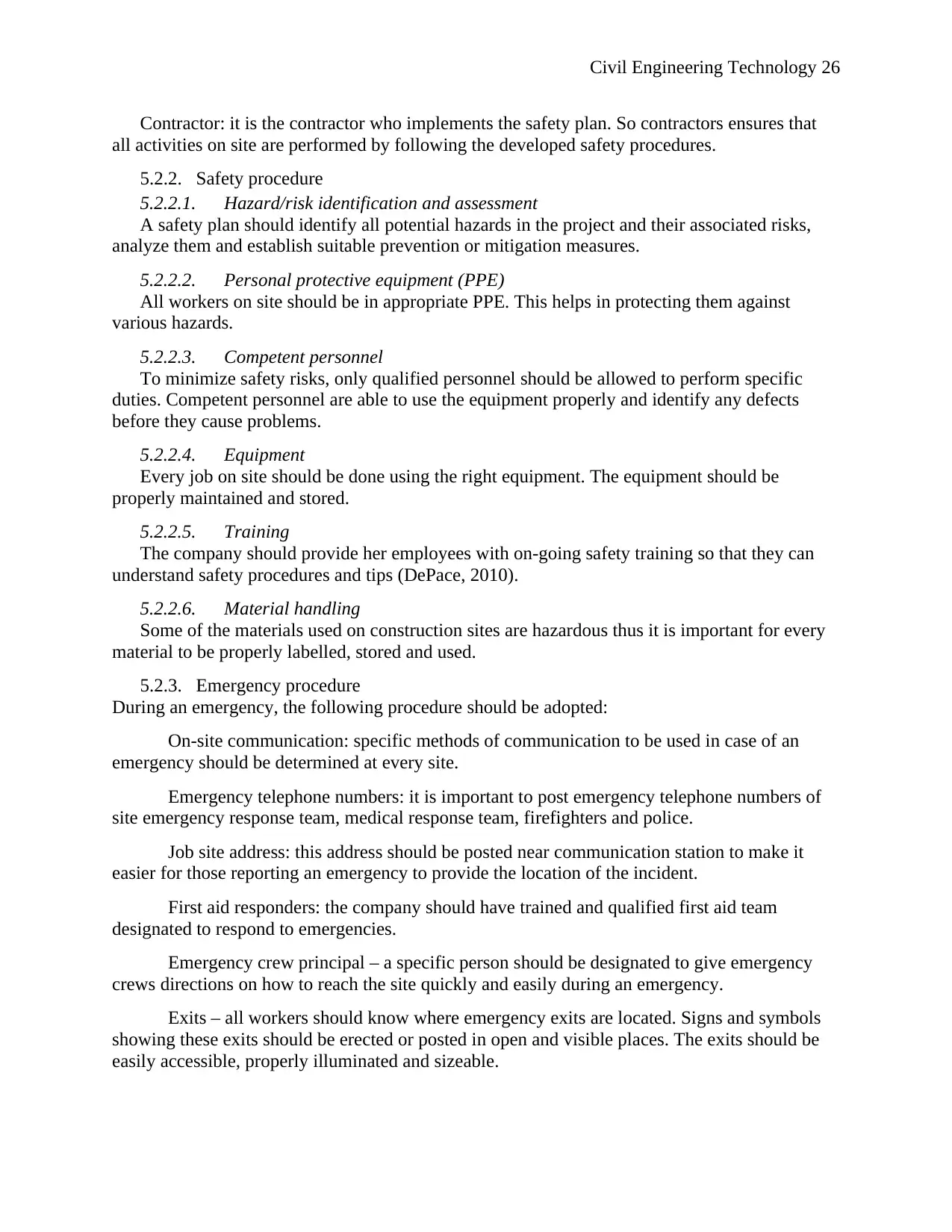
Civil Engineering Technology 26
Contractor: it is the contractor who implements the safety plan. So contractors ensures that
all activities on site are performed by following the developed safety procedures.
5.2.2. Safety procedure
5.2.2.1. Hazard/risk identification and assessment
A safety plan should identify all potential hazards in the project and their associated risks,
analyze them and establish suitable prevention or mitigation measures.
5.2.2.2. Personal protective equipment (PPE)
All workers on site should be in appropriate PPE. This helps in protecting them against
various hazards.
5.2.2.3. Competent personnel
To minimize safety risks, only qualified personnel should be allowed to perform specific
duties. Competent personnel are able to use the equipment properly and identify any defects
before they cause problems.
5.2.2.4. Equipment
Every job on site should be done using the right equipment. The equipment should be
properly maintained and stored.
5.2.2.5. Training
The company should provide her employees with on-going safety training so that they can
understand safety procedures and tips (DePace, 2010).
5.2.2.6. Material handling
Some of the materials used on construction sites are hazardous thus it is important for every
material to be properly labelled, stored and used.
5.2.3. Emergency procedure
During an emergency, the following procedure should be adopted:
On-site communication: specific methods of communication to be used in case of an
emergency should be determined at every site.
Emergency telephone numbers: it is important to post emergency telephone numbers of
site emergency response team, medical response team, firefighters and police.
Job site address: this address should be posted near communication station to make it
easier for those reporting an emergency to provide the location of the incident.
First aid responders: the company should have trained and qualified first aid team
designated to respond to emergencies.
Emergency crew principal – a specific person should be designated to give emergency
crews directions on how to reach the site quickly and easily during an emergency.
Exits – all workers should know where emergency exits are located. Signs and symbols
showing these exits should be erected or posted in open and visible places. The exits should be
easily accessible, properly illuminated and sizeable.
Contractor: it is the contractor who implements the safety plan. So contractors ensures that
all activities on site are performed by following the developed safety procedures.
5.2.2. Safety procedure
5.2.2.1. Hazard/risk identification and assessment
A safety plan should identify all potential hazards in the project and their associated risks,
analyze them and establish suitable prevention or mitigation measures.
5.2.2.2. Personal protective equipment (PPE)
All workers on site should be in appropriate PPE. This helps in protecting them against
various hazards.
5.2.2.3. Competent personnel
To minimize safety risks, only qualified personnel should be allowed to perform specific
duties. Competent personnel are able to use the equipment properly and identify any defects
before they cause problems.
5.2.2.4. Equipment
Every job on site should be done using the right equipment. The equipment should be
properly maintained and stored.
5.2.2.5. Training
The company should provide her employees with on-going safety training so that they can
understand safety procedures and tips (DePace, 2010).
5.2.2.6. Material handling
Some of the materials used on construction sites are hazardous thus it is important for every
material to be properly labelled, stored and used.
5.2.3. Emergency procedure
During an emergency, the following procedure should be adopted:
On-site communication: specific methods of communication to be used in case of an
emergency should be determined at every site.
Emergency telephone numbers: it is important to post emergency telephone numbers of
site emergency response team, medical response team, firefighters and police.
Job site address: this address should be posted near communication station to make it
easier for those reporting an emergency to provide the location of the incident.
First aid responders: the company should have trained and qualified first aid team
designated to respond to emergencies.
Emergency crew principal – a specific person should be designated to give emergency
crews directions on how to reach the site quickly and easily during an emergency.
Exits – all workers should know where emergency exits are located. Signs and symbols
showing these exits should be erected or posted in open and visible places. The exits should be
easily accessible, properly illuminated and sizeable.
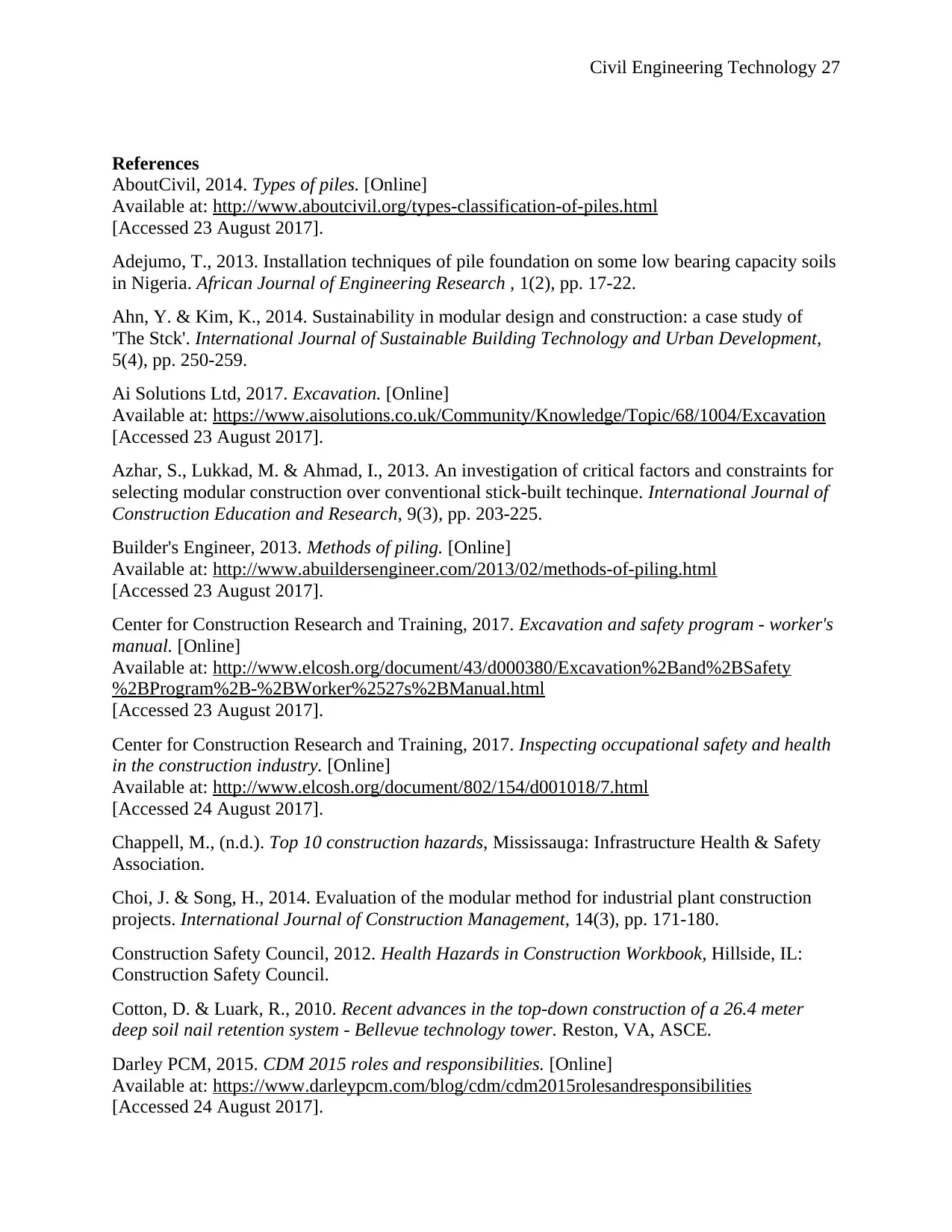
Civil Engineering Technology 27
References
AboutCivil, 2014. Types of piles. [Online]
Available at: http://www.aboutcivil.org/types-classification-of-piles.html
[Accessed 23 August 2017].
Adejumo, T., 2013. Installation techniques of pile foundation on some low bearing capacity soils
in Nigeria. African Journal of Engineering Research , 1(2), pp. 17-22.
Ahn, Y. & Kim, K., 2014. Sustainability in modular design and construction: a case study of
'The Stck'. International Journal of Sustainable Building Technology and Urban Development,
5(4), pp. 250-259.
Ai Solutions Ltd, 2017. Excavation. [Online]
Available at: https://www.aisolutions.co.uk/Community/Knowledge/Topic/68/1004/Excavation
[Accessed 23 August 2017].
Azhar, S., Lukkad, M. & Ahmad, I., 2013. An investigation of critical factors and constraints for
selecting modular construction over conventional stick-built techinque. International Journal of
Construction Education and Research, 9(3), pp. 203-225.
Builder's Engineer, 2013. Methods of piling. [Online]
Available at: http://www.abuildersengineer.com/2013/02/methods-of-piling.html
[Accessed 23 August 2017].
Center for Construction Research and Training, 2017. Excavation and safety program - worker's
manual. [Online]
Available at: http://www.elcosh.org/document/43/d000380/Excavation%2Band%2BSafety
%2BProgram%2B-%2BWorker%2527s%2BManual.html
[Accessed 23 August 2017].
Center for Construction Research and Training, 2017. Inspecting occupational safety and health
in the construction industry. [Online]
Available at: http://www.elcosh.org/document/802/154/d001018/7.html
[Accessed 24 August 2017].
Chappell, M., (n.d.). Top 10 construction hazards, Mississauga: Infrastructure Health & Safety
Association.
Choi, J. & Song, H., 2014. Evaluation of the modular method for industrial plant construction
projects. International Journal of Construction Management, 14(3), pp. 171-180.
Construction Safety Council, 2012. Health Hazards in Construction Workbook, Hillside, IL:
Construction Safety Council.
Cotton, D. & Luark, R., 2010. Recent advances in the top-down construction of a 26.4 meter
deep soil nail retention system - Bellevue technology tower. Reston, VA, ASCE.
Darley PCM, 2015. CDM 2015 roles and responsibilities. [Online]
Available at: https://www.darleypcm.com/blog/cdm/cdm2015rolesandresponsibilities
[Accessed 24 August 2017].
References
AboutCivil, 2014. Types of piles. [Online]
Available at: http://www.aboutcivil.org/types-classification-of-piles.html
[Accessed 23 August 2017].
Adejumo, T., 2013. Installation techniques of pile foundation on some low bearing capacity soils
in Nigeria. African Journal of Engineering Research , 1(2), pp. 17-22.
Ahn, Y. & Kim, K., 2014. Sustainability in modular design and construction: a case study of
'The Stck'. International Journal of Sustainable Building Technology and Urban Development,
5(4), pp. 250-259.
Ai Solutions Ltd, 2017. Excavation. [Online]
Available at: https://www.aisolutions.co.uk/Community/Knowledge/Topic/68/1004/Excavation
[Accessed 23 August 2017].
Azhar, S., Lukkad, M. & Ahmad, I., 2013. An investigation of critical factors and constraints for
selecting modular construction over conventional stick-built techinque. International Journal of
Construction Education and Research, 9(3), pp. 203-225.
Builder's Engineer, 2013. Methods of piling. [Online]
Available at: http://www.abuildersengineer.com/2013/02/methods-of-piling.html
[Accessed 23 August 2017].
Center for Construction Research and Training, 2017. Excavation and safety program - worker's
manual. [Online]
Available at: http://www.elcosh.org/document/43/d000380/Excavation%2Band%2BSafety
%2BProgram%2B-%2BWorker%2527s%2BManual.html
[Accessed 23 August 2017].
Center for Construction Research and Training, 2017. Inspecting occupational safety and health
in the construction industry. [Online]
Available at: http://www.elcosh.org/document/802/154/d001018/7.html
[Accessed 24 August 2017].
Chappell, M., (n.d.). Top 10 construction hazards, Mississauga: Infrastructure Health & Safety
Association.
Choi, J. & Song, H., 2014. Evaluation of the modular method for industrial plant construction
projects. International Journal of Construction Management, 14(3), pp. 171-180.
Construction Safety Council, 2012. Health Hazards in Construction Workbook, Hillside, IL:
Construction Safety Council.
Cotton, D. & Luark, R., 2010. Recent advances in the top-down construction of a 26.4 meter
deep soil nail retention system - Bellevue technology tower. Reston, VA, ASCE.
Darley PCM, 2015. CDM 2015 roles and responsibilities. [Online]
Available at: https://www.darleypcm.com/blog/cdm/cdm2015rolesandresponsibilities
[Accessed 24 August 2017].
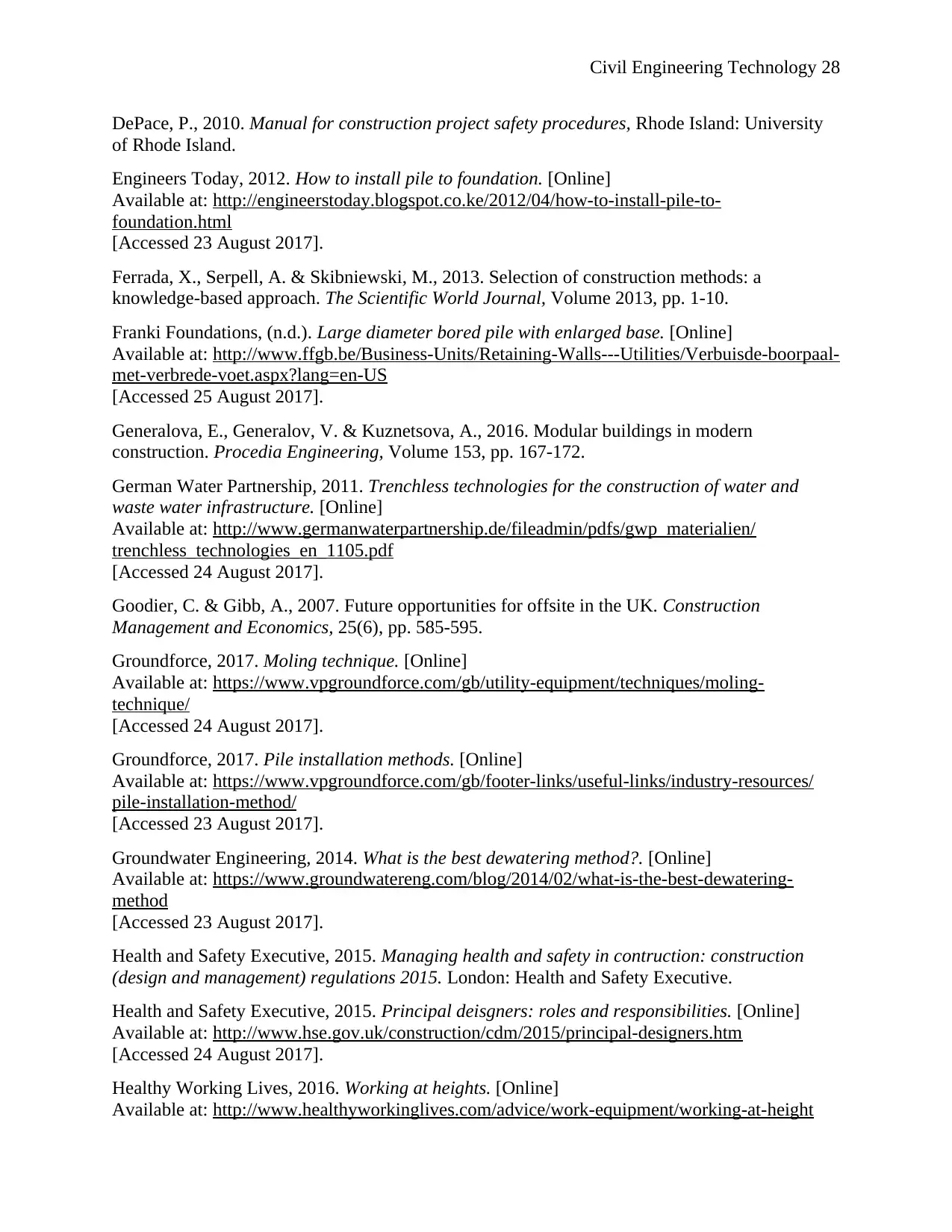
Civil Engineering Technology 28
DePace, P., 2010. Manual for construction project safety procedures, Rhode Island: University
of Rhode Island.
Engineers Today, 2012. How to install pile to foundation. [Online]
Available at: http://engineerstoday.blogspot.co.ke/2012/04/how-to-install-pile-to-
foundation.html
[Accessed 23 August 2017].
Ferrada, X., Serpell, A. & Skibniewski, M., 2013. Selection of construction methods: a
knowledge-based approach. The Scientific World Journal, Volume 2013, pp. 1-10.
Franki Foundations, (n.d.). Large diameter bored pile with enlarged base. [Online]
Available at: http://www.ffgb.be/Business-Units/Retaining-Walls---Utilities/Verbuisde-boorpaal-
met-verbrede-voet.aspx?lang=en-US
[Accessed 25 August 2017].
Generalova, E., Generalov, V. & Kuznetsova, A., 2016. Modular buildings in modern
construction. Procedia Engineering, Volume 153, pp. 167-172.
German Water Partnership, 2011. Trenchless technologies for the construction of water and
waste water infrastructure. [Online]
Available at: http://www.germanwaterpartnership.de/fileadmin/pdfs/gwp_materialien/
trenchless_technologies_en_1105.pdf
[Accessed 24 August 2017].
Goodier, C. & Gibb, A., 2007. Future opportunities for offsite in the UK. Construction
Management and Economics, 25(6), pp. 585-595.
Groundforce, 2017. Moling technique. [Online]
Available at: https://www.vpgroundforce.com/gb/utility-equipment/techniques/moling-
technique/
[Accessed 24 August 2017].
Groundforce, 2017. Pile installation methods. [Online]
Available at: https://www.vpgroundforce.com/gb/footer-links/useful-links/industry-resources/
pile-installation-method/
[Accessed 23 August 2017].
Groundwater Engineering, 2014. What is the best dewatering method?. [Online]
Available at: https://www.groundwatereng.com/blog/2014/02/what-is-the-best-dewatering-
method
[Accessed 23 August 2017].
Health and Safety Executive, 2015. Managing health and safety in contruction: construction
(design and management) regulations 2015. London: Health and Safety Executive.
Health and Safety Executive, 2015. Principal deisgners: roles and responsibilities. [Online]
Available at: http://www.hse.gov.uk/construction/cdm/2015/principal-designers.htm
[Accessed 24 August 2017].
Healthy Working Lives, 2016. Working at heights. [Online]
Available at: http://www.healthyworkinglives.com/advice/work-equipment/working-at-height
DePace, P., 2010. Manual for construction project safety procedures, Rhode Island: University
of Rhode Island.
Engineers Today, 2012. How to install pile to foundation. [Online]
Available at: http://engineerstoday.blogspot.co.ke/2012/04/how-to-install-pile-to-
foundation.html
[Accessed 23 August 2017].
Ferrada, X., Serpell, A. & Skibniewski, M., 2013. Selection of construction methods: a
knowledge-based approach. The Scientific World Journal, Volume 2013, pp. 1-10.
Franki Foundations, (n.d.). Large diameter bored pile with enlarged base. [Online]
Available at: http://www.ffgb.be/Business-Units/Retaining-Walls---Utilities/Verbuisde-boorpaal-
met-verbrede-voet.aspx?lang=en-US
[Accessed 25 August 2017].
Generalova, E., Generalov, V. & Kuznetsova, A., 2016. Modular buildings in modern
construction. Procedia Engineering, Volume 153, pp. 167-172.
German Water Partnership, 2011. Trenchless technologies for the construction of water and
waste water infrastructure. [Online]
Available at: http://www.germanwaterpartnership.de/fileadmin/pdfs/gwp_materialien/
trenchless_technologies_en_1105.pdf
[Accessed 24 August 2017].
Goodier, C. & Gibb, A., 2007. Future opportunities for offsite in the UK. Construction
Management and Economics, 25(6), pp. 585-595.
Groundforce, 2017. Moling technique. [Online]
Available at: https://www.vpgroundforce.com/gb/utility-equipment/techniques/moling-
technique/
[Accessed 24 August 2017].
Groundforce, 2017. Pile installation methods. [Online]
Available at: https://www.vpgroundforce.com/gb/footer-links/useful-links/industry-resources/
pile-installation-method/
[Accessed 23 August 2017].
Groundwater Engineering, 2014. What is the best dewatering method?. [Online]
Available at: https://www.groundwatereng.com/blog/2014/02/what-is-the-best-dewatering-
method
[Accessed 23 August 2017].
Health and Safety Executive, 2015. Managing health and safety in contruction: construction
(design and management) regulations 2015. London: Health and Safety Executive.
Health and Safety Executive, 2015. Principal deisgners: roles and responsibilities. [Online]
Available at: http://www.hse.gov.uk/construction/cdm/2015/principal-designers.htm
[Accessed 24 August 2017].
Healthy Working Lives, 2016. Working at heights. [Online]
Available at: http://www.healthyworkinglives.com/advice/work-equipment/working-at-height
Secure Best Marks with AI Grader
Need help grading? Try our AI Grader for instant feedback on your assignments.
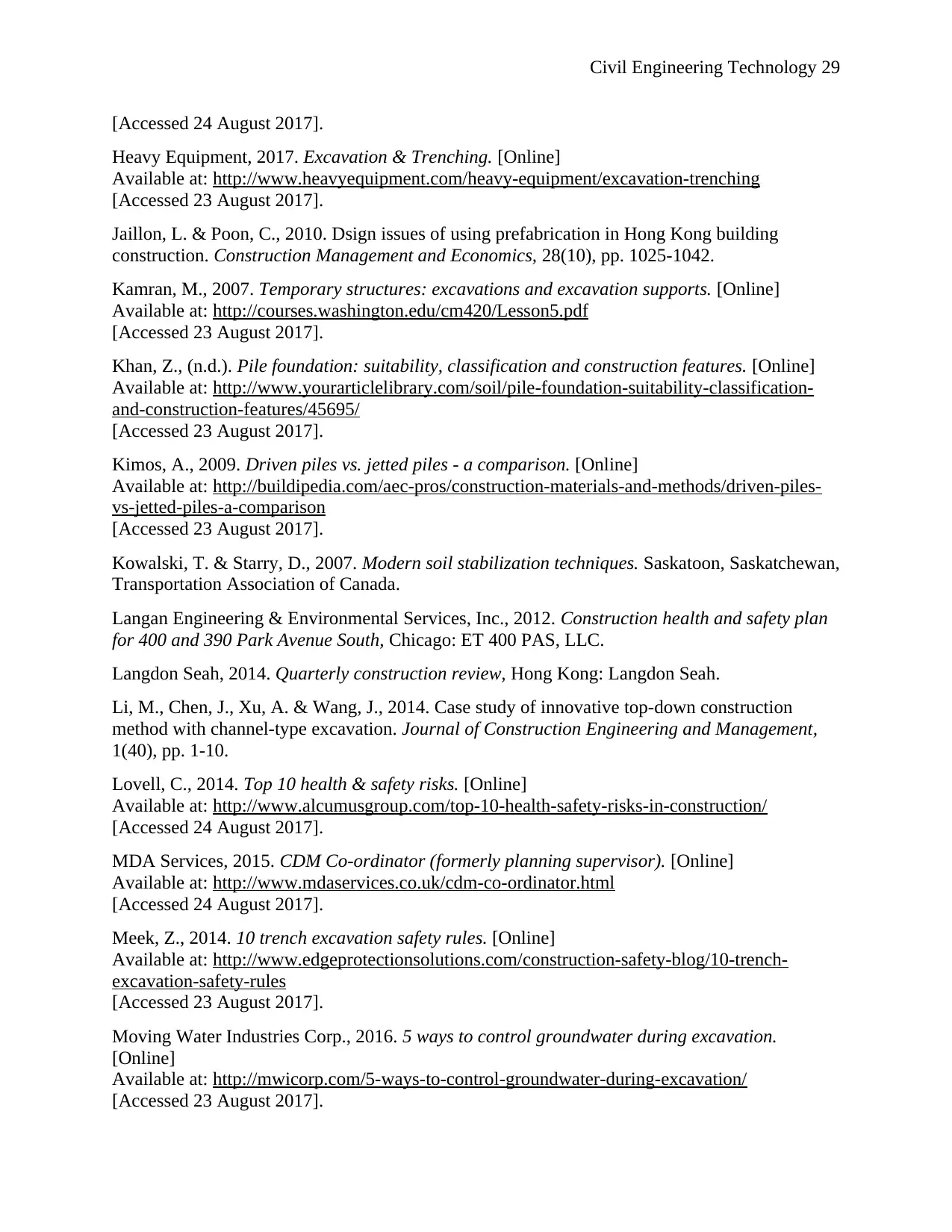
Civil Engineering Technology 29
[Accessed 24 August 2017].
Heavy Equipment, 2017. Excavation & Trenching. [Online]
Available at: http://www.heavyequipment.com/heavy-equipment/excavation-trenching
[Accessed 23 August 2017].
Jaillon, L. & Poon, C., 2010. Dsign issues of using prefabrication in Hong Kong building
construction. Construction Management and Economics, 28(10), pp. 1025-1042.
Kamran, M., 2007. Temporary structures: excavations and excavation supports. [Online]
Available at: http://courses.washington.edu/cm420/Lesson5.pdf
[Accessed 23 August 2017].
Khan, Z., (n.d.). Pile foundation: suitability, classification and construction features. [Online]
Available at: http://www.yourarticlelibrary.com/soil/pile-foundation-suitability-classification-
and-construction-features/45695/
[Accessed 23 August 2017].
Kimos, A., 2009. Driven piles vs. jetted piles - a comparison. [Online]
Available at: http://buildipedia.com/aec-pros/construction-materials-and-methods/driven-piles-
vs-jetted-piles-a-comparison
[Accessed 23 August 2017].
Kowalski, T. & Starry, D., 2007. Modern soil stabilization techniques. Saskatoon, Saskatchewan,
Transportation Association of Canada.
Langan Engineering & Environmental Services, Inc., 2012. Construction health and safety plan
for 400 and 390 Park Avenue South, Chicago: ET 400 PAS, LLC.
Langdon Seah, 2014. Quarterly construction review, Hong Kong: Langdon Seah.
Li, M., Chen, J., Xu, A. & Wang, J., 2014. Case study of innovative top-down construction
method with channel-type excavation. Journal of Construction Engineering and Management,
1(40), pp. 1-10.
Lovell, C., 2014. Top 10 health & safety risks. [Online]
Available at: http://www.alcumusgroup.com/top-10-health-safety-risks-in-construction/
[Accessed 24 August 2017].
MDA Services, 2015. CDM Co-ordinator (formerly planning supervisor). [Online]
Available at: http://www.mdaservices.co.uk/cdm-co-ordinator.html
[Accessed 24 August 2017].
Meek, Z., 2014. 10 trench excavation safety rules. [Online]
Available at: http://www.edgeprotectionsolutions.com/construction-safety-blog/10-trench-
excavation-safety-rules
[Accessed 23 August 2017].
Moving Water Industries Corp., 2016. 5 ways to control groundwater during excavation.
[Online]
Available at: http://mwicorp.com/5-ways-to-control-groundwater-during-excavation/
[Accessed 23 August 2017].
[Accessed 24 August 2017].
Heavy Equipment, 2017. Excavation & Trenching. [Online]
Available at: http://www.heavyequipment.com/heavy-equipment/excavation-trenching
[Accessed 23 August 2017].
Jaillon, L. & Poon, C., 2010. Dsign issues of using prefabrication in Hong Kong building
construction. Construction Management and Economics, 28(10), pp. 1025-1042.
Kamran, M., 2007. Temporary structures: excavations and excavation supports. [Online]
Available at: http://courses.washington.edu/cm420/Lesson5.pdf
[Accessed 23 August 2017].
Khan, Z., (n.d.). Pile foundation: suitability, classification and construction features. [Online]
Available at: http://www.yourarticlelibrary.com/soil/pile-foundation-suitability-classification-
and-construction-features/45695/
[Accessed 23 August 2017].
Kimos, A., 2009. Driven piles vs. jetted piles - a comparison. [Online]
Available at: http://buildipedia.com/aec-pros/construction-materials-and-methods/driven-piles-
vs-jetted-piles-a-comparison
[Accessed 23 August 2017].
Kowalski, T. & Starry, D., 2007. Modern soil stabilization techniques. Saskatoon, Saskatchewan,
Transportation Association of Canada.
Langan Engineering & Environmental Services, Inc., 2012. Construction health and safety plan
for 400 and 390 Park Avenue South, Chicago: ET 400 PAS, LLC.
Langdon Seah, 2014. Quarterly construction review, Hong Kong: Langdon Seah.
Li, M., Chen, J., Xu, A. & Wang, J., 2014. Case study of innovative top-down construction
method with channel-type excavation. Journal of Construction Engineering and Management,
1(40), pp. 1-10.
Lovell, C., 2014. Top 10 health & safety risks. [Online]
Available at: http://www.alcumusgroup.com/top-10-health-safety-risks-in-construction/
[Accessed 24 August 2017].
MDA Services, 2015. CDM Co-ordinator (formerly planning supervisor). [Online]
Available at: http://www.mdaservices.co.uk/cdm-co-ordinator.html
[Accessed 24 August 2017].
Meek, Z., 2014. 10 trench excavation safety rules. [Online]
Available at: http://www.edgeprotectionsolutions.com/construction-safety-blog/10-trench-
excavation-safety-rules
[Accessed 23 August 2017].
Moving Water Industries Corp., 2016. 5 ways to control groundwater during excavation.
[Online]
Available at: http://mwicorp.com/5-ways-to-control-groundwater-during-excavation/
[Accessed 23 August 2017].
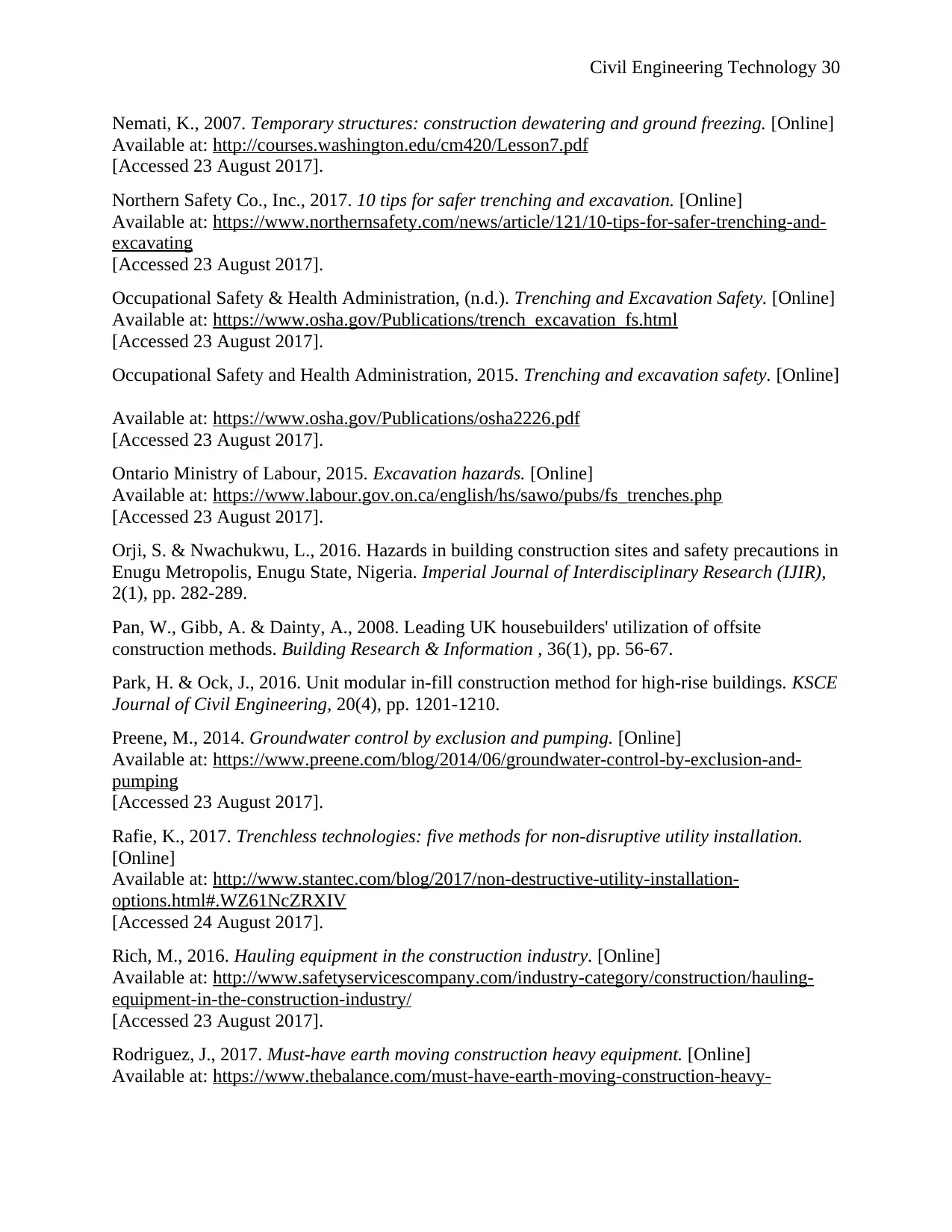
Civil Engineering Technology 30
Nemati, K., 2007. Temporary structures: construction dewatering and ground freezing. [Online]
Available at: http://courses.washington.edu/cm420/Lesson7.pdf
[Accessed 23 August 2017].
Northern Safety Co., Inc., 2017. 10 tips for safer trenching and excavation. [Online]
Available at: https://www.northernsafety.com/news/article/121/10-tips-for-safer-trenching-and-
excavating
[Accessed 23 August 2017].
Occupational Safety & Health Administration, (n.d.). Trenching and Excavation Safety. [Online]
Available at: https://www.osha.gov/Publications/trench_excavation_fs.html
[Accessed 23 August 2017].
Occupational Safety and Health Administration, 2015. Trenching and excavation safety. [Online]
Available at: https://www.osha.gov/Publications/osha2226.pdf
[Accessed 23 August 2017].
Ontario Ministry of Labour, 2015. Excavation hazards. [Online]
Available at: https://www.labour.gov.on.ca/english/hs/sawo/pubs/fs_trenches.php
[Accessed 23 August 2017].
Orji, S. & Nwachukwu, L., 2016. Hazards in building construction sites and safety precautions in
Enugu Metropolis, Enugu State, Nigeria. Imperial Journal of Interdisciplinary Research (IJIR),
2(1), pp. 282-289.
Pan, W., Gibb, A. & Dainty, A., 2008. Leading UK housebuilders' utilization of offsite
construction methods. Building Research & Information , 36(1), pp. 56-67.
Park, H. & Ock, J., 2016. Unit modular in-fill construction method for high-rise buildings. KSCE
Journal of Civil Engineering, 20(4), pp. 1201-1210.
Preene, M., 2014. Groundwater control by exclusion and pumping. [Online]
Available at: https://www.preene.com/blog/2014/06/groundwater-control-by-exclusion-and-
pumping
[Accessed 23 August 2017].
Rafie, K., 2017. Trenchless technologies: five methods for non-disruptive utility installation.
[Online]
Available at: http://www.stantec.com/blog/2017/non-destructive-utility-installation-
options.html#.WZ61NcZRXIV
[Accessed 24 August 2017].
Rich, M., 2016. Hauling equipment in the construction industry. [Online]
Available at: http://www.safetyservicescompany.com/industry-category/construction/hauling-
equipment-in-the-construction-industry/
[Accessed 23 August 2017].
Rodriguez, J., 2017. Must-have earth moving construction heavy equipment. [Online]
Available at: https://www.thebalance.com/must-have-earth-moving-construction-heavy-
Nemati, K., 2007. Temporary structures: construction dewatering and ground freezing. [Online]
Available at: http://courses.washington.edu/cm420/Lesson7.pdf
[Accessed 23 August 2017].
Northern Safety Co., Inc., 2017. 10 tips for safer trenching and excavation. [Online]
Available at: https://www.northernsafety.com/news/article/121/10-tips-for-safer-trenching-and-
excavating
[Accessed 23 August 2017].
Occupational Safety & Health Administration, (n.d.). Trenching and Excavation Safety. [Online]
Available at: https://www.osha.gov/Publications/trench_excavation_fs.html
[Accessed 23 August 2017].
Occupational Safety and Health Administration, 2015. Trenching and excavation safety. [Online]
Available at: https://www.osha.gov/Publications/osha2226.pdf
[Accessed 23 August 2017].
Ontario Ministry of Labour, 2015. Excavation hazards. [Online]
Available at: https://www.labour.gov.on.ca/english/hs/sawo/pubs/fs_trenches.php
[Accessed 23 August 2017].
Orji, S. & Nwachukwu, L., 2016. Hazards in building construction sites and safety precautions in
Enugu Metropolis, Enugu State, Nigeria. Imperial Journal of Interdisciplinary Research (IJIR),
2(1), pp. 282-289.
Pan, W., Gibb, A. & Dainty, A., 2008. Leading UK housebuilders' utilization of offsite
construction methods. Building Research & Information , 36(1), pp. 56-67.
Park, H. & Ock, J., 2016. Unit modular in-fill construction method for high-rise buildings. KSCE
Journal of Civil Engineering, 20(4), pp. 1201-1210.
Preene, M., 2014. Groundwater control by exclusion and pumping. [Online]
Available at: https://www.preene.com/blog/2014/06/groundwater-control-by-exclusion-and-
pumping
[Accessed 23 August 2017].
Rafie, K., 2017. Trenchless technologies: five methods for non-disruptive utility installation.
[Online]
Available at: http://www.stantec.com/blog/2017/non-destructive-utility-installation-
options.html#.WZ61NcZRXIV
[Accessed 24 August 2017].
Rich, M., 2016. Hauling equipment in the construction industry. [Online]
Available at: http://www.safetyservicescompany.com/industry-category/construction/hauling-
equipment-in-the-construction-industry/
[Accessed 23 August 2017].
Rodriguez, J., 2017. Must-have earth moving construction heavy equipment. [Online]
Available at: https://www.thebalance.com/must-have-earth-moving-construction-heavy-
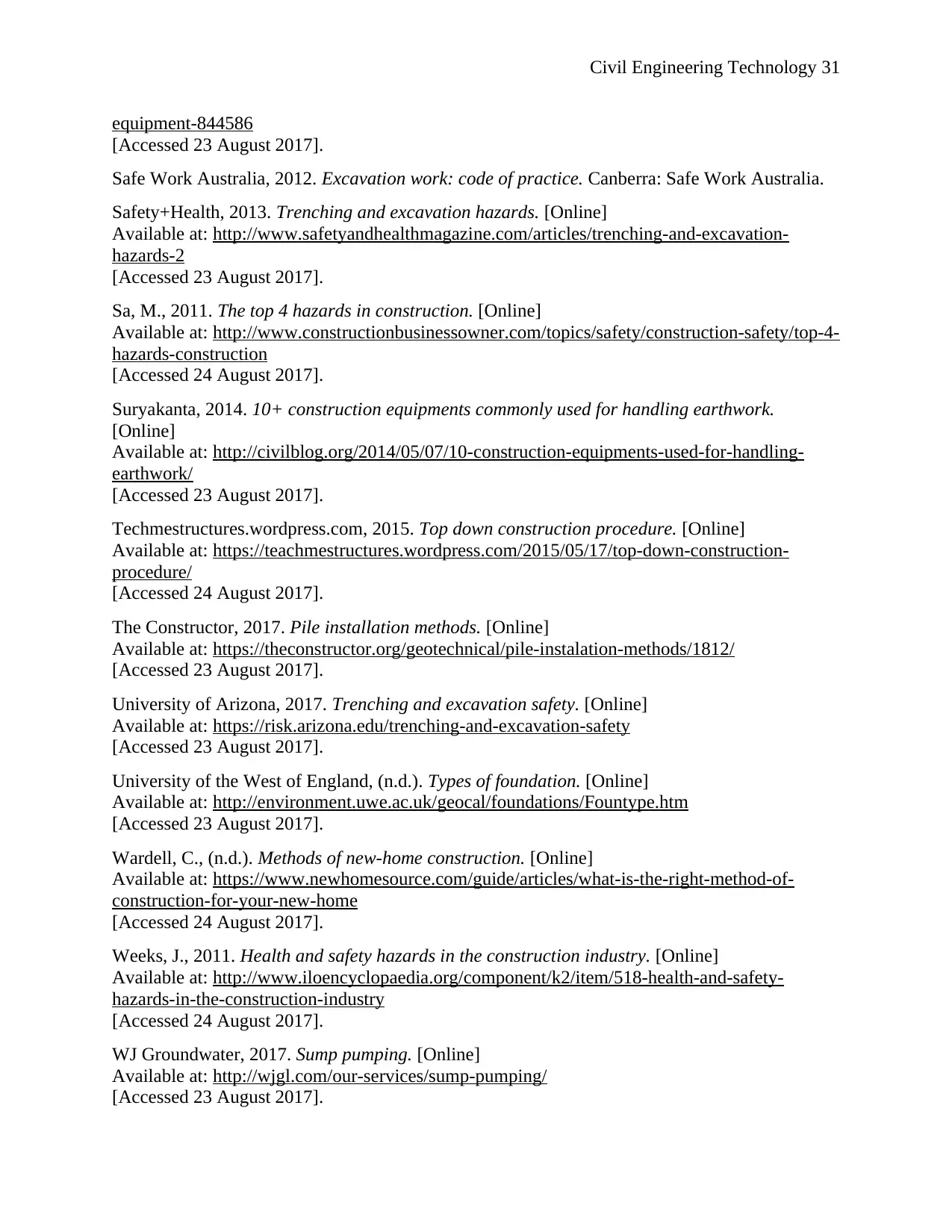
Civil Engineering Technology 31
equipment-844586
[Accessed 23 August 2017].
Safe Work Australia, 2012. Excavation work: code of practice. Canberra: Safe Work Australia.
Safety+Health, 2013. Trenching and excavation hazards. [Online]
Available at: http://www.safetyandhealthmagazine.com/articles/trenching-and-excavation-
hazards-2
[Accessed 23 August 2017].
Sa, M., 2011. The top 4 hazards in construction. [Online]
Available at: http://www.constructionbusinessowner.com/topics/safety/construction-safety/top-4-
hazards-construction
[Accessed 24 August 2017].
Suryakanta, 2014. 10+ construction equipments commonly used for handling earthwork.
[Online]
Available at: http://civilblog.org/2014/05/07/10-construction-equipments-used-for-handling-
earthwork/
[Accessed 23 August 2017].
Techmestructures.wordpress.com, 2015. Top down construction procedure. [Online]
Available at: https://teachmestructures.wordpress.com/2015/05/17/top-down-construction-
procedure/
[Accessed 24 August 2017].
The Constructor, 2017. Pile installation methods. [Online]
Available at: https://theconstructor.org/geotechnical/pile-instalation-methods/1812/
[Accessed 23 August 2017].
University of Arizona, 2017. Trenching and excavation safety. [Online]
Available at: https://risk.arizona.edu/trenching-and-excavation-safety
[Accessed 23 August 2017].
University of the West of England, (n.d.). Types of foundation. [Online]
Available at: http://environment.uwe.ac.uk/geocal/foundations/Fountype.htm
[Accessed 23 August 2017].
Wardell, C., (n.d.). Methods of new-home construction. [Online]
Available at: https://www.newhomesource.com/guide/articles/what-is-the-right-method-of-
construction-for-your-new-home
[Accessed 24 August 2017].
Weeks, J., 2011. Health and safety hazards in the construction industry. [Online]
Available at: http://www.iloencyclopaedia.org/component/k2/item/518-health-and-safety-
hazards-in-the-construction-industry
[Accessed 24 August 2017].
WJ Groundwater, 2017. Sump pumping. [Online]
Available at: http://wjgl.com/our-services/sump-pumping/
[Accessed 23 August 2017].
equipment-844586
[Accessed 23 August 2017].
Safe Work Australia, 2012. Excavation work: code of practice. Canberra: Safe Work Australia.
Safety+Health, 2013. Trenching and excavation hazards. [Online]
Available at: http://www.safetyandhealthmagazine.com/articles/trenching-and-excavation-
hazards-2
[Accessed 23 August 2017].
Sa, M., 2011. The top 4 hazards in construction. [Online]
Available at: http://www.constructionbusinessowner.com/topics/safety/construction-safety/top-4-
hazards-construction
[Accessed 24 August 2017].
Suryakanta, 2014. 10+ construction equipments commonly used for handling earthwork.
[Online]
Available at: http://civilblog.org/2014/05/07/10-construction-equipments-used-for-handling-
earthwork/
[Accessed 23 August 2017].
Techmestructures.wordpress.com, 2015. Top down construction procedure. [Online]
Available at: https://teachmestructures.wordpress.com/2015/05/17/top-down-construction-
procedure/
[Accessed 24 August 2017].
The Constructor, 2017. Pile installation methods. [Online]
Available at: https://theconstructor.org/geotechnical/pile-instalation-methods/1812/
[Accessed 23 August 2017].
University of Arizona, 2017. Trenching and excavation safety. [Online]
Available at: https://risk.arizona.edu/trenching-and-excavation-safety
[Accessed 23 August 2017].
University of the West of England, (n.d.). Types of foundation. [Online]
Available at: http://environment.uwe.ac.uk/geocal/foundations/Fountype.htm
[Accessed 23 August 2017].
Wardell, C., (n.d.). Methods of new-home construction. [Online]
Available at: https://www.newhomesource.com/guide/articles/what-is-the-right-method-of-
construction-for-your-new-home
[Accessed 24 August 2017].
Weeks, J., 2011. Health and safety hazards in the construction industry. [Online]
Available at: http://www.iloencyclopaedia.org/component/k2/item/518-health-and-safety-
hazards-in-the-construction-industry
[Accessed 24 August 2017].
WJ Groundwater, 2017. Sump pumping. [Online]
Available at: http://wjgl.com/our-services/sump-pumping/
[Accessed 23 August 2017].
Paraphrase This Document
Need a fresh take? Get an instant paraphrase of this document with our AI Paraphraser
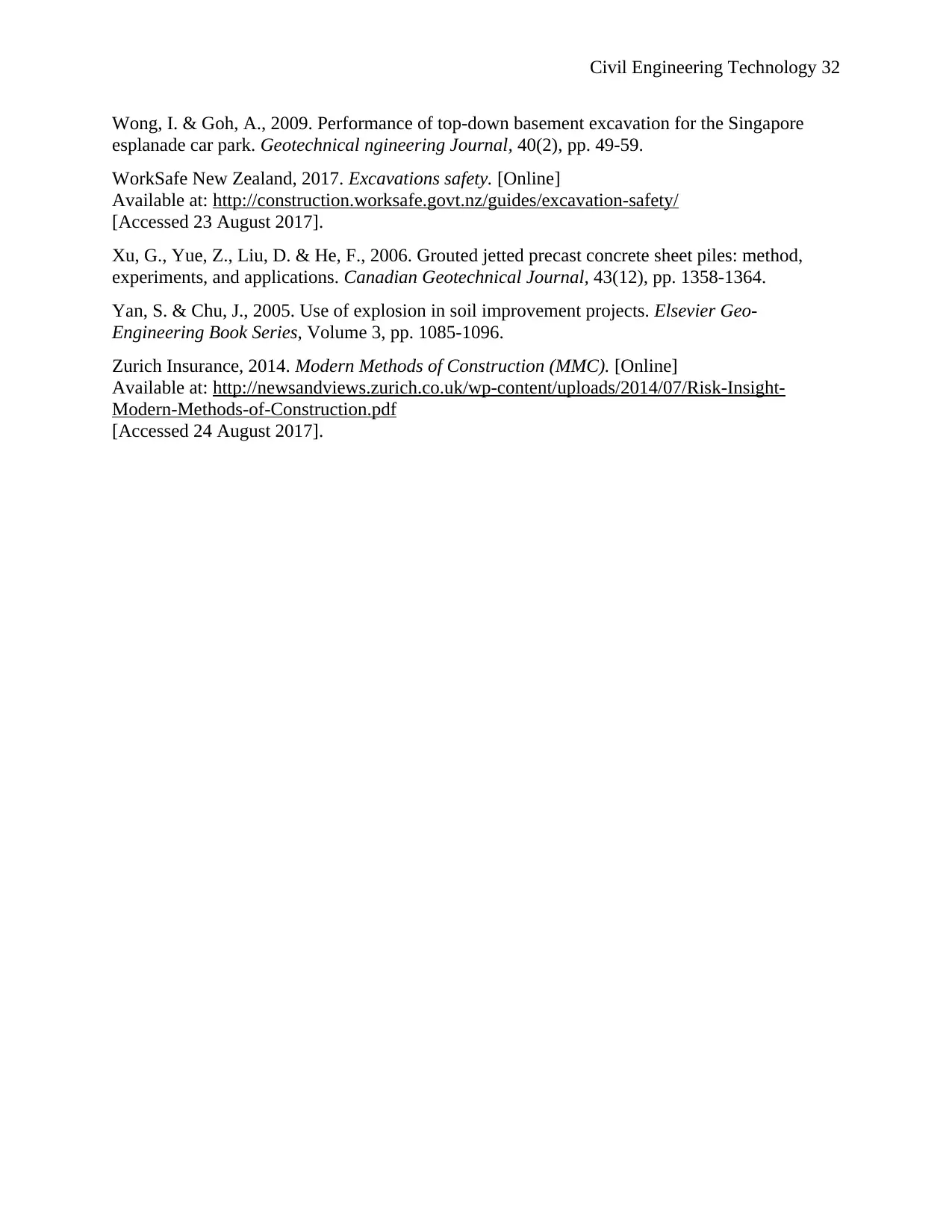
Civil Engineering Technology 32
Wong, I. & Goh, A., 2009. Performance of top-down basement excavation for the Singapore
esplanade car park. Geotechnical ngineering Journal, 40(2), pp. 49-59.
WorkSafe New Zealand, 2017. Excavations safety. [Online]
Available at: http://construction.worksafe.govt.nz/guides/excavation-safety/
[Accessed 23 August 2017].
Xu, G., Yue, Z., Liu, D. & He, F., 2006. Grouted jetted precast concrete sheet piles: method,
experiments, and applications. Canadian Geotechnical Journal, 43(12), pp. 1358-1364.
Yan, S. & Chu, J., 2005. Use of explosion in soil improvement projects. Elsevier Geo-
Engineering Book Series, Volume 3, pp. 1085-1096.
Zurich Insurance, 2014. Modern Methods of Construction (MMC). [Online]
Available at: http://newsandviews.zurich.co.uk/wp-content/uploads/2014/07/Risk-Insight-
Modern-Methods-of-Construction.pdf
[Accessed 24 August 2017].
Wong, I. & Goh, A., 2009. Performance of top-down basement excavation for the Singapore
esplanade car park. Geotechnical ngineering Journal, 40(2), pp. 49-59.
WorkSafe New Zealand, 2017. Excavations safety. [Online]
Available at: http://construction.worksafe.govt.nz/guides/excavation-safety/
[Accessed 23 August 2017].
Xu, G., Yue, Z., Liu, D. & He, F., 2006. Grouted jetted precast concrete sheet piles: method,
experiments, and applications. Canadian Geotechnical Journal, 43(12), pp. 1358-1364.
Yan, S. & Chu, J., 2005. Use of explosion in soil improvement projects. Elsevier Geo-
Engineering Book Series, Volume 3, pp. 1085-1096.
Zurich Insurance, 2014. Modern Methods of Construction (MMC). [Online]
Available at: http://newsandviews.zurich.co.uk/wp-content/uploads/2014/07/Risk-Insight-
Modern-Methods-of-Construction.pdf
[Accessed 24 August 2017].
1 out of 32
Related Documents
Your All-in-One AI-Powered Toolkit for Academic Success.
+13062052269
info@desklib.com
Available 24*7 on WhatsApp / Email
![[object Object]](/_next/static/media/star-bottom.7253800d.svg)
Unlock your academic potential
© 2024 | Zucol Services PVT LTD | All rights reserved.





